Forums
- Forums
- Axis And Allies Forum
- General Discussion
- Aviation News
Aviation News
Post a reply
- Go to Previous topic
- Go to Next topic
- Go to Welcome
- Go to Introduce Yourself
- Go to General Discussion
- Go to Screenshots, Images and Videos
- Go to Off topic
- Go to Works in Progress
- Go to Skinning Tips / Tutorials
- Go to Skin Requests
- Go to IJAAF Library
- Go to Luftwaffe Library
- Go to RAF Library
- Go to USAAF / USN Library
- Go to Misc Library
- Go to The Ops Room
- Go to Made in Germany
- Go to Campaigns and Missions
- Go to Works in Progress
- Go to Juri's Air-Raid Shelter
- Go to Campaigns and Missions
- Go to Works in Progress
- Go to Skinpacks
- Go to External Projects Discussion
- Go to Books & Resources
-
 Main AdminTYNDALL AIR FORCE BASE, Fla. (AFNS) --
Main AdminTYNDALL AIR FORCE BASE, Fla. (AFNS) --
The 325th Fighter Wing is approaching the conclusion of Combat Archer 19-8 that was conducted in conjunction with the on-going Checkered Flag 19-1 exercise at Tyndall Air Force Base, May 6-17.
The Combat Archer exercise, also known as the Weapons Systems Evaluation Program, is the Department of Defense?s largest air-to-air live-fire evaluation exercise. Squadron leaders monitor the lifespan of a missile to assess execution performance by maintenance crew members, aircraft armament systems members and aircrew members.
?Combat Archer is readiness,? said Lt. Col. Vaimana Conner, 83rd Fighter Weapons Squadron commander. ?In addition to providing confidence to senior leaders, it also ensures both the operations and maintenance crews are ready to employ in combat in an air-to-air environment.?
Exercise participants from across the Air Force, to include members from the 494th Fighter Squadron, 67th FS and the 94th FS, employed variations of live air-intercept missiles against unmanned aerial targets that were remotely operated by the 82nd Aerial Target Squadron. The aircrew battled against the simulated threats over the Gulf of Mexico.
While Combat Archer 19-8 is an extensive exercise on its own, Tyndall AFB leaders combined the operation with Checkered Flag 19-1 because of their complementary objectives that focus on air-to-air conflict.
?There is a lot of synergy with the two exercises, but they are two separate exercises with their own objectives,? Conner explained. ?In addition to evaluating the systems during Combat Archer, this was also an opportunity for the squadrons to practice and train for something they can?t do anywhere else.?
According to Conner, more than 40 aircraft and 800 personnel participated in the exercises, making it the largest training operation since Hurricane Michael.
?This exercise is all about readiness,? Conner said. ?(The Airmen) were definitely well-prepared, especially in this austere environment currently at Tyndall and the challenges that come with operating in a state of recovery. They were able to outstandingly execute their mission.?
(U.S. Air Force photo's by Airman 1st Class Monica Roybal)
A C-5M Super Galaxy takes off during a readiness exercise at Travis Air Force Base, Calif., May 9, 2019. The base conducted a weeklong exercise that evaluated Travis AFB?s readiness and ability to execute and sustain rapid global mobility around the world. (U.S. Air Force photo by Heide Couch)
CAPE GIRARDEAU, Mo. (May 16, 2019) Lt. Cmdr. Brandon Hempler, lead solo pilot assigned to the U.S. Navy flight demonstration squadron, the Blue Angels, practices an inverted maneuver for the 2019 Cape Girardeau Air Festival, May 16, 2019. The team is scheduled to conduct 61 flight demonstrations at 32 locations across the country to showcase the pride and professionalism of the U.S. Navy and Marine Corps to the American public in 2019. (U.S. Navy photo by Mass Communication Specialist 1st Class Chris Williamson/Released)
Andrew Mckenna Air Force Heritage Flight Foundation P-51 briefs his backseat flyer before takeoff during a Heritage Flight syllabus sortie at Joint Base Langley-Eustis, Virginia, May 17, 2019. Air Combat Command pilots must complete rigorous training and receive certification from four levels of United States Air Force leadership before they can earn the title of Demonstration Team Commander. (U.S. Air Force Photo's by Tech Sgt. Carlin Leslie)

Jim Beasley and Andrew Mckenna Air Force Heritage Flight Foundation P-51 pilots take off to participate in a Heritage Flight syllabus sortie at Joint Base Langley-Eustis, Virginia, May 17, 2019. Air Combat Command pilots must complete rigorous training and receive certification from four levels of United States Air Force leadership before they can earn the title of Demonstration Team Commander. (U.S. Air Force Photo by Tech Sgt. Carlin Leslie)
U.S. Air Force Maj. Paul Lopez, F-22 Raptor Demonstration Team pilot, flies in a airshow demonstration practice sortie at Joint Base Langley-Eustis, Virginia, May 17, 2019. Air Combat Command pilots must complete rigorous training and receive certification from four levels of United States Air Force leadership before they can earn the title of Demonstration Team Commander.(U.S. Air Force Photo by Tech Sgt. Carlin Leslie)
Jim Beasley, Air Force Heritage Flight Foundation P-51 pilot, and U.S. Air Force Maj. Paul Lopez, F-22 Raptor Demonstration Team pilot, fly during a Flight syllabus sortie at Joint Base Langley-Eustis, Virginia, May 17, 2019. Air Combat Command pilots must complete rigorous training and receive certification from four levels of United States Air Force leadership before they can earn the title of Demonstration Team Commander. (U.S. Air Force Photo by Senior Airman Tristan Biese)
U.S. Air Force Maj. Paul Lopez, F-22 Raptor Demonstration Team pilot, flies in a airshow demonstration practice sortie at Joint Base Langley-Eustis, Virginia, May 17, 2019. Air Combat Command pilots must complete rigorous training and receive certification from four levels of United States Air Force leadership before they can earn the title of Demonstration Team Commander. (U.S. Air Force Photo by Senior Airman Tristan Biese)
WEST PALM BEACH, Fla., May, 17, 2019 /PRNewswire/ -- The Sikorsky HH-60W Combat Rescue Helicopter achieved first flight today at Sikorsky's West Palm Beach, Florida site, an important step toward bringing this all-new aircraft to service members to perform critical search and rescue operations. The aircraft, developed by Sikorsky, a Lockheed Martin Company (NYSE: LMT) and based on the proven UH-60M Black Hawk, is customized for the U.S. Air Force 's rescue mission and will ensure the Air Force fulfills its mission to leave no one behind.
Total flight time was approximately 1.2 hours and included hover control checks, low speed flight, and a pass of the airfield.
"This achievement is yet another vital step toward a low rate initial production decision and getting this much-needed aircraft and its advanced capabilities to the warfighter," said Dana Fiatarone, vice president, Sikorsky Army & Air Force Systems. "We are very pleased with the results of today's flight and look forward to a productive and informative flight test program."
Today's flight paves the way for a Milestone C production decision in September 2019, per the original baseline schedule, to which both Sikorsky and the Air Force are committed. A second HH-60W helicopter is expected to enter flight test next week, with a third and fourth aircraft entering flight test this summer. These aircraft will provide critical data over the course of the program which will enable the Air Force to make an informed production decision.
"The HH-60W's first flight is the culmination of significant development and design advances. We are excited to now move forward to begin full aircraft system qualification via the flight test program," said Greg Hames, director of the Combat Rescue Helicopter program. "Together with the Air Force, our team is motivated and committed to advancing this program and delivering this superior aircraft to our airmen and women."
The HH-60W Combat Rescue Helicopter is significantly more capable and reliable than its predecessor, the HH-60G Pave Hawk. The aircraft hosts a new fuel system that nearly doubles the capacity of the internal tank on a UH-60M Black Hawk, giving the Air Force crew extended range and more capability to rescue those injured in the battle space. The HH-60W specification drives more capable defensive systems, vulnerability reduction, weapons, cyber-security, environmental, and net-centric requirements than currently held by the HH-60G.
"With the Combat Rescue Helicopter's successful first flight now behind us, we look forward to completion of Sikorsky's flight test program, operational testing and production of this aircraft to support the Air Force's critical rescue mission," said Edward Stanhouse, Chief, U.S. Air Force Helicopter Program Office. "Increased survivability is key and we greatly anticipate the added capabilities this aircraft will provide."
The U.S. Air Force program of record calls for 113 helicopters to replace the Pave Hawks, which perform critical combat search and rescue and personnel recovery operations for all U.S. military services. A total of nine aircraft will be built at Sikorsky's Stratford, Connecticut, facility during the Engineering & Manufacturing Development (EMD) phase of the program ? four EMD aircraft and five System Demonstration Test Articles (SDTA).
For more information, visit www.lockheedmartin.com/crh.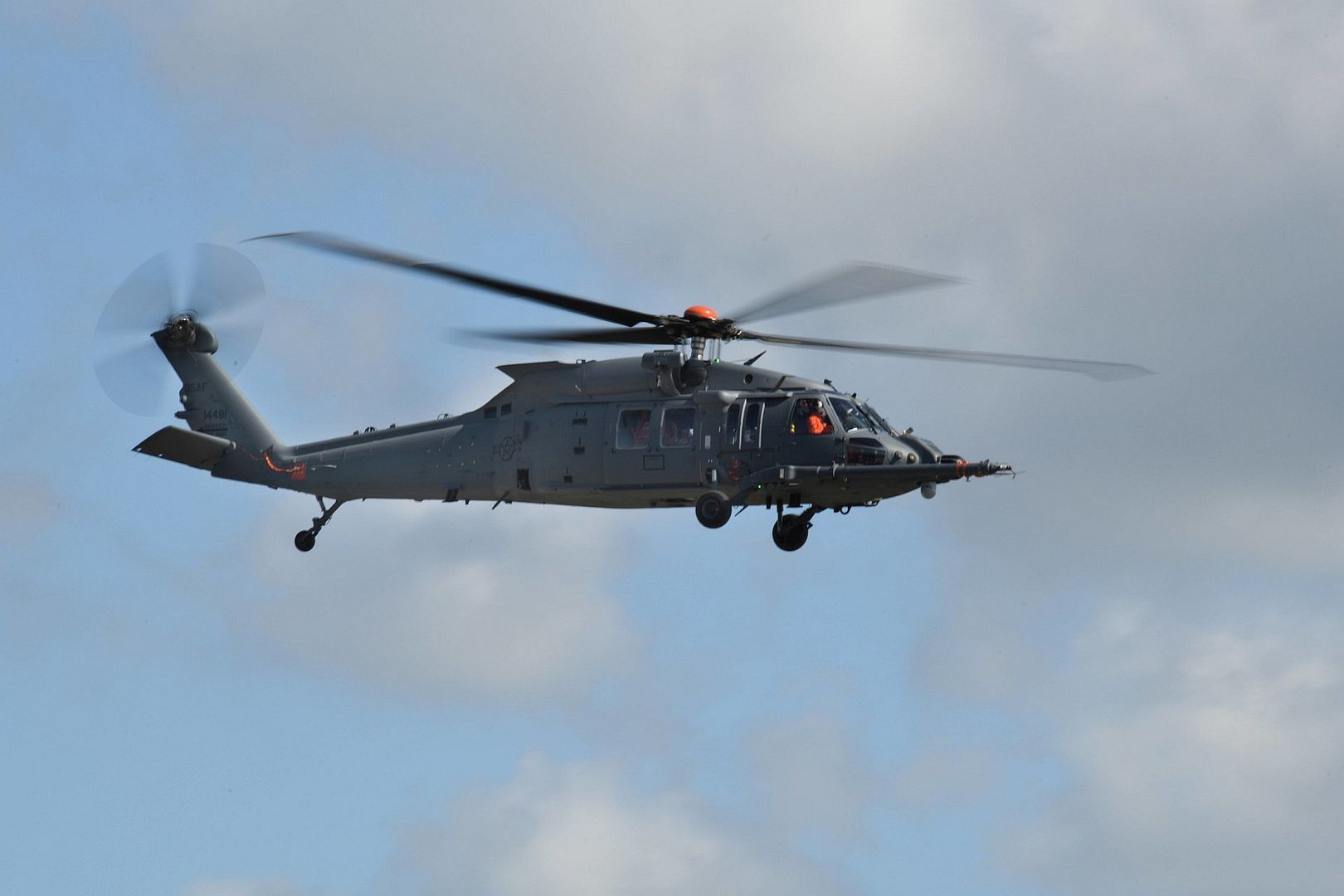
The first A350-900 for Japan Airlines (JAL) has successfully completed its maiden flight in Toulouse, France. The A350-900 is the first aircraft to be produced by Airbus for the airline and features a special A350 logo on the fuselage.
The aircraft will now enter the final phase of production, including cabin completion, as well as further ground and flight tests leading to customer acceptance and delivery.
Altogether JAL has ordered 31 A350 XWB aircraft, comprising 18 A350-900s and 13 A350-1000s. The A350-900 will initially be operated by JAL on major domestic routes, with a three-class configuration seating 369 passengers.
The A350 XWB is the world?s most modern and eco-efficient aircraft family shaping the future of air travel. It is the long-range leader in the large widebody market (300 to 400+ seats). The A350 XWB brings a 25% reduction in fuel burn and emissions and features the Airspace by Airbus cabin for the most comfortable flying experience.
At the end of April 2019, the A350 XWB Family had received 893 firm orders from 51 customers worldwide, making it one of the most successful widebody aircraft ever.
@JAL_Official_jp #A350 #Airbus
Melbourne, Florida, May 17, 2019 ? Embraer?s new Praetor 600 super-midsize business jet has completed its first transatlantic crossing, powered by Sustainable Alternative Jet Fuel (SAJF). The aircraft arrived yesterday in Farnborough, having departed from Teterboro Airport in the U.S. The first transatlantic flight of the Praetor 600 covered about 3,000 nautical miles with about 15,000 lb of fuel, of which 3,000 lb was SAJF.
Embraer will debut its new Praetor business jets at the European Business Aviation Conference and Exhibition (EBACE) in Geneva, Switzerland, from May 21 to May 23. The new midsize Praetor 500 and super-midsize Praetor 600 business jets were launched in October 2018.
On static display at this year?s EBACE will be the entry-level Phenom 100EV, the Phenom 300E light jet, the midsize Praetor 500, the super-midsize Praetor 600, the large Legacy 650E and the ultra-large Lineage 1000E. All aircraft will arrive at EBACE fueled with SAJF.
Prior to arrival at EBACE, Embraer will participate at a business aviation biofuel event to be held at Farnborough Airport on May 18. This event will mark the first anniversary of the launch of the Business Aviation Coalition for Sustainable Alternative Jet Fuel (SAJF), at EBACE 2018, and the 10th anniversary of the Business Aviation Commitment on Climate Change, announced in 2009.
The ?Fueling the Future? event will gather business aviation and civic leaders to discuss the path forward for the continued adoption of SAJF in business aviation, in order to fulfill the coalition?s goal of reducing emissions through investments and innovation. Several manufacturer?s business aircraft will be fueled with SAJF before departing to EBACE.
On May 8, the Praetor 600 began its journey to EBACE at S?o Paulo International Airport in Brazil and arrived in Fort Lauderdale, Florida with a six-passenger equivalent payload of 1,200 lb (544 kg). This was the aircraft?s longest flight to date, covering 3,904 nm (7,230 kilometers) over an air distance of 3,678 nm (6,812 kilometers), having faced up to 43 knots of headwinds and descended into Miami?s distinct air space pattern.
The Praetor 600 is the best performing super-midsize jet ever developed, surpassing all its main design goals and becoming capable of flying beyond 4,000 nautical miles in long-range cruise speed or beyond 3,700 nautical miles at Mach .80 from runways shorter than 4,500ft, complemented by an outstanding payload capability.
The Praetor 600 is the first super-midsize jet with full fly-by-wire technology, which powers the Active Turbulence Reduction that not only makes every flight the smoothest but also the most efficient possible.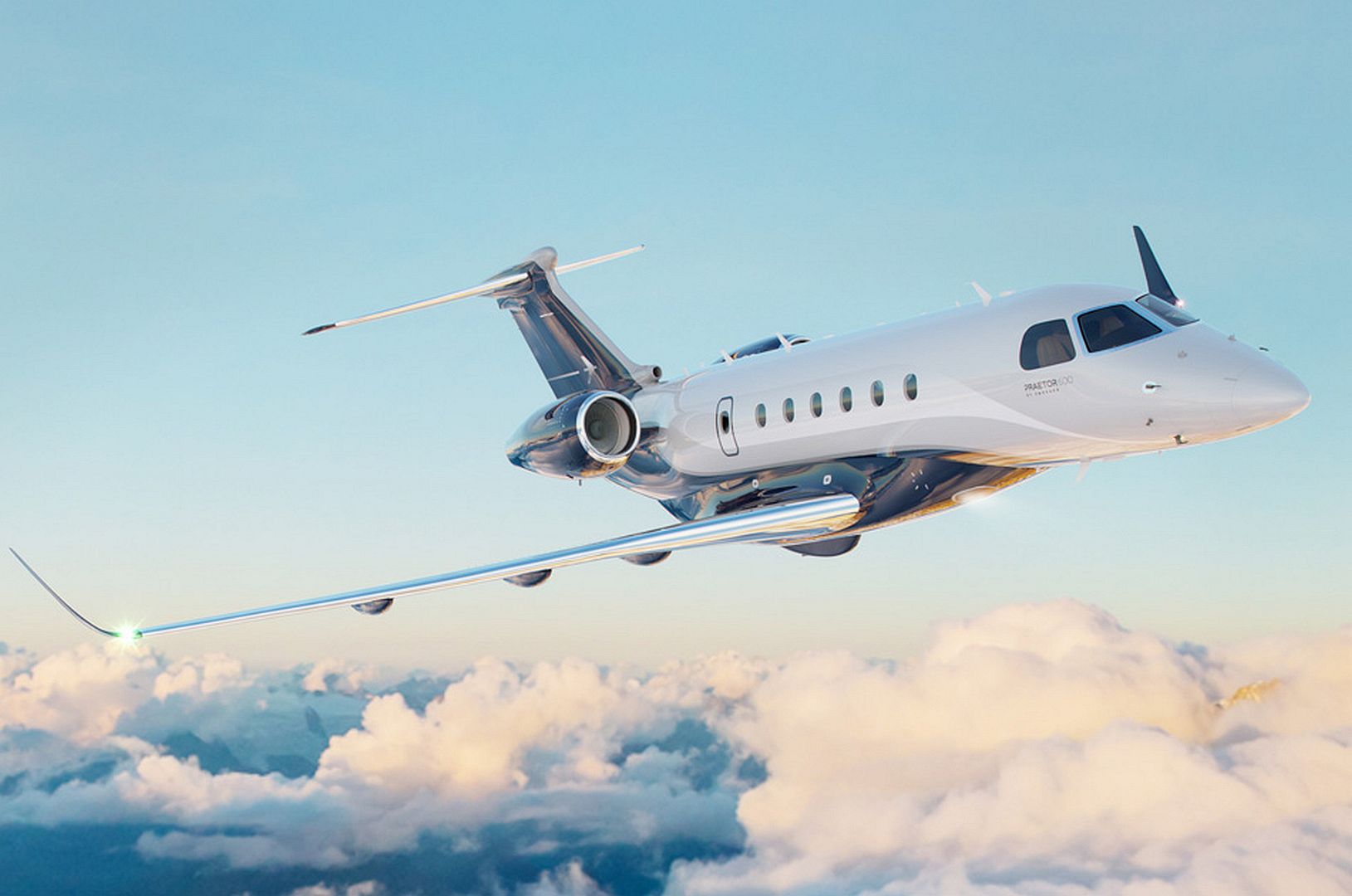
-
 Main AdminARABIAN SEA (May 18, 2019) AV-8B Harriers return to the flight deck of the Wasp-class amphibious assault ship USS Kearsarge (LHD 3) after participating in an exercise with F/A-18E Super Hornets embarked aboard the Nimitz-class aircraft carrier USS Abraham Lincoln (CVN 72). The Abraham Lincoln Carrier Strike Group (ABECSG) and Kearsarge Amphibious Ready Group (KSGARG) are conducting joint operations in the U.S. 5th Fleet area of operations. The ABECSG and KSGARG, with the 22nd Marine Expeditionary Unit, are prepared to respond to contingencies and to defend U.S. forces and interests in the region. (U.S. Navy photo by Mass Communication Specialist 2nd Class Megan Anuci/Released)
Main AdminARABIAN SEA (May 18, 2019) AV-8B Harriers return to the flight deck of the Wasp-class amphibious assault ship USS Kearsarge (LHD 3) after participating in an exercise with F/A-18E Super Hornets embarked aboard the Nimitz-class aircraft carrier USS Abraham Lincoln (CVN 72). The Abraham Lincoln Carrier Strike Group (ABECSG) and Kearsarge Amphibious Ready Group (KSGARG) are conducting joint operations in the U.S. 5th Fleet area of operations. The ABECSG and KSGARG, with the 22nd Marine Expeditionary Unit, are prepared to respond to contingencies and to defend U.S. forces and interests in the region. (U.S. Navy photo by Mass Communication Specialist 2nd Class Megan Anuci/Released)
Tora Tora Tora performs during the Defenders of Liberty Air & Space Show at Barksdale Air Force Base, La., May 18, 2019. Tora Tora Tora is a commemorative recreation of the Japanese Attack on Pearl Harbor that signaled the beginning of the American involvement in World War II. Designed as a living history lesson, Tora Tora Tora is intended as a memorial to all the service members on both sides who gave their lives for their countries. (U.S. Air Force photo's by Senior Airman Tessa B. Corrick)


A Bell P-63 Kingcobra taxis down the flightline during the Defenders of Liberty Air & Space Show at Barksdale Air Force Base, La., May 19, 2019. The airshow was first held in 1933 and is a full weekend of military and civilian aircraft and performances and displays. (U.S. Air Force photo by Senior Airman Stuart Bright)
Royal Canadian Air Force CT-114 Tutor pilots with the Canadian Forces Snowbirds 431st Air Demonstration Squadron, perform pre-flight demonstrations during the Defenders of Liberty Air & Space Show at Barksdale Air Force Base, La., May 19, 2019. Serving as ambassadors of the CAF, the CF Snowbirds demonstrate a high level of skill, professionalism, teamwork, discipline and dedication inherent in the men and women of the CAF. (U.S. Air Force photo by Airman Jacob B. Wrightsman)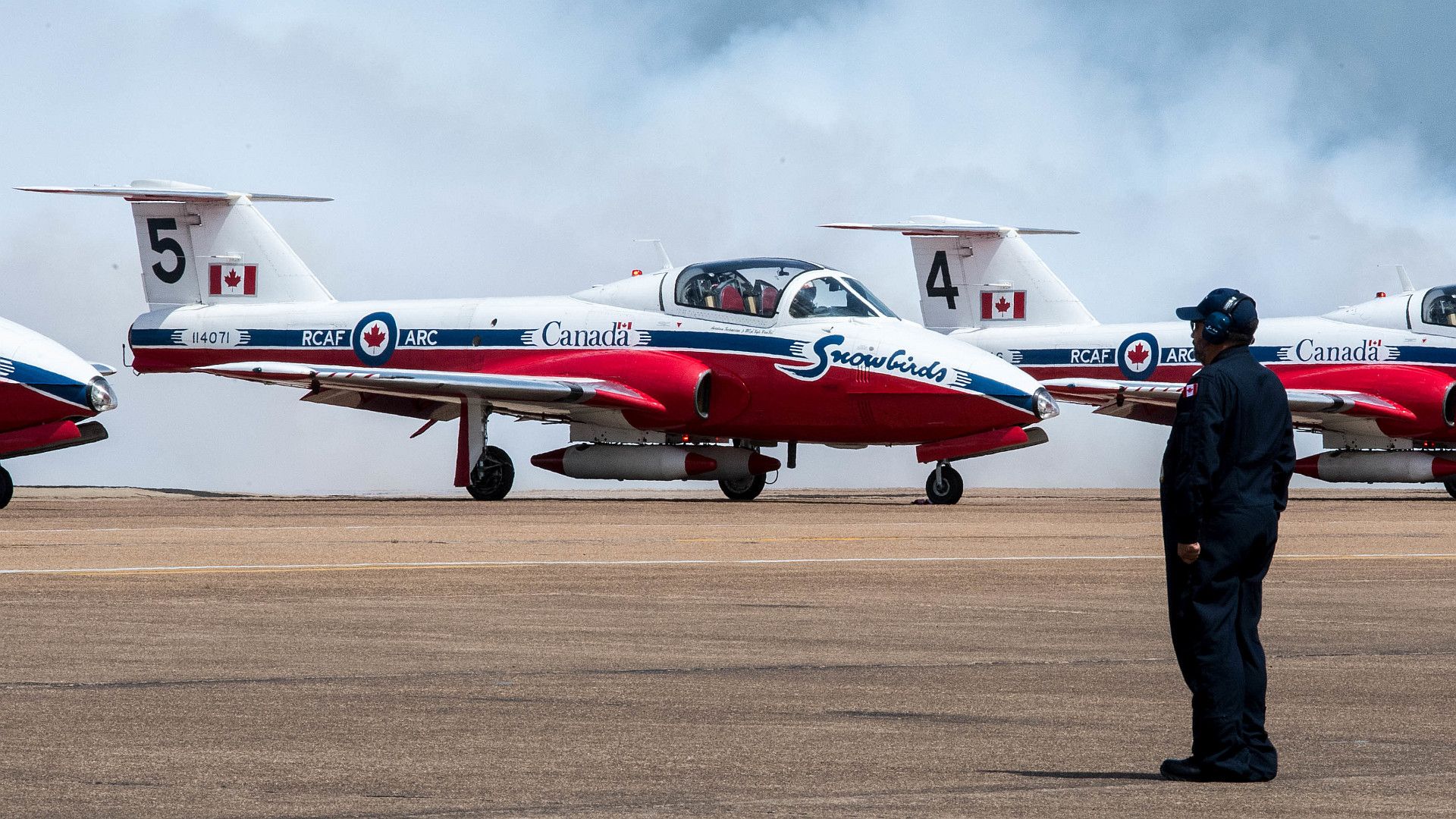
Capt. Andrew ?Dojo? Olson, F-35 Demonstration Team pilot and commander performs a dedication pass in an F-35A Lightning II during the Defenders of Liberty Air & Space Show at Barksdale Air Force Base, La., May 18, 2019. The 13-minute performance features 14 aerobatic maneuvers that fully showcase the capabilities of the F-35. (U.S. Air Force Photo by Senior Airman Alexander Cook)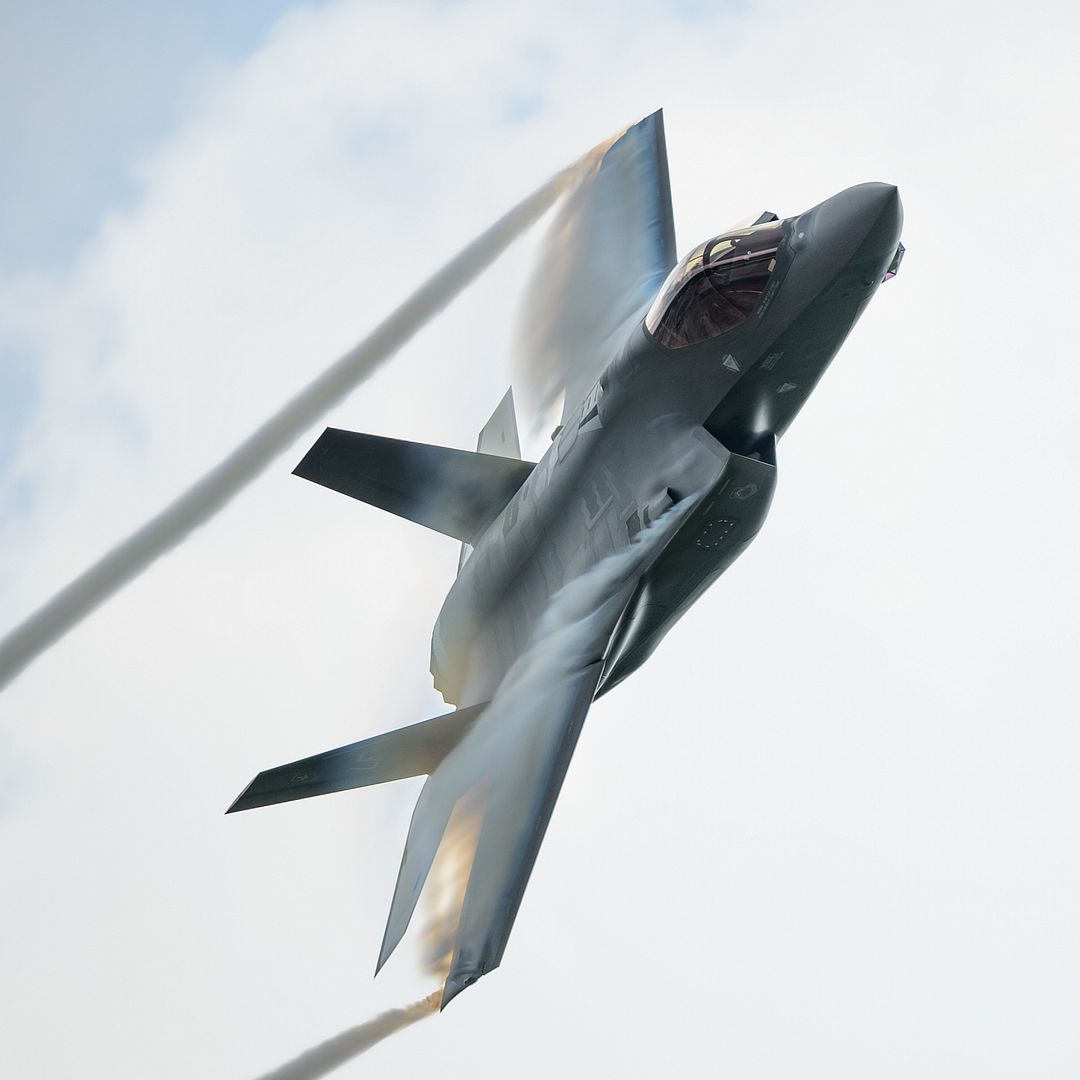
An F-16C Fighting Falcon assigned to the 93rd Fighter Squadron, Homestead Air Reserve Base, Fla., takes off at Royal Air Force Lakenheath, England, May 21, 2019. The unit's deployment to RAF Lakenheath demonstrates the U.S. Air Force's ability to integrate a total force team into U.S. Air Forces in Europe-Air Forces Africa training and operations. (U.S. Air Force photo by Airman 1st Class Madeline Herzog)
Two U.S. Air Force F-16C Fighting Falcons assigned to the 96th Test Wing and 53rd Wing, Eglin Air Force Base, Florida, fly alongside a 909th Air Refueling Squadron KC-135R Stratotanker after receiving fuel during Northern Edge, May 16, 2019, over the Gulf of Alaska. Northern Edge provides effective, capabilities-centered joint forces, ready for deployment world-wide and enables real-world proficiency in detection, identification and tracking of units at sea, in the air and on land. (U.S. Air Force photo by Senior Airman Eric M. Fisher)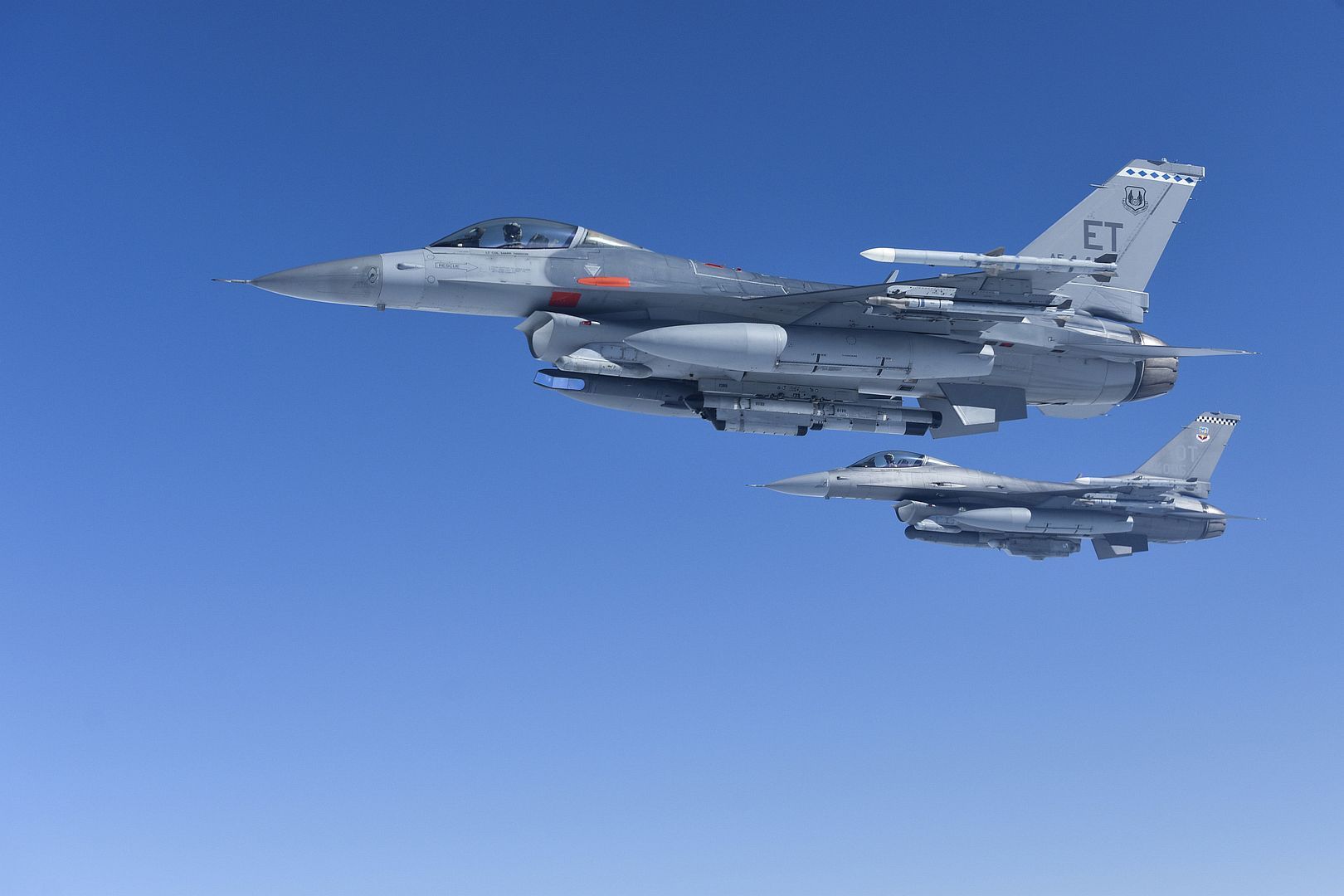
"Wise Guy" Rises Again (old news but cool photo)
A B-52H Stratofortress taxis on the flight line at Davis-Monthan Air Force Base, Ariz., May 14 2019. The B-52H completed phase one of its regeneration process at the 309th Aerospace Maintenance and Regeneration Group. It is scheduled to complete its phase depot maintenance in February of 2021 as a completely restored, fleet configured B-52H. (U.S. Air Force photo by the 355th Wing Public Affairs office)
ARABIAN SEA (May 20, 2019) An E-2D Hawkeye from the "Bluetails" of Carrier Airborne Early Warning Squadron (VAW) 121 lands on the flight deck of the Nimitz-class aircraft carrier USS Abraham Lincoln (CVN 72). Abraham Lincoln Carrier Strike Group (ABECSG) is deployed to the U.S. 5th Fleet area of operations in support of naval operations to ensure maritime stability and security in the Central Region, connecting the Mediterranean and the Pacific through the western Indian Ocean and three strategic choke points. With Abraham Lincoln as the flagship, deployed strike group assets include staffs, ships and aircraft of Carrier Strike Group 12 (CSG 12), Destroyer Squadron 2 (DESRON 2), USS Leyte Gulf (CG 55) and Carrier Air Wing 7 (CVW 7). (U.S. Navy photo by Mass Communication Specialist 3rd Class Jeff Sherman/Released)
ARABIAN SEA (May 20, 2019)
An F/A-18E Super Hornet from "the Fist of the Fleet" of Strike Fighter Squadron (VFA) 25 lands on the flight deck of the Nimitz-class aircraft carrier USS Abraham Lincoln (CVN 72). Abraham Lincoln Carrier Strike Group (ABECSG) is deployed to the U.S. 5th Fleet area of operations in support of naval operations to ensure maritime stability and security in the Central Region, connecting the Mediterranean and the Pacific through the western Indian Ocean and three strategic choke points. With Abraham Lincoln as the flagship, deployed strike group assets include staffs, ships and aircraft of Carrier Strike Group 12 (CSG 12), Destroyer Squadron 2 (DESRON 2), USS Leyte Gulf (CG 55) and Carrier Air Wing 7 (CVW 7). U.S. Navy photo by Mass Communication Specialist 3rd Class Jeff Sherman (Released)
ARABIAN SEA (May 18, 2019) An F/A-18E Super Hornet from the "Jolly Rogers" of Strike Fighter Squadron (VFA-103) flies above the Nimitz-class aircraft carrier USS Abraham Lincoln (CVN 72). Abraham Lincoln Carrier Strike Group (ABECSG) is prepared to respond to contingencies and to defend U.S. forces and interests in the region. With Abraham Lincoln as the flagship, deployed strike group assets include staffs, ships and aircraft of Carrier Strike Group 12 (CSG 12), Destroyer Squadron 2 (DESRON 2), USS Leyte Gulf (CG 55) and Carrier Air Wing 7 (CVW 7). (U.S. Navy photo by Lt. Logan Holshey/Released)
STRATFORD, Conn., May 17, 2019 /PRNewswire/ -- Sikorsky, a Lockheed Martin company (NYSE: LMT) will build 12 production CH-53K King Stallion helicopters under a new $1.13 billion contract from the U.S. Navy. These advanced helicopters are part of the 200 program of record aircraft for the U.S. Marine Corps.
Under the terms of the contract, known as Low Rate Initial Production (LRIP) Lot 2 and 3, Sikorsky will begin deliveries of 12 CH-53K helicopters in 2022, and also provide spares and logistical support. Sikorsky remains committed to continuing to reduce costs over the life of the program.
"I'm proud of the joint government and industry team in achieving this award," said Col. Jack Perrin, U.S. Marine Corps program manager for the Naval Air Systems Command's Heavy Lift Helicopters program, PMA-261.
The CH-53K is the only sea-based, long range, heavy-lift helicopter in production and will immediately provide three times the lift capability of its predecessor. The CH-53K will conduct expeditionary heavy-lift transport of armored vehicles, equipment, and personnel to support distributed operations deep inland from a sea-based center of operations. The new CH-53K will have heavy-lift capabilities that exceed all other DoD rotary wing-platforms and it is the only heavy lifter that will remain in production through 2032 and beyond.
"Sikorsky employees and our nationwide supply chain are ready to ramp up CH-53K production to support deployment of this modern, safe and reliable aircraft in 2023-2024," said Sikorsky Program Director Bill Falk. "This contract demonstrates the U.S. Marine Corps' confidence in Sikorsky to expand production of this technologically advanced heavy lift helicopter."
Lockheed Martin, Sikorsky, and its suppliers have made significant investments in facilities, machinery, tooling, and workforce training to ramp-up production required for the CH-53K program. For example, we have installed more than eight new titanium machining centers, designed and implemented a new final assembly test facility with multi-floor ergonomic work platforms, installed 10-ton cranes, and now have 3D work instructions on the factory floor.
"We have transformed our factory for the future and implemented a model for all future helicopter programs," Falk said. "Additionally, our engineers have implemented the latest technologies such as manufacturing simulation and 3D laser inspection technology. These investments in systems, personnel, and our facilities have elevated Sikorsky's manufacturing technology and capabilities to meet production requirements of the CH-53K for domestic and international customers."
King Stallion Progress Update
The all-new CH-53K, designed to be intelligent, reliable, low maintenance and survivable in the most difficult conditions, has flown more than 1,400 test hours and has met all the outer reaches of the test envelope. The King Stallion is in the midst of a rigorous test program to ensure militaries can safely move troops and equipment at higher altitudes, quicker and more effectively than ever.
The CH-53K, which has proven it can lift more than 36,000 pounds, is the most powerful heavy lift helicopter ever built in the United States. The King Stallion's technologically advanced design will meet the future warfighting requirements for decades to come, enabling missions like humanitarian aid, troop and equipment transport, casualty evacuation (CASEVAC), support of special operations forces, and combat search and rescue (CSAR).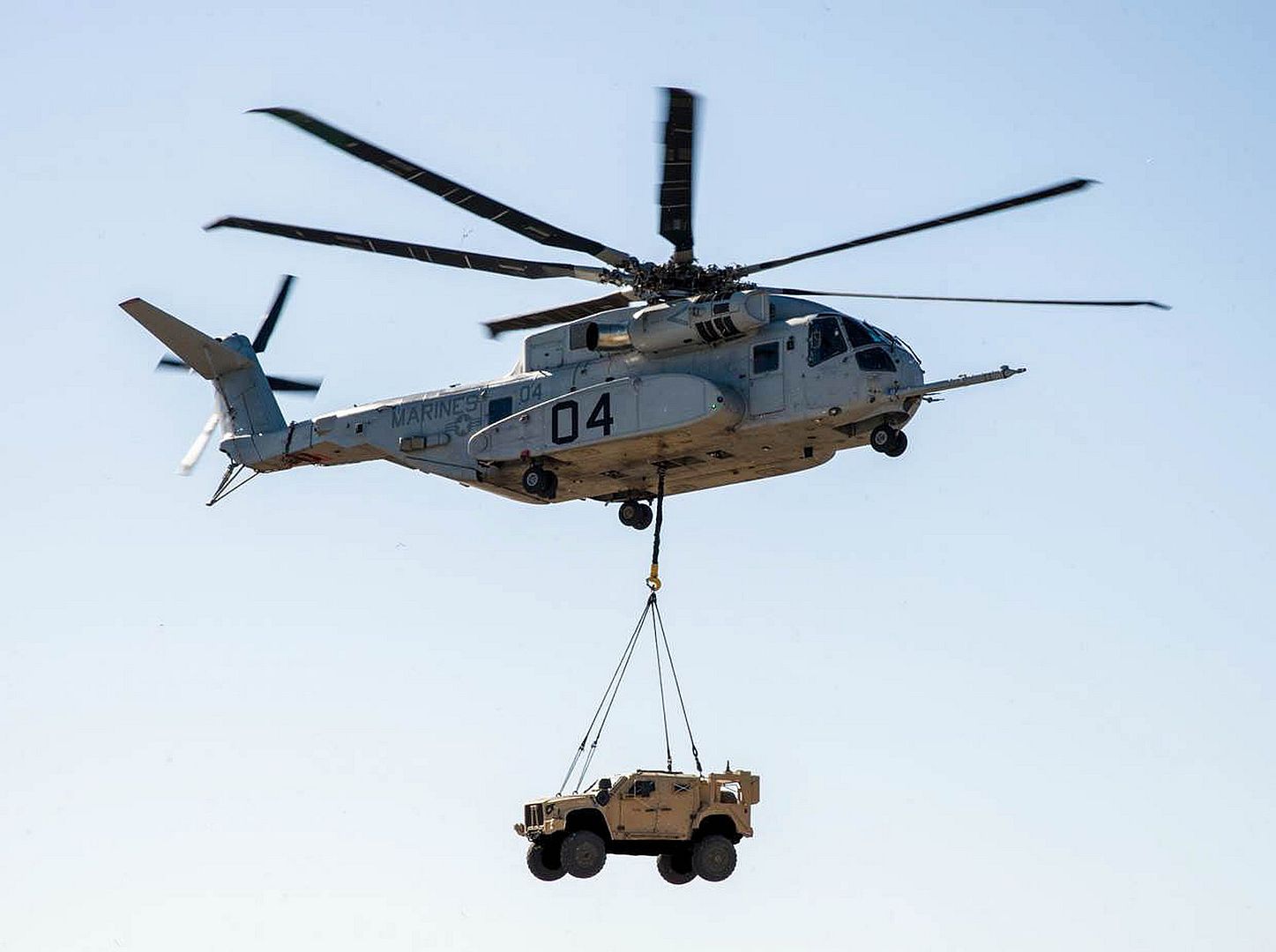
ST. LOUIS, May 17, 2019 ? Boeing [NYSE: BA] has received a one-year contract, which also includes a one-year option for 2020, to continue modernizing the U.S. Navy?s F/A-18 fleet under the Service Life Modification (SLM) program. The $164 million contract for FY19 funds the standup of a second SLM line in San Antonio, Texas, complementary to the line established last year in St. Louis.
?The Service Life Modification program is making great strides as we?ve already inducted seven Super Hornets into the program, and will deliver the first jet back to the Navy later this year,? said Dave Sallenbach, program director. ?This program is crucial in helping the Navy with its readiness challenges, and will continue to grow each year with the number of jets we induct.?
The San Antonio SLM line is scheduled to receive its first Super Hornet in June, and a total of 23 Super Hornets over the course of this contract. The U.S. Navy fleet consists of more than 550 Super Hornets.
The SLM program extends the life of existing Super Hornets from 6,000 to 10,000 flight hours.
In the early 2020s, Boeing is scheduled to begin installing initial updates to the aircraft that will convert existing Block II Super Hornets to a new Block III configuration.
The Block III conversion will include enhanced network capability, longer range with conformal fuel tanks, an advanced cockpit system, signature improvements and an enhanced communication system. The updates are expected to keep the F/A-18 in active service for decades to come.
Geneva, Airbus Corporate Helicopters (ACH) has secured an additional sale for its latest ACH160 helicopter just days before the EBACE 2019 business aviation show in Geneva.
This new order, from an experienced UK helicopter operator which will use it for general corporate purposes, takes the ACH160 orderbook to 11 aircraft of which four have been won in the UK.
Two other ACH160s have been ordered by a privately owned UK company which is also a long-time corporate helicopter user, and a fourth UK aircraft has been ordered by an existing private Airbus Helicopters VIP customer to be managed by Isle of Man-based Luviair.
The H160 medium helicopter programme remains on-track for certification at the end of 2019 to be followed by the first ACH deliveries about one year later.
After recording 54 sales in 2017 following its launch at EBACE in May that year, ACH recorded 68 orders in 2018.
Mirroring sister brand Airbus Corporate Jets (ACJ), ACH provides an exclusive end-to-end ownership experience from first enquiry and ordering, through in-service support, to enhanced resale opportunities.
ACH delivers the highest standards in safety, technology, craftsmanship and service and is backed by HCareFirst ? a premium support service aimed directly at the specific needs of operators typically recording low flight-hours but demanding worry-free aircraft availability when required.
Frederic Lemos, Head of ACH, said: ?This substantial new business for the ACH160 even before certification is clearly demonstrating its very high level of acceptance in the market. These firm orders from highly knowledgeable customers are concrete evidence that the aircraft is addressing the needs of the most demanding operators.?
The full ACH helicopter range consists of the ACH125, ACH130, ACH135, new ACH145, ACH160 and ACH175 variants of Airbus Helicopters? comprehensive and market-leading family of light and medium models. A range of premium-design aircraft completions, including bespoke solutions, is available for all models.
Renowned for its combination of versatility and comfort, the ACH range of helicopters is admired by passengers and pilots alike for its stylish interiors, smooth and quiet ride allied to its technologically advanced Helionix digital avionics system ensuring carefree handling and the highest level of safety.
About Airbus
Airbus is a global leader in aeronautics, space and related services. In 2018, it generated revenues of ?64 billion and employed a workforce of around 134,000. Airbus offers the most comprehensive range of passenger airliners. Airbus is also a European leader providing tanker, combat, transport and mission aircraft, as well as one of the world?s leading space companies. In helicopters, Airbus provides the most efficient civil and military rotorcraft solutions worldwide.
Airbus celebrated the delivery of its 12,000th aircraft ever in its 50-year history. The aircraft was an A220-100, assembled in Mirabel, Canada and handed over to U.S.-based Delta Air Lines.
The aircraft is the 12th A220 delivered to date to Delta Air Lines since the carrier received its first A220 in October 2018. The A220 started scheduled service with Delta in February 2019. Delta is the first U.S. airline to operate the A220 and is the largest A220 customer, with a firm order for 90 aircraft.
This milestone delivery of a Canadian-made Airbus aircraft to a U.S.-based airline highlights the growing presence of Airbus in North America. Since Airbus? leadership of the A220 programme became effective on 1 July 2018, ground was broken in January this year in Mobile, Alabama for the construction of a second A220 final assembly line, set to start deliveries to U.S. customers in 2020.
Airbus delivered its first aircraft, an A300B2 to Air France, back in 1974. Fast forward to 2010, Airbus handed over its 6,000th aircraft, 36 years after its first. The pace continued to accelerate, taking Airbus just nine years to double that number, reaching 12,000th Airbus aircraft delivery on May 20, 2019.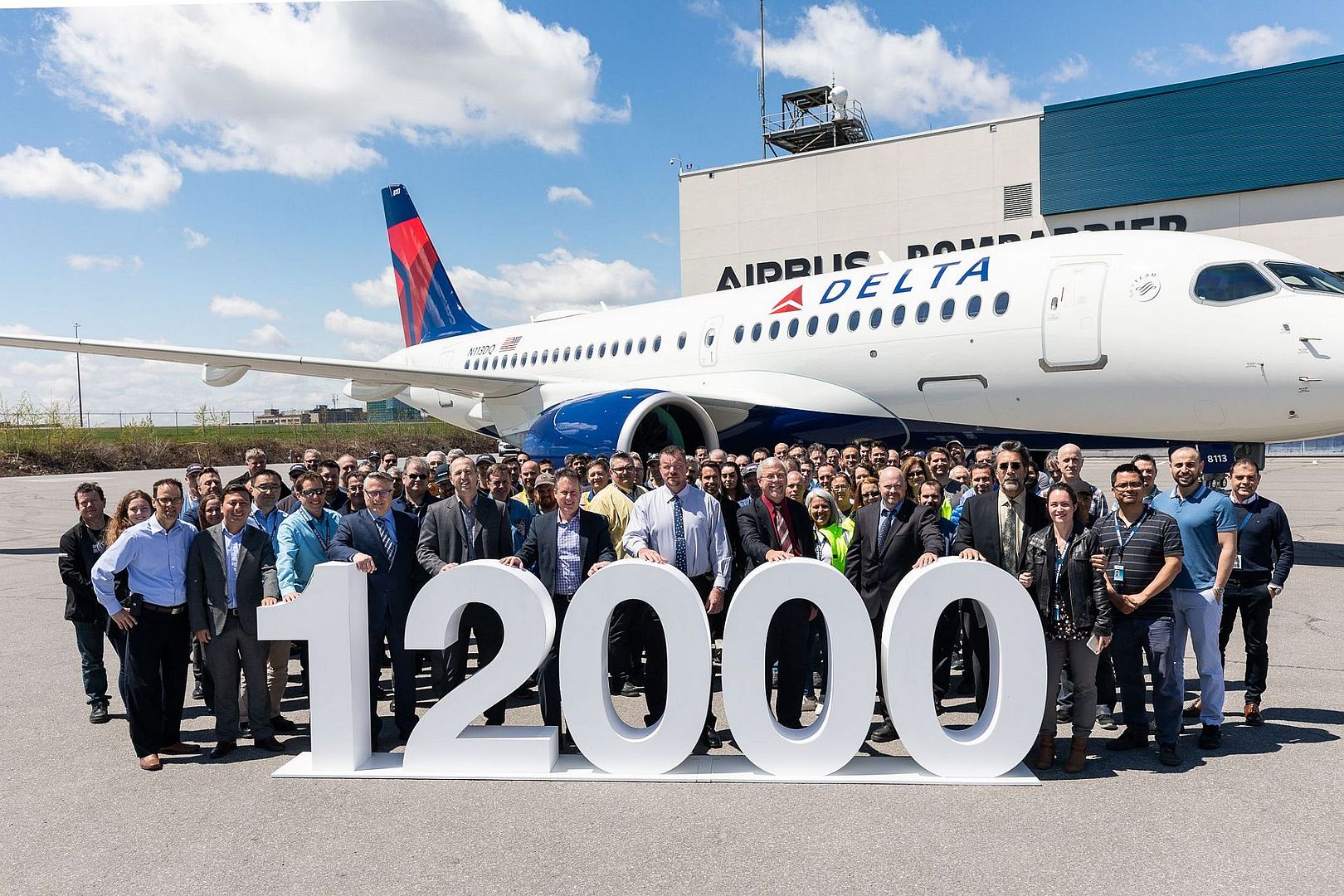
The Royal Air Force?s newest fighter left its home base for Cyprus today to take part in its first overseas training exercise following introduction. This follows the announcement of their deployment to RAF Akrotiri in April 2019.
Several F-35B Lightning aircraft from 617 Squadron, ?The Dambusters,? flew from their base at RAF Marham in Norfolk to spend six weeks at RAF Akrotiri as part of Exercise Lightning Dawn.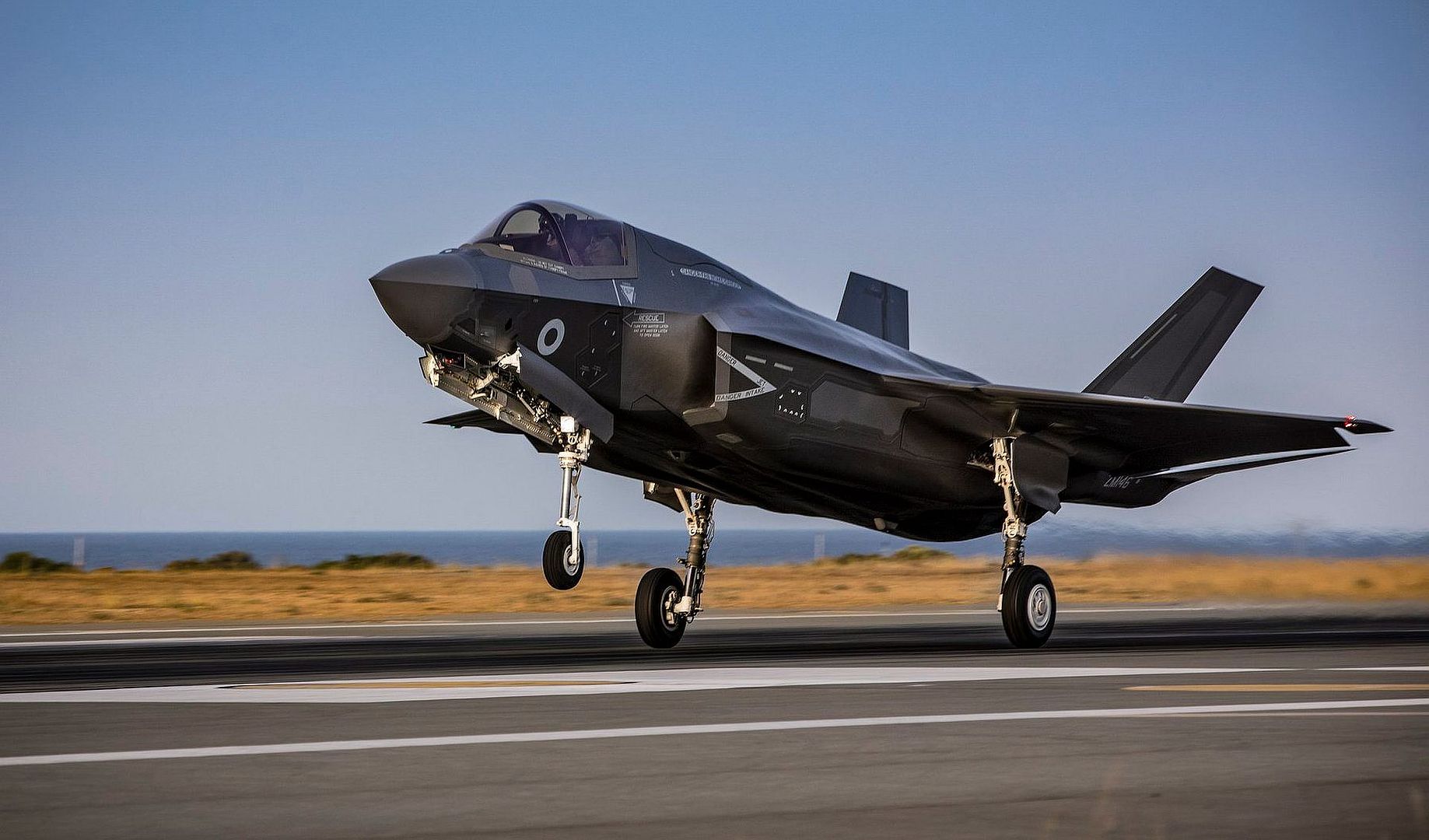
RAF Marham Station Commander, Group Captain Townsend said: ?It?s just over 76 years since 617 Squadron formed to conduct ground-breaking operations, they are once again called upon to take a capability forwards for the first time. The exercise in Akrotiri will prove our ability to operate F-35 away from RAF Marham and allow us to learn the lessons of operating the air system whilst on deployment.
?Today?s departure reflects a tremendously collegiate effort from the RAF, Royal Navy and industrial partners who are now focused on ensuring the deployment is as successful as the preparation phase.?
Owned and operated by the RAF, the Lightning Force is jointly manned by both the Royal Air Force and the Royal Navy. This training exercise will allow personnel from both services to gain vital experience in maintaining and flying the aircraft in an unfamiliar environment.
The exercise will also examine all aspects of moving this aircraft to a new location, including logistics, maintenance, and sustainment of all the equipment and crew that comes with this impressive aircraft, whilst also enhancing its preparedness for its first operational carrier deployment.
Station Commander RAF Akrotiri, Group Captain Christopher Snaith, said: ?It is a privilege to welcome 617 Squadron and the F-35B Lightning aircraft to RAF Akrotiri. This is the first overseas training deployment of the aircraft and marks another key milestone for the aircraft in UK service.
?Akrotiri has been home for British Forces personnel for nearly 70 years; we are hugely grateful for the support and hospitality from the people of Cyprus and I know that all those involved in the F-35 programme, both Royal Navy and Royal Air Force, are delighted to be here.
?What is important now is to maximise the opportunities that being in Cyprus presents and ensure we learn the lessons from what I know will be an incredibly successful deployment.?
The Lightning, as the aircraft is known in the UK, is the first to combine radar-evading stealth technology with supersonic speeds and the ability to conduct short take-offs and vertical landings. With the ability to operate from land and sea, the F-35 forms a vital part of delivering a ?carrier strike? capability to the UK when combined with Britain?s new Queen Elizabeth Class aircraft carriers.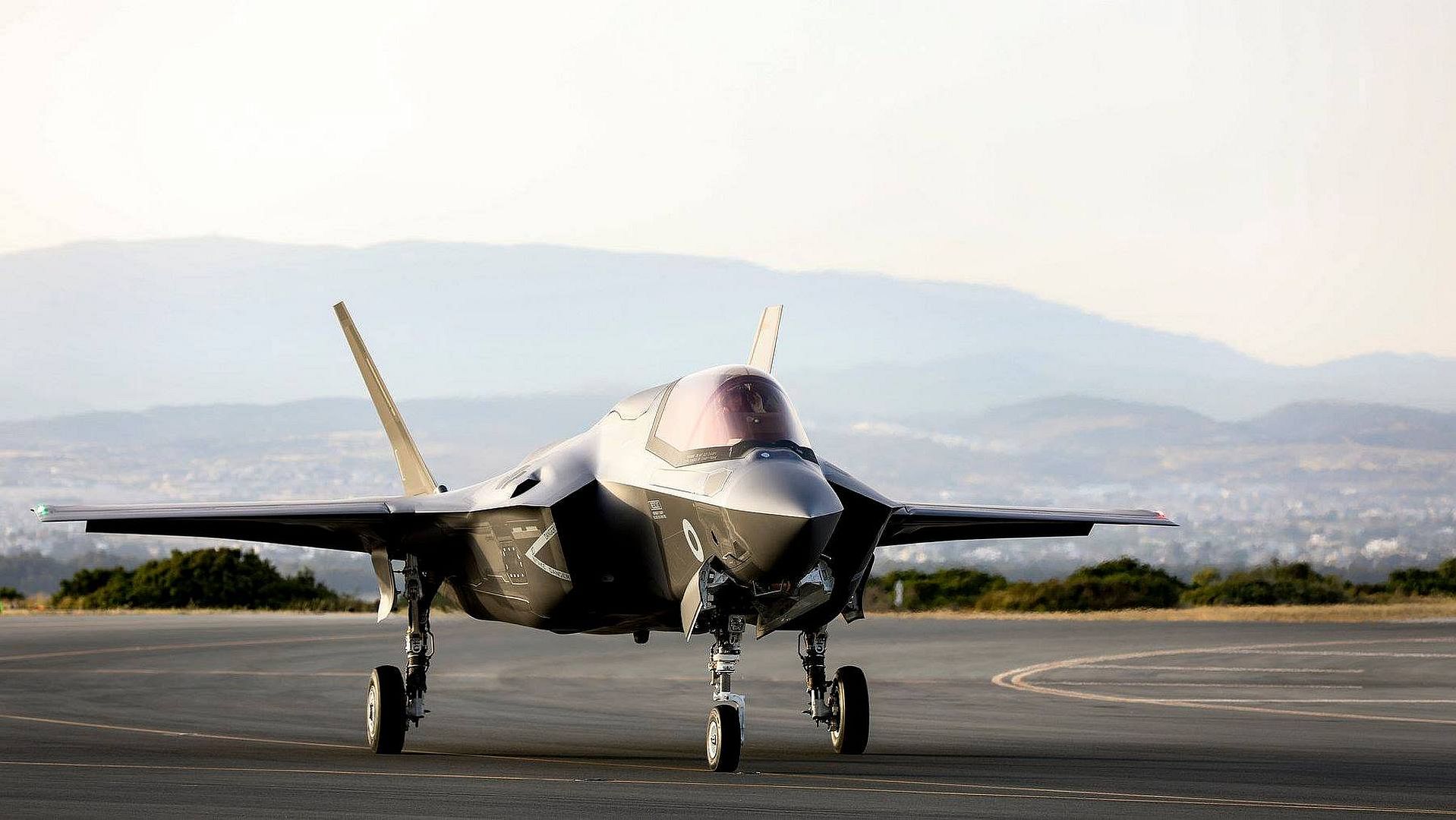
The UK currently owns 17 F-35B aircraft with the reformed 617 Sqn arriving back in the UK last year. More jets are due in Britain over the coming years, and there is an overall plan to procure 138 aircraft over the life of the programme.
The F-35 is the world?s largest defence programme at over $1.3 trillion, with UK industry providing 15% by value of every one of over 3,000 jets set for the global order book. That makes the economic impact greater than if we were building 100% of all 138 aircraft which we intend to buy. The programme has already generated $12.9 billion worth of orders and at peak production will support thousands of British manufacturing and engineering jobs.
(Source: UK Ministry of Defence; issued May 21, 2019)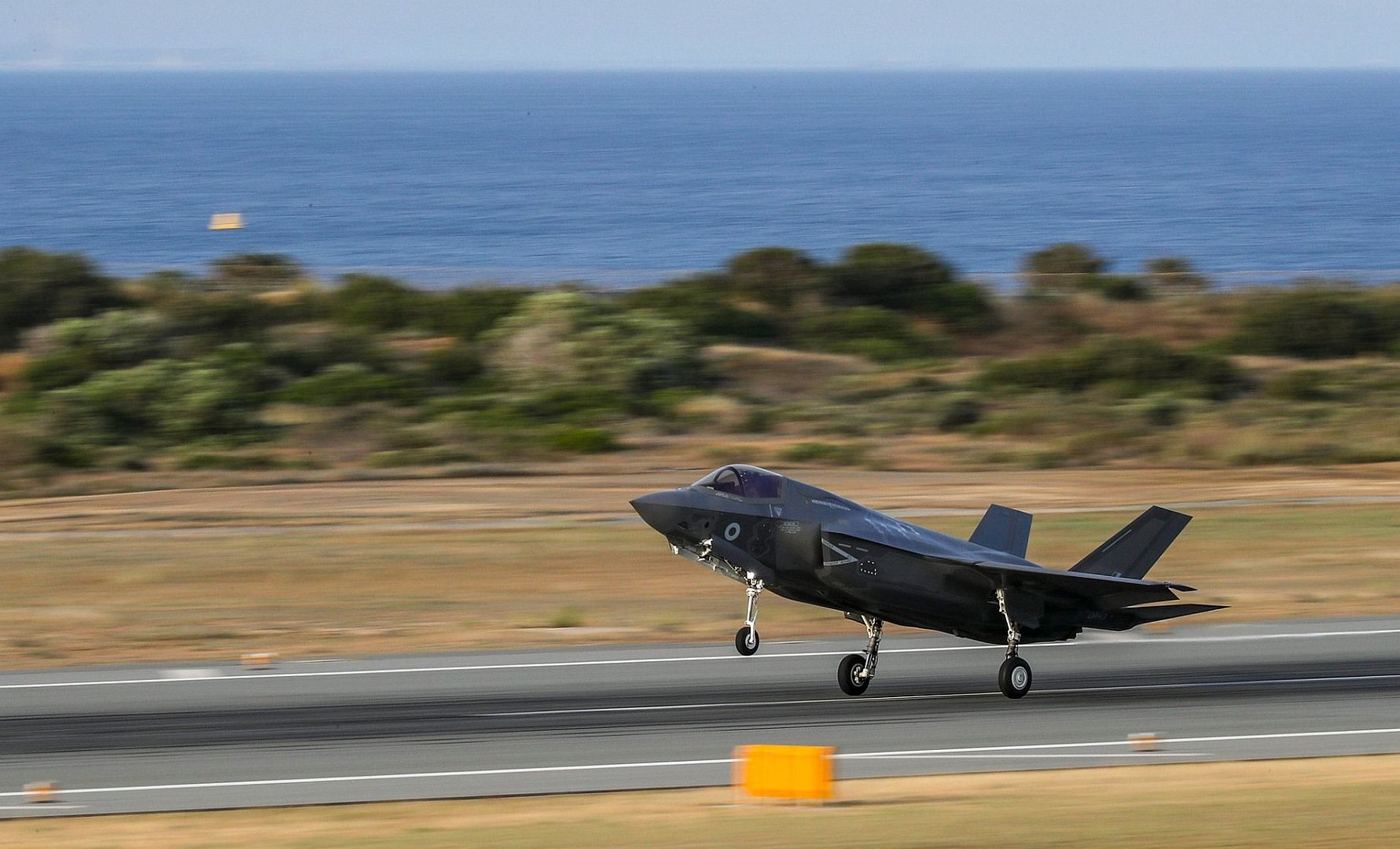
-
 Main AdminQatar Emiri Air Force (QEAF) Mirage 2000s and U.S. F-35A Lightning IIs fly in formation over Southwest Asia, May 21, 2019. This flight continues building on interoperability and military-to-military relationships with the QEAF. (U.S. Air Force photo by Senior Airman Keifer Bowes)
Main AdminQatar Emiri Air Force (QEAF) Mirage 2000s and U.S. F-35A Lightning IIs fly in formation over Southwest Asia, May 21, 2019. This flight continues building on interoperability and military-to-military relationships with the QEAF. (U.S. Air Force photo by Senior Airman Keifer Bowes)
A U.S. B-52H Stratofortress prepares to join with Qatar Emiri Air Force (QEAF) Mirage 2000s and U.S. F-35A Lightning IIs to fly in formation over Southwest Asia, May 21, 2019. This flight was conducted to continue building military-to-military relationships with the QEAF. The B-52H is part of the Bomber Task Force deployed to the U.S. Central Command area of responsibility to defend U.S. forces and interests in the region. (U.S. Air Force photo by Senior Airman Keifer Bowes)
GULF OF OMAN (May 22, 2019) An F/A-18E Super Hornet from the ?Pukin' Dogs? of Strike Fighter Squadron (VFA) 143 makes an arrested landing on the flight deck of the Nimitz-class aircraft carrier USS Abraham Lincoln (CVN 72). Abraham Lincoln Carrier Strike Group (ABECSG) is deployed to the U.S. 5th Fleet area of operations in support of naval operations to ensure maritime stability and security in the Central Region, connecting the Mediterranean and the Pacific through the western Indian Ocean and three strategic choke points. With Abraham Lincoln as the flagship, deployed strike group assets include staffs, ships and aircraft of Carrier Strike Group 12 (CSG 12), Destroyer Squadron 2 (DESRON 2), USS Leyte Gulf (CG 55) and Carrier Air Wing 7 (CVW 7). (U.S. Navy photo by Mass Communication Specialist 3rd Class Garrett LaBarge/Released)
GULF OF OMAN (May 22, 2019) An EA-18G Growler from the "Patriots" of Electronic Attack Squadron (VAQ) 140 flies over the Nimitz-class aircraft carrier USS Abraham Lincoln (CVN 72). Abraham Lincoln Carrier Strike Group (ABECSG) is deployed to the U.S. 5th Fleet area of operations in support of naval operations to ensure maritime stability and security in the Central Region, connecting the Mediterranean and the Pacific through the western Indian Ocean and three strategic choke points. With Abraham Lincoln as the flagship, deployed strike group assets include staffs, ships and aircraft of Carrier Strike Group 12 (CSG 12), Destroyer Squadron 2 (DESRON 2), USS Leyte Gulf (CG 55) and Carrier Air Wing 7 (CVW 7). (U.S. Navy photo by Mass Communication Specialist 3rd Class Garrett LaBarge/Released)
Airbus today announced that the A220 Family aircraft, the newest addition to its single-aisle portfolio, will now be offering increased range starting from H2 2020.
The A220 aircraft maximum take-off weight (MTOW*) is now confirmed to increase by 2,268 kg (2.3 metric tonnes). The new MTOW will increase the respective maximum range capabilities to 3,350 nm for the A220-300 and 3,400 nm for the A220-100, some 450 nm more than currently advertised.
?In true Airbus tradition we improve our products constantly,? said Christian Scherer, Chief Commercial Officer, Airbus. ?This new MTOW will allow operators to reach markets which today cannot be served by other small single-aisle aircraft types.?
?Since its entry-into-service close to three years ago, the A220 aircraft has already proven that it is meeting or beating its initial performance targets, bringing more flexibility and revenue potential to customers,? said Rob Dewar, Head of Engineering & Customer Support for the A220. ?Today, Airbus is reinforcing its confidence in the A220 platform and further enhancing its capabilities to meet upcoming market requirements.?
This performance increase is achieved by taking credit of existing structural and systems margins as well as existing fuel volume capacity. This will allow airlines to tap into new routes that were not possible before, connecting key cities in Western Europe with the Middle East or from Southeast Asia to Australia.
The A220 has been purpose built for efficiency. It brings together state-of-the-art aerodynamics, advanced materials and Pratt & Whitney?s latest-generation PW1500G geared turbofan engines to offer at least 20% lower fuel burn per seat compared to previous generation aircraft.
With an order book of over 530 aircraft to date, the A220 has all the credentials to win the lion?s share of the 100- to 150-seat aircraft market, estimated to represent 7,000 aircraft over the next 20 years.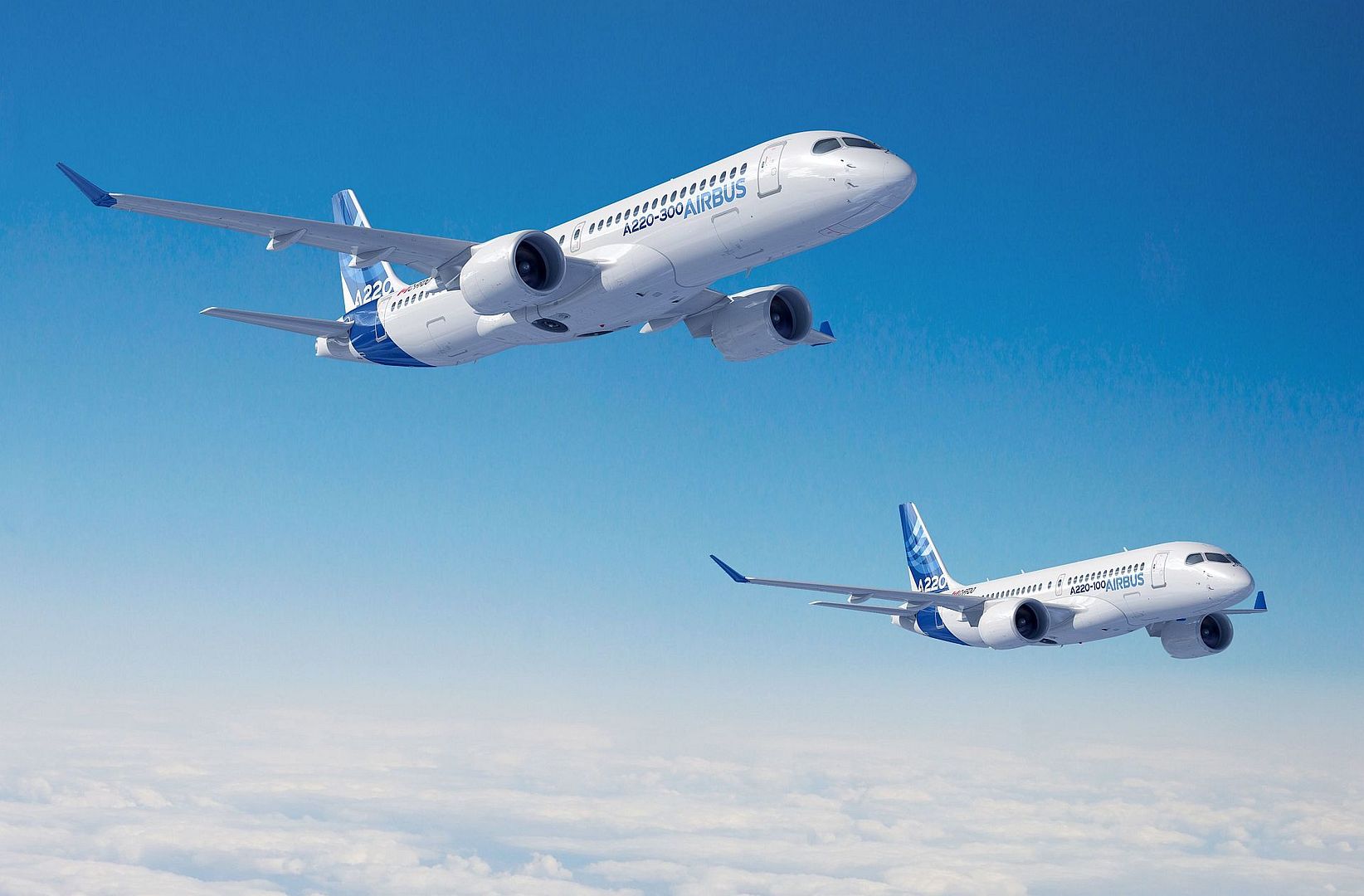
21 May 2019, EBACE - Bell Helicopter, a Textron Inc. (NYSE: TXT) company, is showcasing its corporate Bell 429 outfitted with Mecaer Aviation?s MAGnificent interior at EBACE. The aircraft is building momentum in the region with 7 recent sales to corporate customers in Germany, Greece, the Ukraine and Russia.
?The Bell 429 continues to increase its footprint in Europe with about a quarter of the global fleet being operated right here on this continent. The aircraft strikes the right balance of comfort, power and operational efficiency which is why it continues to be desirable in the corporate segment. Our customers appreciate the smoothness of the ride paired with the bespoke finishes which takes the experience of flight to the highest level of comfort.?
Duncan Van de Velde, Bell Managing Director for Europe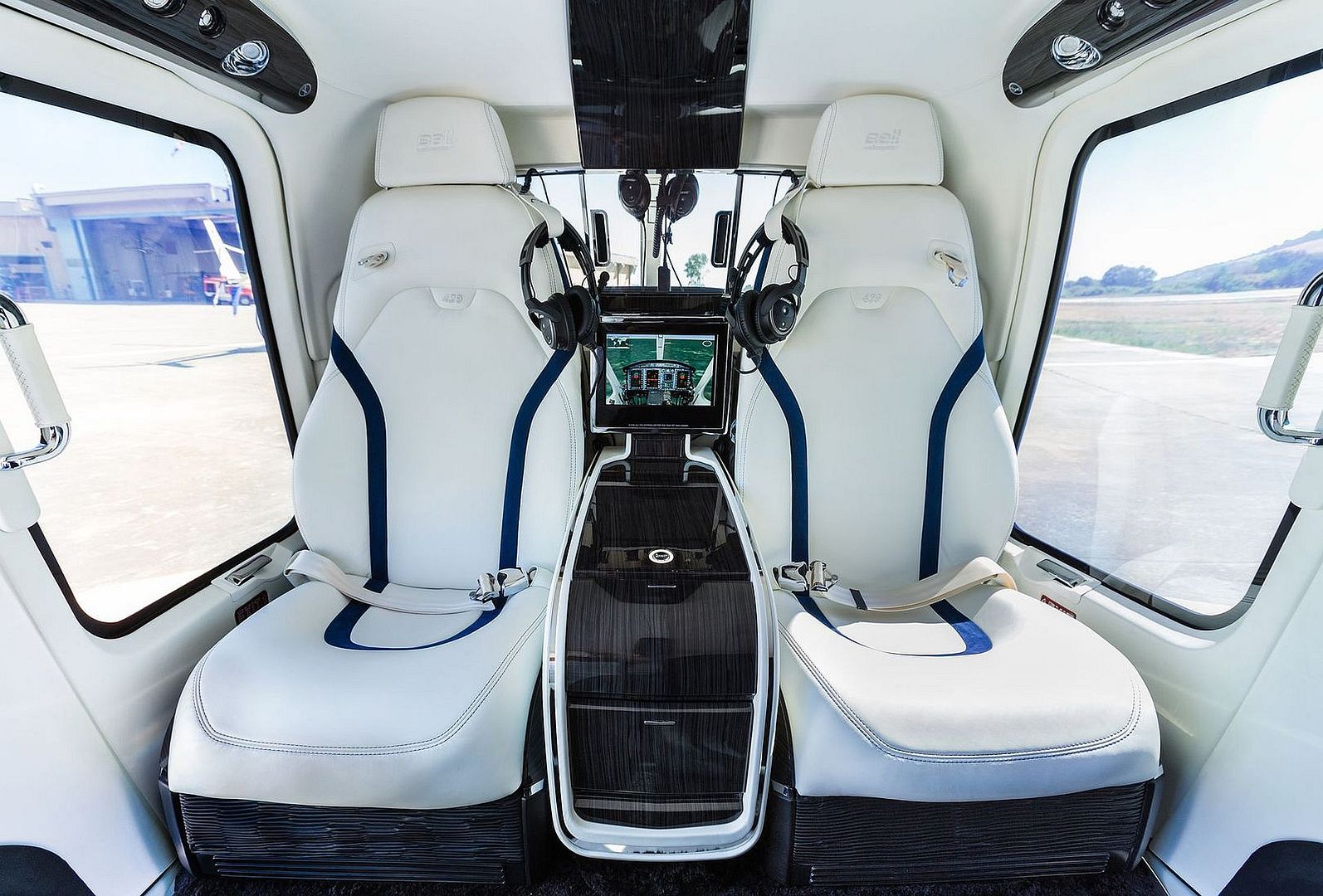
The Magnificent luxury interior available for the Bell 429 was created by Italy-based Mecaer Aviation Group (MAG), and was configured with four passenger seats and two center consoles. In addition, MAG?s signature sound canceling system (SILENS), In-Flight Entertainment (IFEEL) and electro-chromic passenger windows are available as part of this interior package. Passengers control the audio/video and moving map functions along with the electro-chromic windows through their own smart devices, which connect to the internal Wi-Fi in the aircraft.
The Bell 429 continues to be a global success with 330 aircraft currently in operation in 44 countries. As an advanced single pilot IFR aircraft with the ability to adapt to diverse demands without compromising safety and unrivaled service support, the Bell 429 is truly unsurpassed in its class.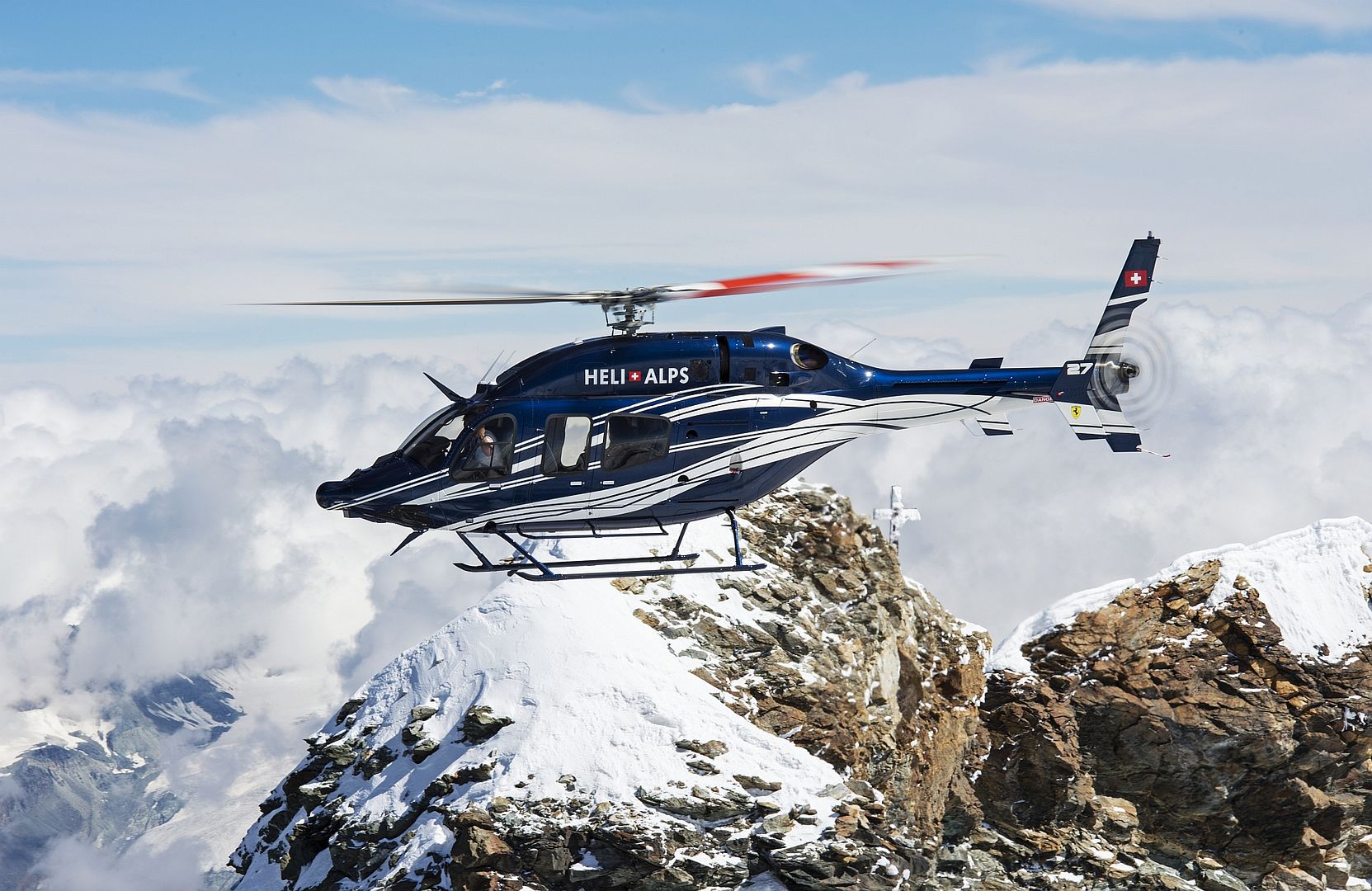
-
 Main AdminA Hawker Hunter takes off during Northern Edge, May 20, 2019, from Eielson Air Force Base, Alaska. Northern Edge is an exercise showcasing the lethality of joint forces and the capabilities of U.S. forces in and around the Indo-Pacific region. (U.S. Air Force photo by Staff Sgt. Micaiah Anthony)
Main AdminA Hawker Hunter takes off during Northern Edge, May 20, 2019, from Eielson Air Force Base, Alaska. Northern Edge is an exercise showcasing the lethality of joint forces and the capabilities of U.S. forces in and around the Indo-Pacific region. (U.S. Air Force photo by Staff Sgt. Micaiah Anthony)
U.S. Air Force F-16C Fighting Falcons assigned to the 18th Aggressor Squadron take off during Northern Edge, May 20, 2019, from Eielson Air Force Base, Alaska. Northern Edge provides effective, capabilities-centered joint forces, ready for deployment world-wide and enables real-world proficiency in detection, identification and tracking of units at sea, in the air and on land and respond to multiple crises in the Indo-Pacific region. (U.S. Air Force photo's by Staff Sgt. Micaiah Anthony)


A U.S. Air Force F-15C assigned to the 44th Fighter Squadron from Kadena Air Base, Japan, takes off during Northern Edge, May 20, 2019, from Eielson Air Force Base, Alaska. Northern Edge provides effective, capabilities-centered joint forces, ready for deployment world-wide and enables real-world proficiency in detection, identification and tracking of units at sea, in the air and on land and respond to multiple crises in the Indo-Pacific region. (U.S. Air Force photo by Staff Sgt. Micaiah Anthony)
A U.S. Navy EA-18G Growler assigned to VAQ-134 from Naval Air Station Whidbey Island, Wash., takes off during Northern Edge, May 20, 2019, at Eielson Air Force Base, Alaska. Northern Edge is an exercise showcasing the lethality of joint forces and the capabilities of U.S. forces in and around the Indo-Pacific region. (U.S. Air Force photo by Staff Sgt. Micaiah Anthony)
U.S. Air Force F-16C Block 52 Fighting Falcons assigned to the Air National Guard?s 169th Fighter Wing from McEntire Joint National Guard Base, S.C., are lined up and ready for flying operations in support of Arctic Challenge Exercise 2019 at Kallax Air Base, Lule?, Sweden, May 22, 2019. ACE 19 is a Nordic aviation exercise that provides realistic, scenario-based training to prepare forces for enemy defensive systems. U.S. forces are engaged, postured and ready to deter and defend in an increasingly complex security environment. (U.S. Air National Guard photo's by Senior Master Sgt. Edward Snyder)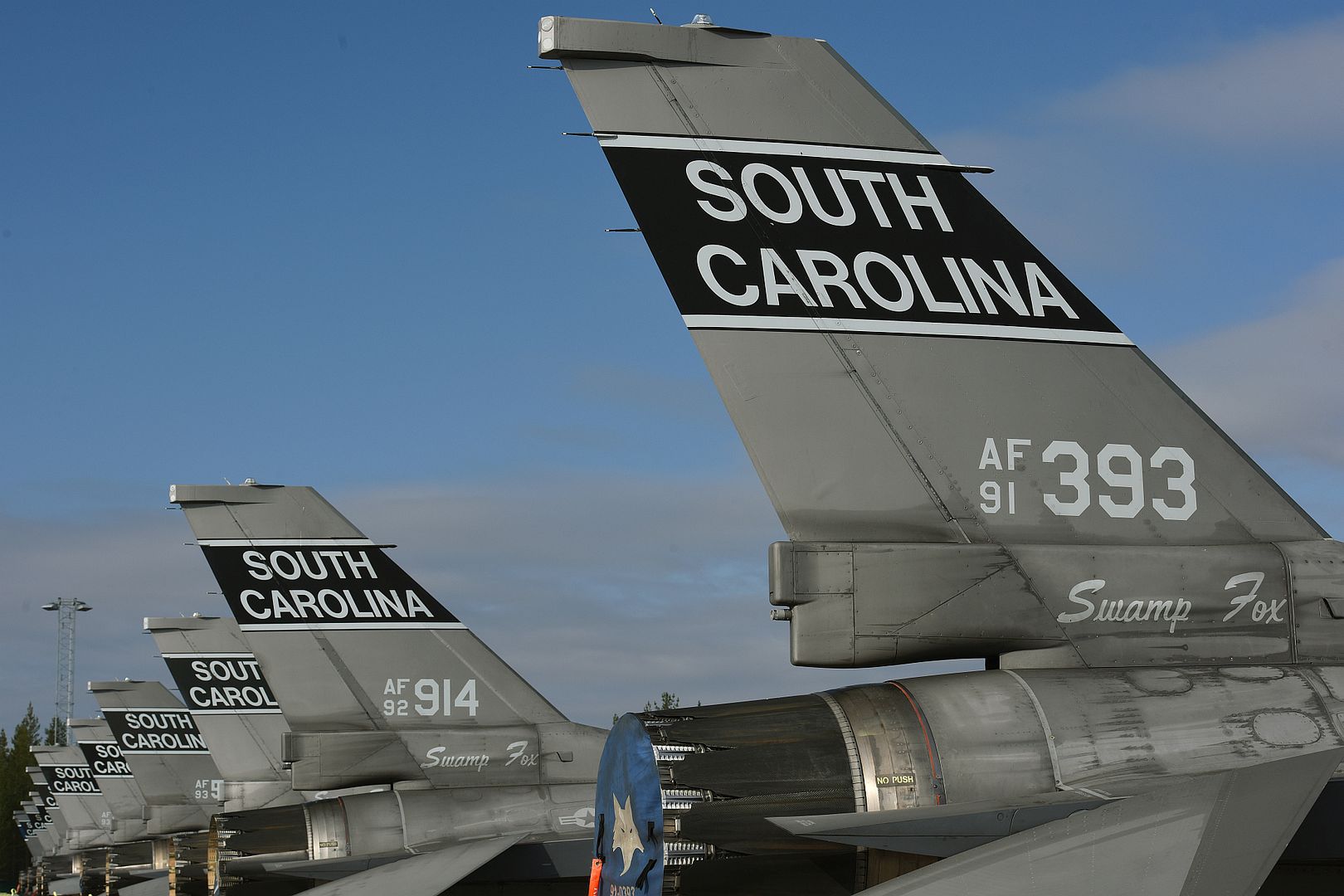
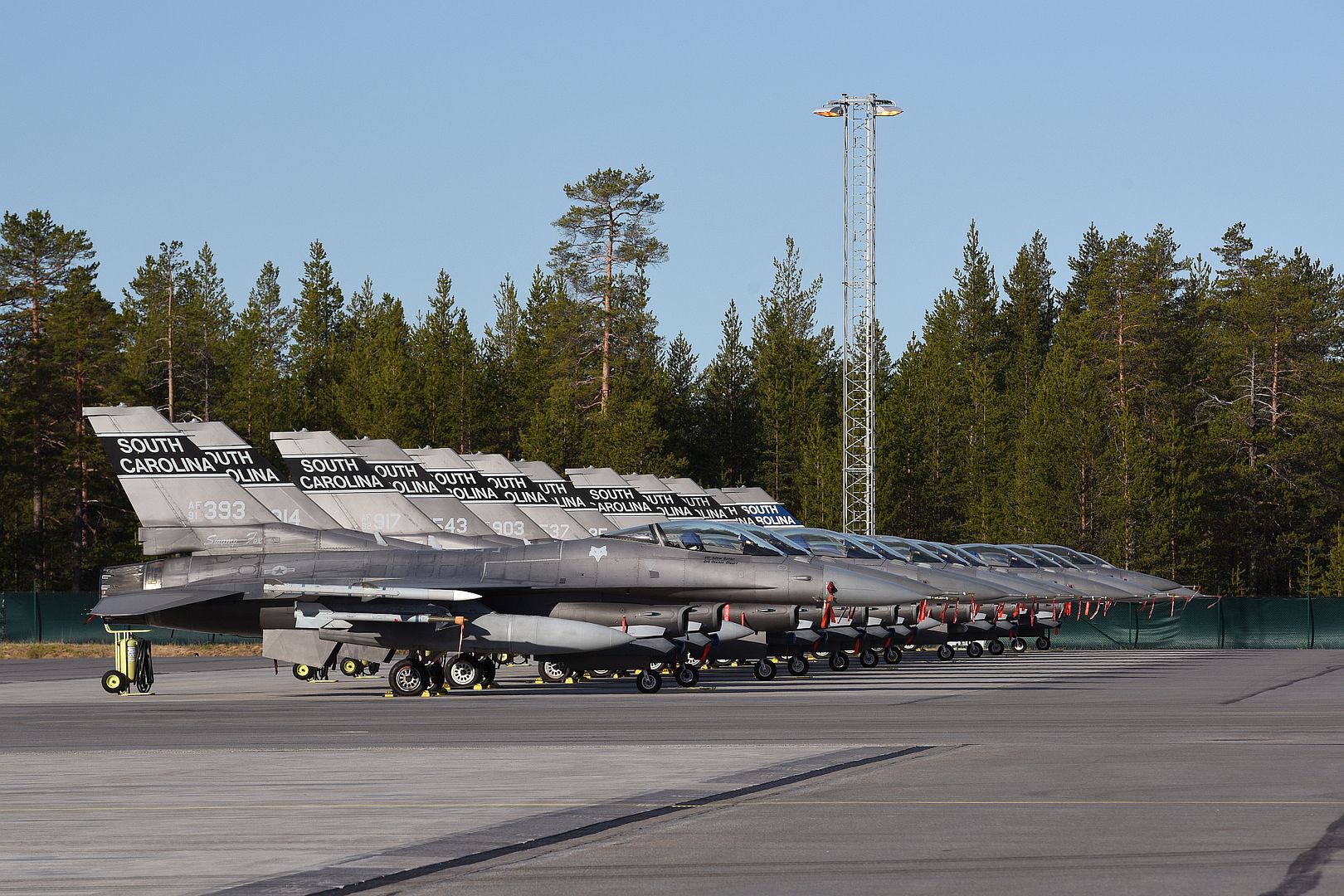
U.S. Air Force F-16 Fighting Falcon pilot assigned to the Air National Guard's 169th Fighter Wing from McEntire Joint National Guard Base, S.C., begins flying operations in support of Arctic Challenge Exercise 2019 at Kallax Air Base, Lule?, Sweden, May 22, 2019. ACE19 is a Nordic aviation exercise, and this year will include participation from the Swedish, Norwegian, Danish, Finnish, French, German, Dutch, British, and U.S. forces. U.S. force?s participation, as part of the European Deterrence Initiative, demonstrates steadfast commitment to NATO allies and partners in Europe. (U.S. Air National Guard photo by Capt. Rebecca Roodhouse)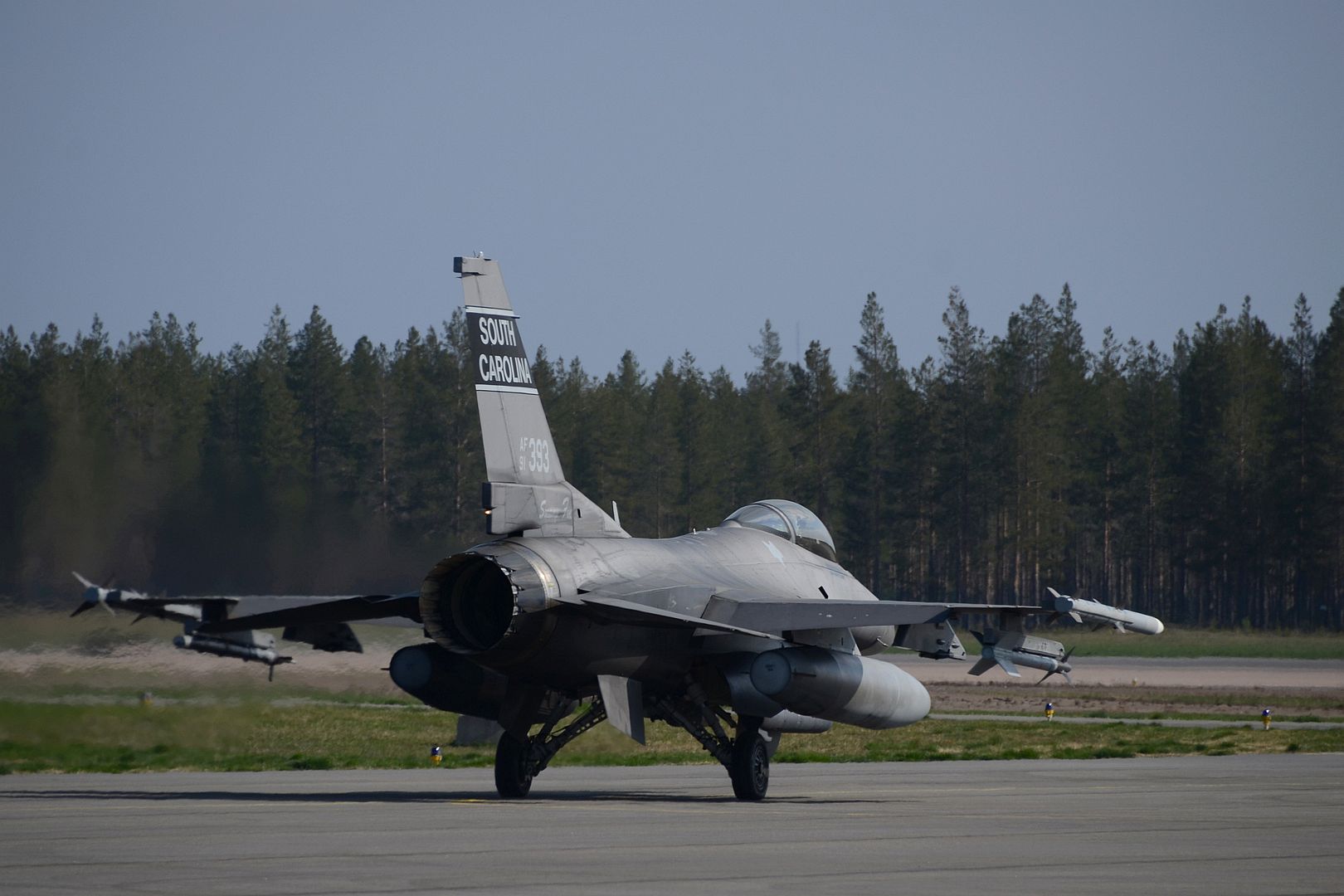
Oxford, This strikingly painted Airbus ACH130 helicopter, captured here over the English countryside, is due to be delivered to mobile home park entrepreneur Alfie Best a few days after the EBACE exhibition. Best, a proud Romany who recently featured on the Sunday Times Rich List, is acquiring the helicopter to support him in managing the numerous sites run by his company Wyldecrest Parks. He is also learning to fly helicopters himself.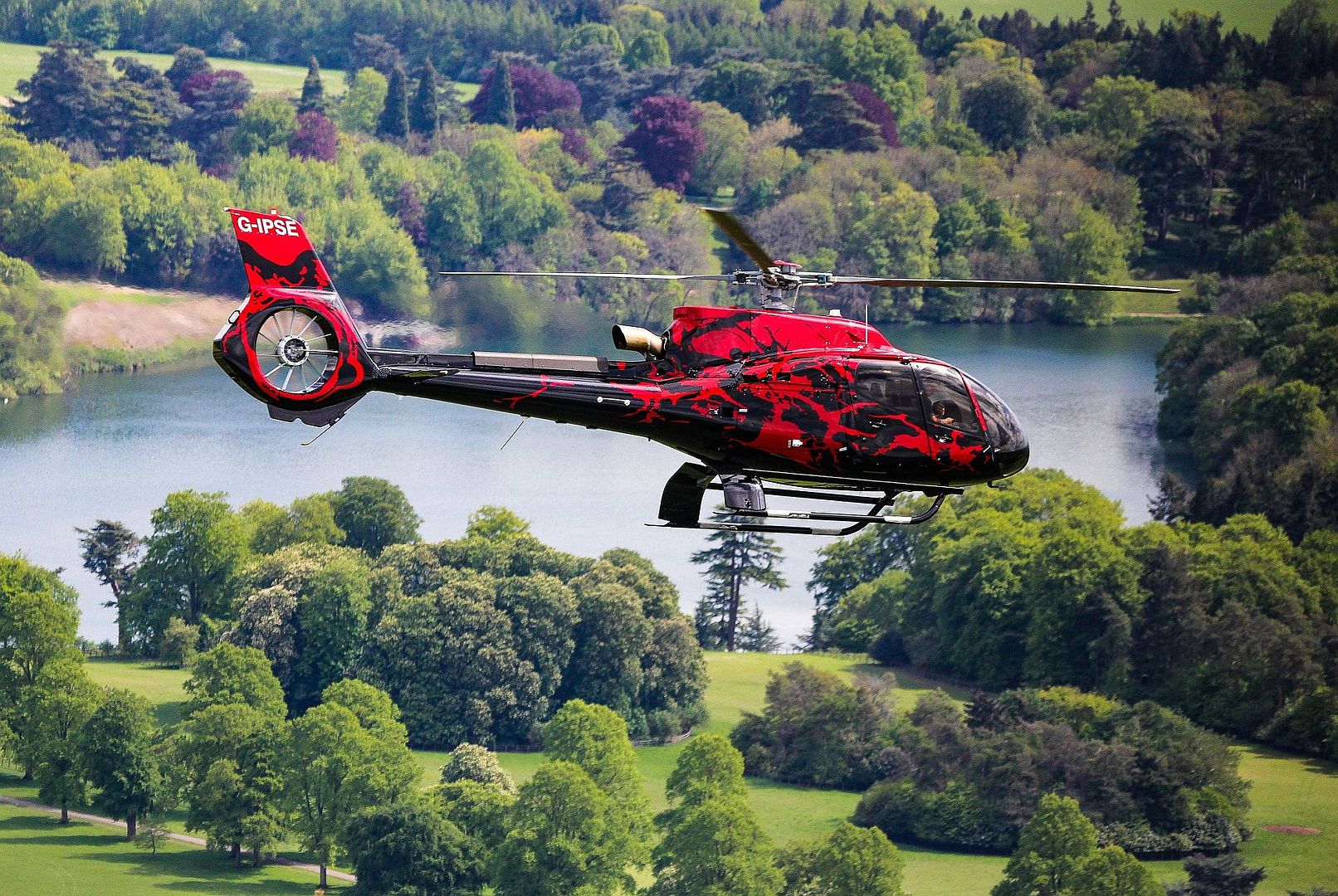
Marignane, Norwegian helicopter operator Helitrans has taken delivery of two Airbus H125 helicopters with digital logcards, becoming the first H125 operator able to manage the maintenance history of its aircraft components digitally, resulting in better data quality, time savings, and simpler processes, thereby reinforcing flight safety.
These helicopters are the first two in a series of seven H125s ordered by Helitrans to be delivered with fully digital logcards. They will be used for a wide range of missions that cover powerline construction and firefighting, as well as sightseeing trips, passenger transport, photography and telecom network development.
A logcard is a document that tracks the entire maintenance history of critical helicopter parts, from manufacture all along their in-service lives. The digital logcard replaces outdated paper logcards, prone to loss and error, with digital content stored in a secured cloud. Airbus Helicopters first unveiled its digital logcards in March 2019, becoming the first helicopter manufacturer on the market to transform paper logcards into easy-to-use digital data.
?We welcome this innovative approach to logcard management, which is fully in line with Helitran's vision of digitising and simplifying processes within the company,? said Per Erik Nesvold, director of maintenance at Helitrans.
?Since April 2019, we?ve been progressively offering customers taking delivery of a new Airbus civil helicopter the option of receiving digital logcards,? said Jean-Michel Arlhac, project leader for digital logcards at Airbus Helicopters. ?We?re thankful for Helitrans? confidence in our new digital means and look forward to receiving their valuable feedback in the months to come.?
Helitrans has been operating the H125 for almost thirty years from its bases around Norway. It is one of the largest helicopter companies in Norway and one of the top 30 civil operators in Europe. With these seven new H125s, Helitrans fleet will consist of 22 Airbus H125 and H130 helicopters.
The H125 and H130 lead the single-engine helicopter market, accounting for almost 70% of deliveries in the last five years. The Ecureuil fleet is composed of 5,000 helicopters in service with some 1,900 operators across the globe and it has accumulated more than 30 million flight hours.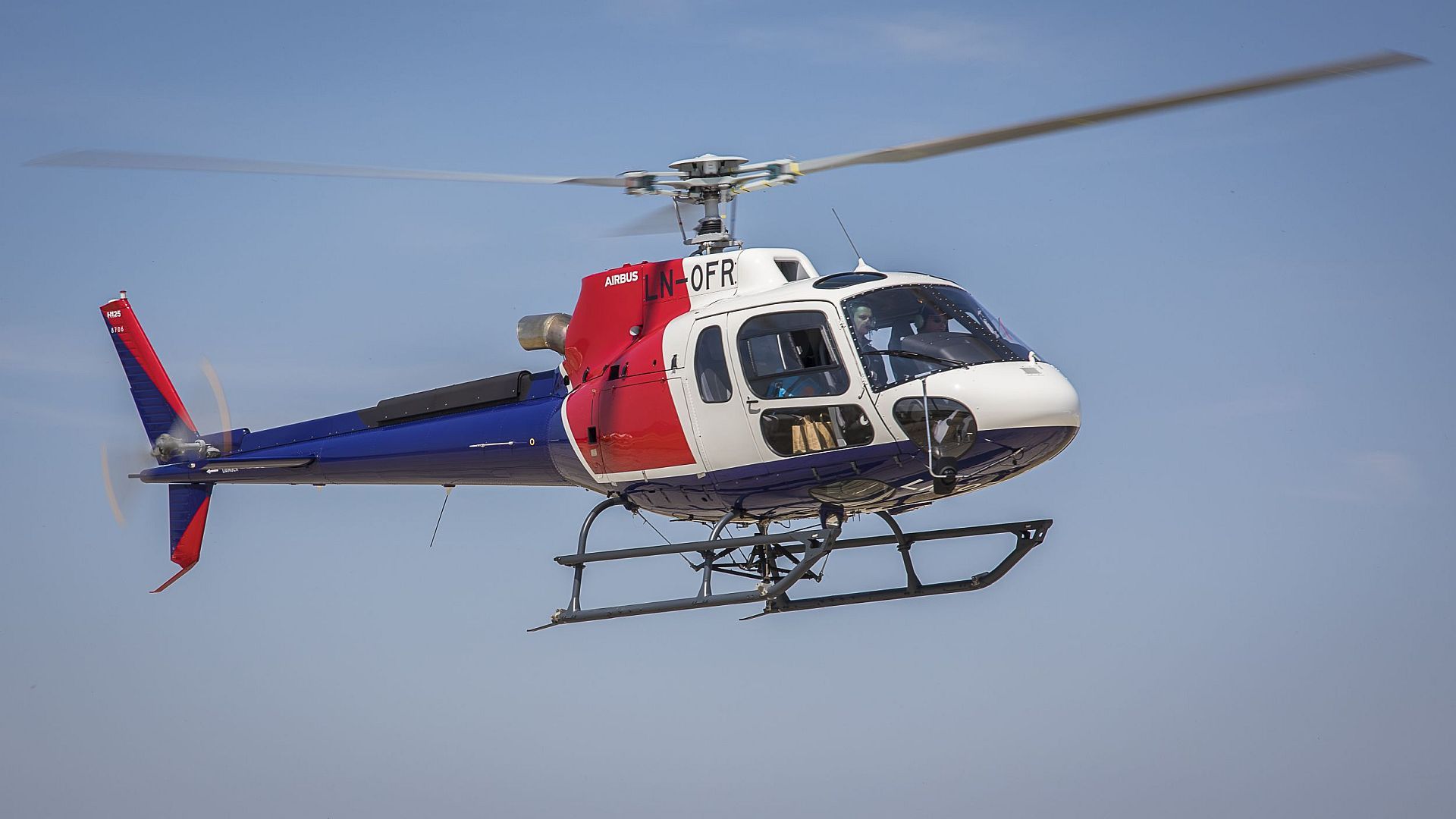
-
 Main AdminU.S. Air Force F-16C Block 52 Fighting Falcons assigned to the Air National Guard?s 169th Fighter Wing from McEntire Joint National Guard Base, S.C., return from the first day of flying operations in support Arctic Challenge Exercise 2019 at Kallax Air Base, Lule?, Sweden, May 22, 2019. ACE 19 is a Nordic aviation exercise that provides realistic, scenario-based training to prepare forces for enemy defensive systems. U.S. forces are engaged, postured and ready to deter and defend in an increasingly complex security environment. (U.S. Air
Main AdminU.S. Air Force F-16C Block 52 Fighting Falcons assigned to the Air National Guard?s 169th Fighter Wing from McEntire Joint National Guard Base, S.C., return from the first day of flying operations in support Arctic Challenge Exercise 2019 at Kallax Air Base, Lule?, Sweden, May 22, 2019. ACE 19 is a Nordic aviation exercise that provides realistic, scenario-based training to prepare forces for enemy defensive systems. U.S. forces are engaged, postured and ready to deter and defend in an increasingly complex security environment. (U.S. Air
National Guard photo's by Senior Master Sgt. Edward Snyder)
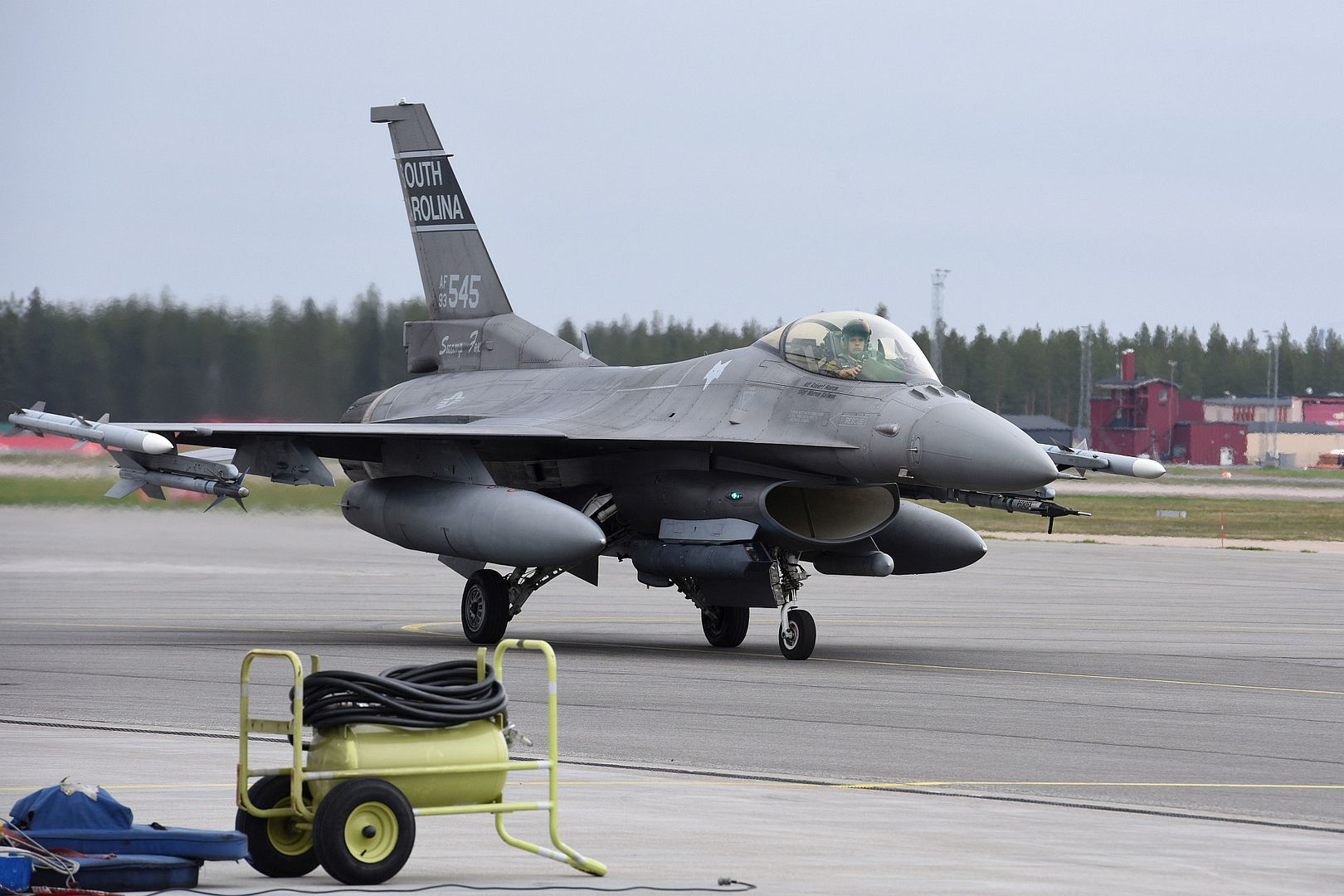
NELLIS AIR FORCE BASE, Nev. ? An F-16 Fighting Falcon fighter jet made its initial flight after receiving the first U.S. Air Force ?Ghost? paint scheme, May 23.
The design was chosen by a poll held by Brig. Gen. Robert Novotny, 57th Wing commander, on his social media account to add a new look to the 64th Aggressor Squadron (AGRS).
?I love this job, and I love what we do at Nellis Air Force Base, so I want to take any opportunity to boast about our fine men and women who do great work for their nation,? said Novotny. ?Social Media gives me a chance to connect directly with the folks who have a similar passion for military aviation.?
Novotny decided to take a non-traditional route of determining a new paint scheme for the F-16. Facebook and Novotny?s followers would be the deciding factor for the new Ghost scheme.
Once the poll was concluded, the idea of the Ghost jet was handed off to the Mission First (M1) crew at the corrosion shop to make it a reality.
?We want a good product just like the commander does,? said Troy Blaschko, an aircraft painter with M1 assigned to the 57th Maintenance Group. ?It means just as much to us as it does to the pilots and we?re really glad to be a part of it.?
M1 was tasked to take the idea from a two-dimensional graphic to a three-dimensional 20,300-pound fighter jet.
From there they had to mask, sand, wash, prime, paint and apply stencils to the aircraft for it to be completed.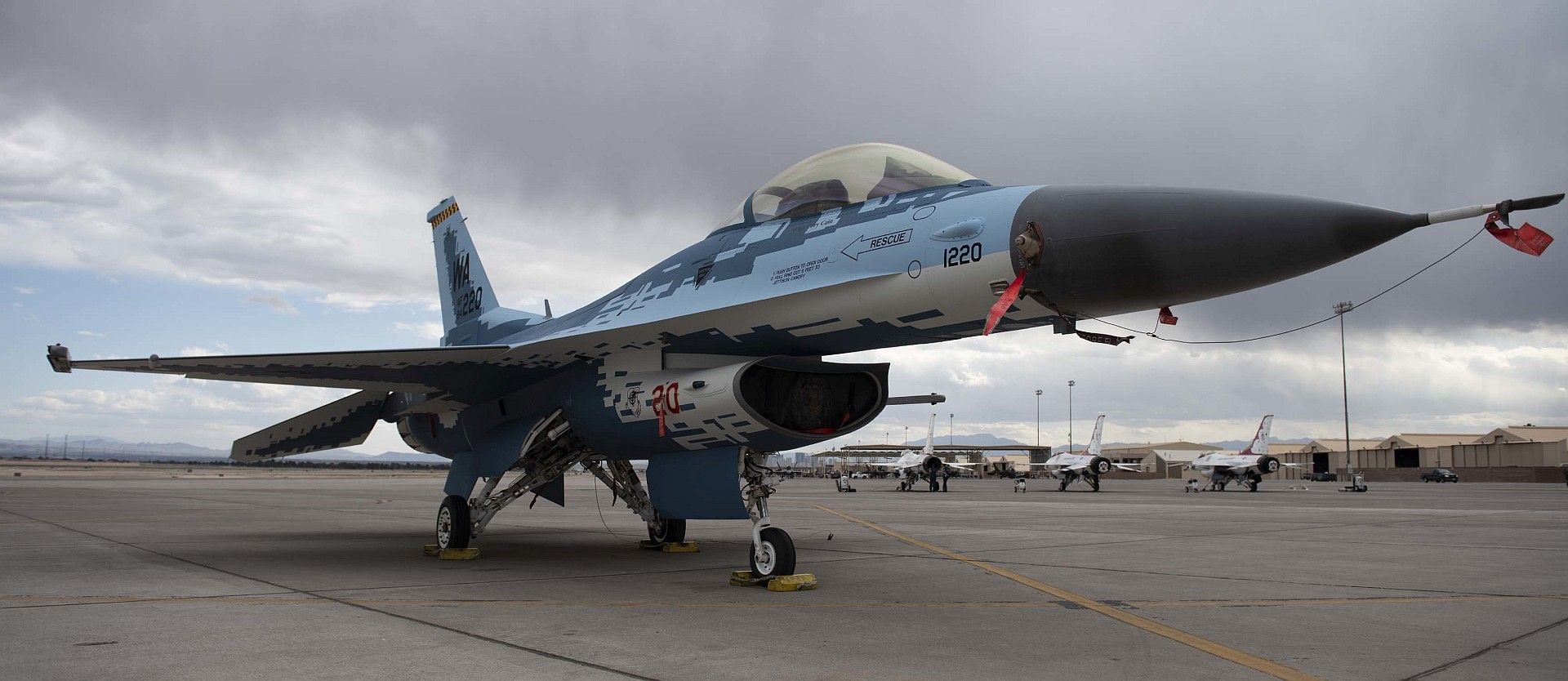
The project started on April 22 once the F-16 was towed into the corrosion shop from Viper Aircraft Maintenance Unit (AMU). With a seven-man team on days and a six-man team on swings for M1, the jet was finished in just under one month.
Once the jet was finished, it was towed back to Viper AMU and back in the hands of its crew chief.
?It?s quite an honor [being the crew chief for the first Air Force Ghost paint scheme],? said Master Sgt. Corey Cain, 926 AMXS dedicated crew chief. ?Once I learned about the crowd sourcing for the paint scheme, I was very excited for it. I knew an aircraft was going to receive this paint job but when they said it was going to be my jet, I was pumped.?
Keep an eye out for a Ghost in the sky. It will surely be a daunting adversary for our Air Force and our allies.
(U.S. Air Force photo's by Staff Sgt. Tabatha McCarthy and Airman 1st Class Bryan Guthrie)
A Swedish JAS 39 Gripen from the Norrbotten Wing, Kallax Air Base, Sweden, takes off for its next mission in support of Arctic Challenge Exercise 2019 at Kallax AB, Lule?, Sweden, May 23, 2019. ACE 19 is a Nordic aviation exercise that provides realistic, scenario-based training to prepare forces for enemy defensive systems. U.S. forces are engaged, postured and ready to deter and defend in an increasingly complex security environment. (U.S. Air National Guard photo's by Senior Master Sgt. Edward Snyder)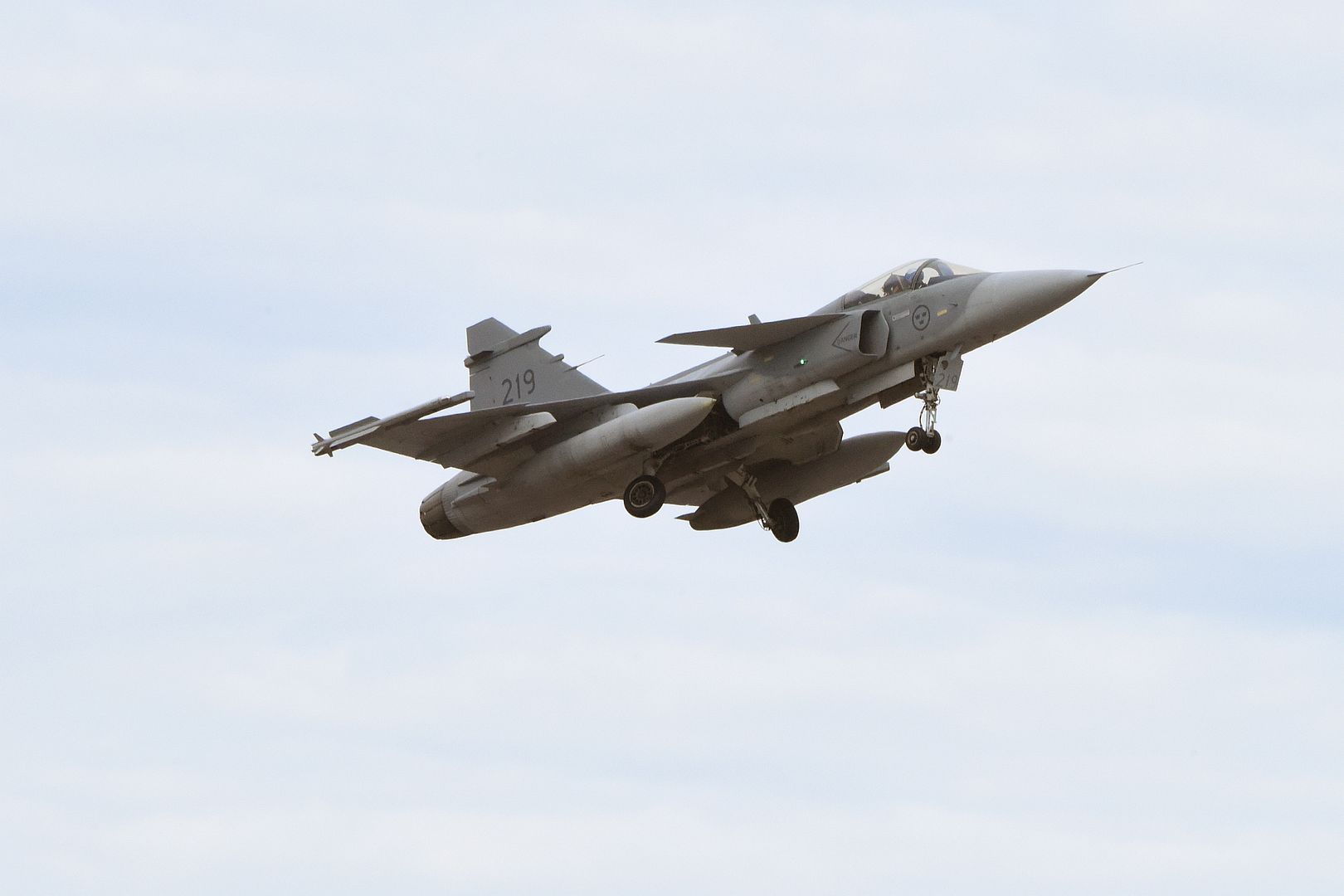

GULF OF OMAN (May 22, 2019) An F/A-18F Super Hornet from the "Jolly Rogers" of Strike Fighter Squadron (VFA) 103 makes an arrested landing on the flight deck of the Nimitz-class aircraft carrier USS Abraham Lincoln (CVN 72). The Abraham Lincoln Carrier Strike Group (ABECSG) is deployed to the U.S. 5th Fleet area of operations in support of naval operations to ensure maritime stability and security in the Central Region, connecting the Mediterranean and the Pacific through the western Indian Ocean and three strategic choke points. With Abraham Lincoln as the flagship, deployed strike group assets include staffs, ships and aircraft of Carrier Strike Group (CSG) 12, Destroyer Squadron (DESRON) 2, the guided-missile cruiser USS Leyte Gulf (CG 55) and Carrier Air Wing (CVW) 7. (U.S. Navy photo by Mass Communication Specialist 2nd Class Matt Herbst/Released)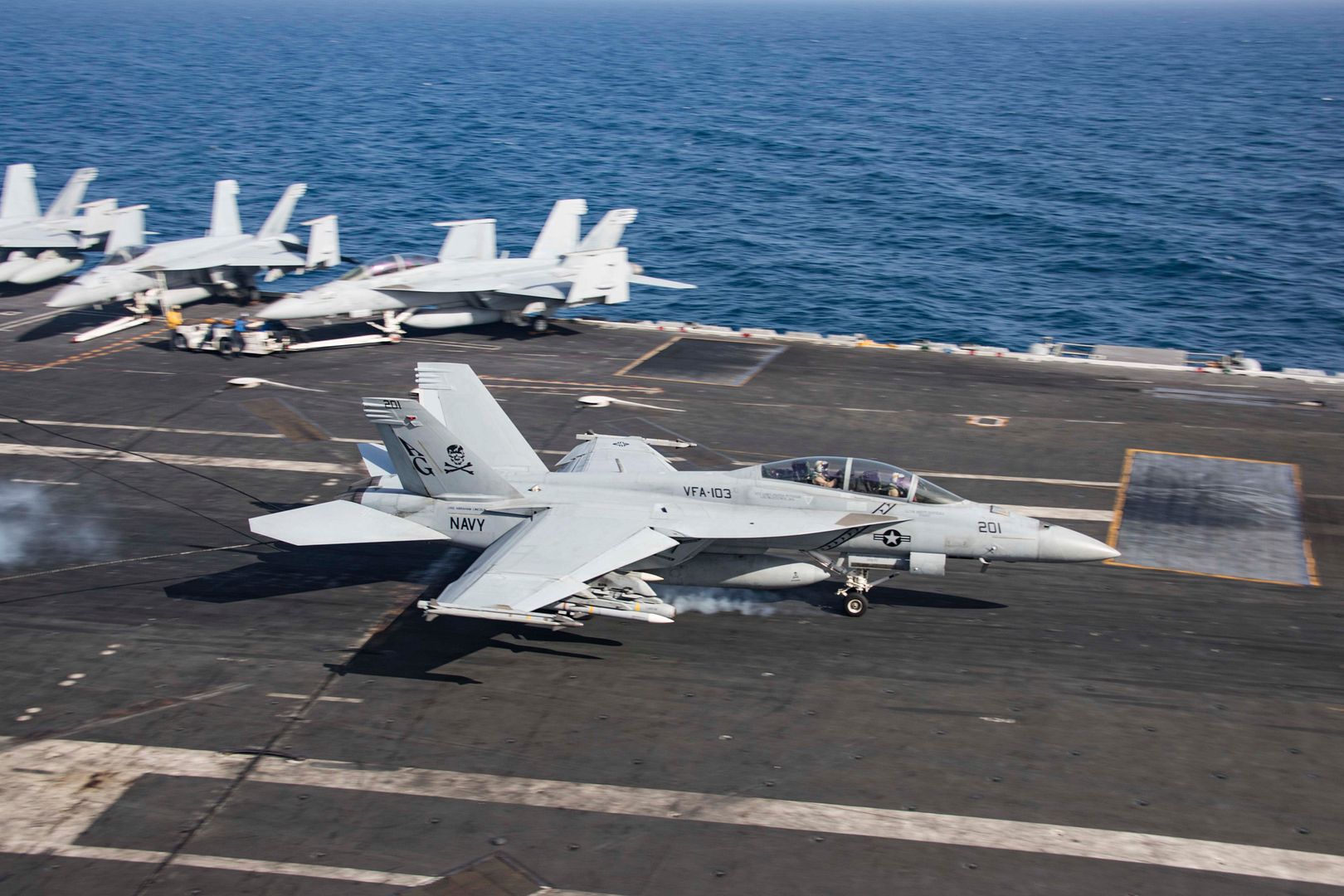
NORTH ARABIAN SEA (May 23, 2019) Aviation Boatswain's Mate (Equipment) 3rd Class Kayla Draghici, from Clearwater, Fla., ensures an F/A-18E Super Hornet from the Pukin Dogs of Strike Fighter Squadron (VFA) 143 is seated in the catapult shuttle on the flight deck of the Nimitz-class aircraft carrier USS Abraham Lincoln (CVN 72). The Abraham Lincoln Carrier Strike Group (ABECSG) is deployed to the U.S. 5th Fleet area of operations in support of naval operations to ensure maritime stability and security in the Central Region, connecting the Mediterranean and the Pacific through the western Indian Ocean and three strategic choke points. With Abraham Lincoln as the flagship, deployed strike group assets include staffs, ships and aircraft of Carrier Strike Group (CSG) 12, Destroyer Squadron (DESRON) 2, the guided-missile cruiser USS Leyte Gulf (CG 55) and Carrier Air Wing (CVW) 7. (U.S. Navy photo by Mass Communication Specialist 3rd Class Jeff Sherman/Released)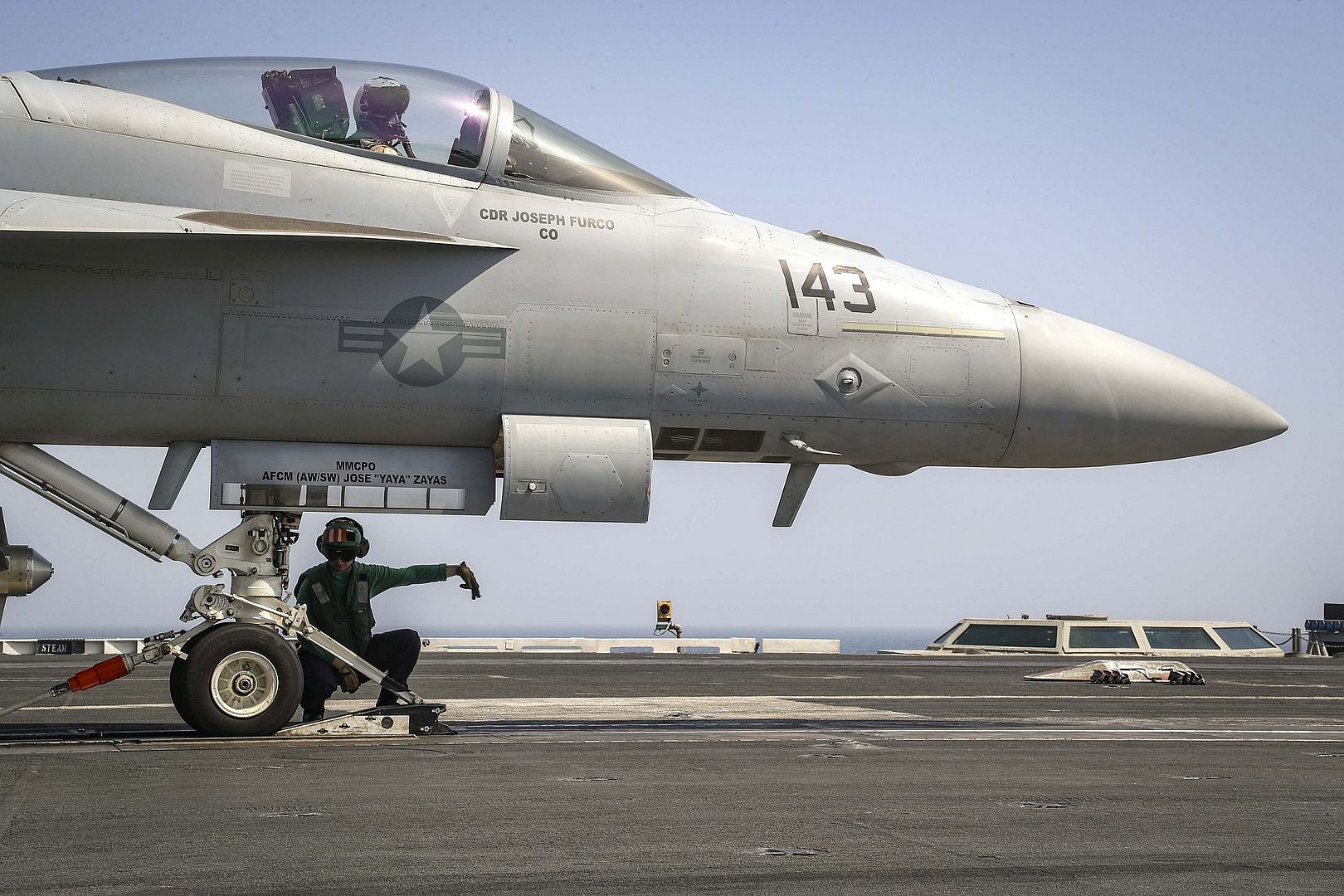
Geneva, Airbus Corporate Helicopters (ACH) has delivered the first of two ACH145 helicopters to an existing private customer as the first step in a fleet renewal programme.
The two aircraft will be primarily flown from super yachts in the Mediterranean and Caribbean regions on behalf of the owner who is a highly experienced user of Airbus helicopters.
Isle of Man-based helicopter management and operation specialist Luviair will manage the ACH145s as well as an ACH160 that has been acquired. The three aircraft will replace another three currently in service.
The second ACH145 will be delivered in the final quarter of 2019 and the ACH160, which will be used for onshore transport, will be delivered following certification.
Luviair has operated a fleet of VIP Airbus helicopters for almost 20 years, managing every aspect of its clients? operations from operational bases in London, the Mediterranean, the Caribbean and on board some of the largest superyachts in the world.
The ACH145s feature the ACH Line interior cabin concept in a bespoke version designed by London-headquartered Harrison Eidsgaard who also created the exterior livery inspired by the yacht environment. The ACH160 will have the ACH Exclusive concept providing an exceptional level of luxury.
Frederic Lemos, Head of ACH, said: ?We greatly value our relationship with this customer who knows our aircraft well, and we strongly appreciate their loyalty in selecting the ACH145 and, in particular, the new ACH160 after nearly two decades of operating Airbus helicopters.
?The transition to this new generation of Airbus helicopters is a clear demonstration that the ACH160 meets the demanding requirements of the most discerning corporate helicopter customers.?
The full ACH helicopter range consists of the ACH125, ACH130, ACH135, ACH145, ACH160 and ACH175 variants of Airbus Helicopters? comprehensive and market-leading family of light and medium models. A range of premium-design aircraft completions, including bespoke solutions, is available for all models.
Renowned for its combination of versatility and comfort, the ACH range of helicopters is admired by passengers and pilots alike for its stylish interiors, smooth and quiet ride allied to its technologically advanced Helionix digital avionics system ensuring carefree handling and the highest level of safety.
The attached photo shows the first of the two ACH145s in the customer paint scheme.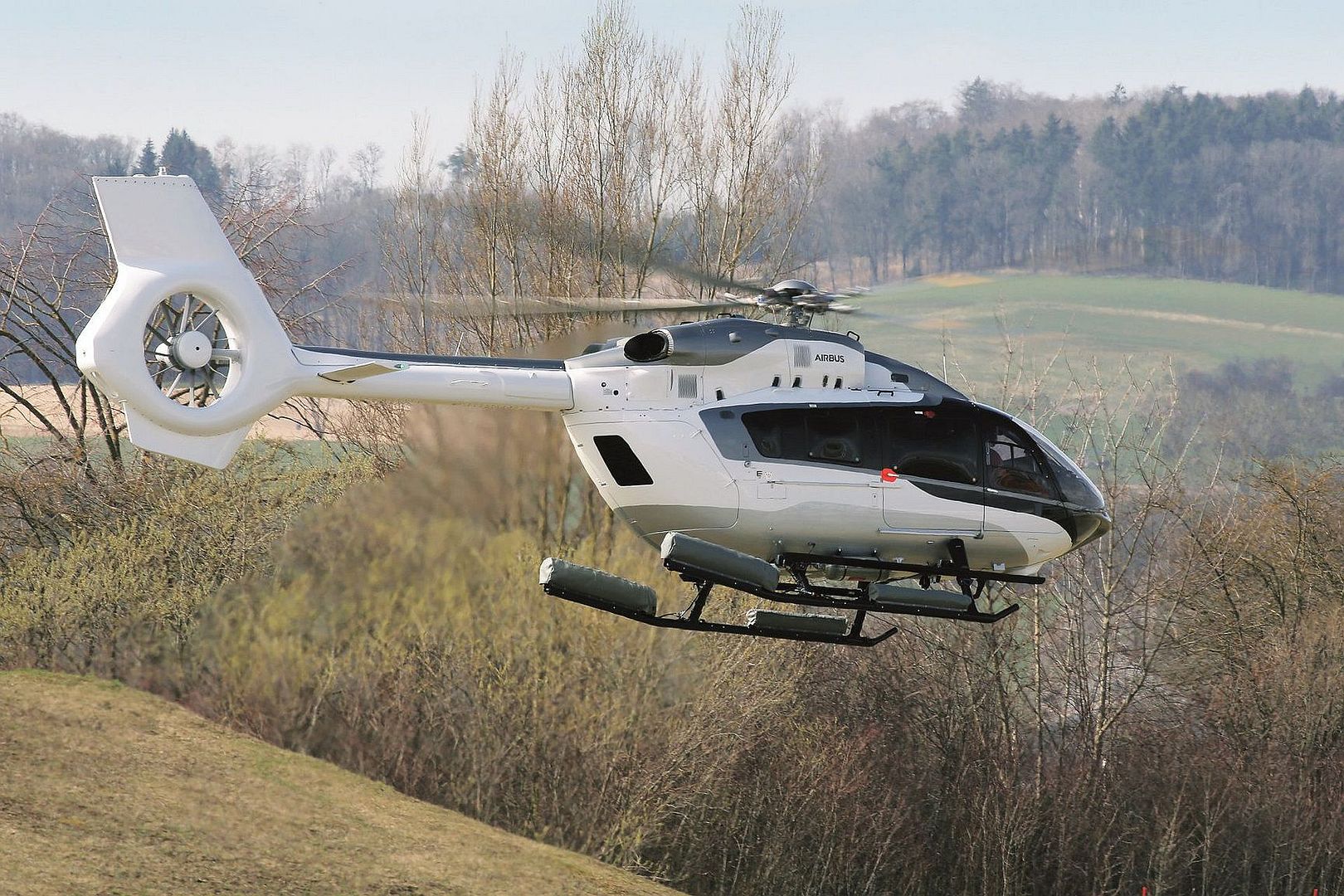
Delta Air Lines took delivery of its first A330-900, one of 35 A330neos the Atlanta, Georgia-based airline has on order. With new fuel-efficient engines, aerodynamic improvements and the advanced Airspace by Airbus cabin, the A330-900 will give Delta a premier long-haul, wide-body aircraft with exceptionally low operating costs.
Delta was the launch customer for the A330-900, ordering 25 in November 2014 and an additional 10 last year. With the addition of the A330-900, Delta is now operating both of Airbus? newest wide-body models. It has 13 A350-900s in its fleet with another 12 on order. Delta operates more than 265 Airbus aircraft, including A321s and A220s, and the airline?s order backlog with Airbus exceeds 270, including 100 A321neos.
Delta is one of the world?s leading airlines, an industry pacesetter. As the A330-900 is placed into service on Delta's global network, it will complement the airline's growing wide-body fleet of A330s and A350 XWBs, setting new standards for efficiency, profitability, and provide passengers with extraordinary travel experiences.
An environmental milestone was set as a Delta crew ferried the new A330-900 back to the company?s Atlanta base using a jet fuel blended from conventional sources and non-petroleum synthetic fuel.
Delta will initially base its A330-900s at Seattle-Tacoma International Airport, where it will operate the aircraft on flights to Shanghai, Seoul and Tokyo Narita. Delta will configure its A330-900s for 281 passengers, including 29 in business-class suites, 28 in premium economy, 56 in extra-legroom economy seats, and 168 in standard economy. The aircraft will feature Delta's new internally developed in-flight entertainment system.
The A330neo is a true new-generation aircraft, building on the features of the popular A330 features and leveraging technology developed for the A350 XWB technology.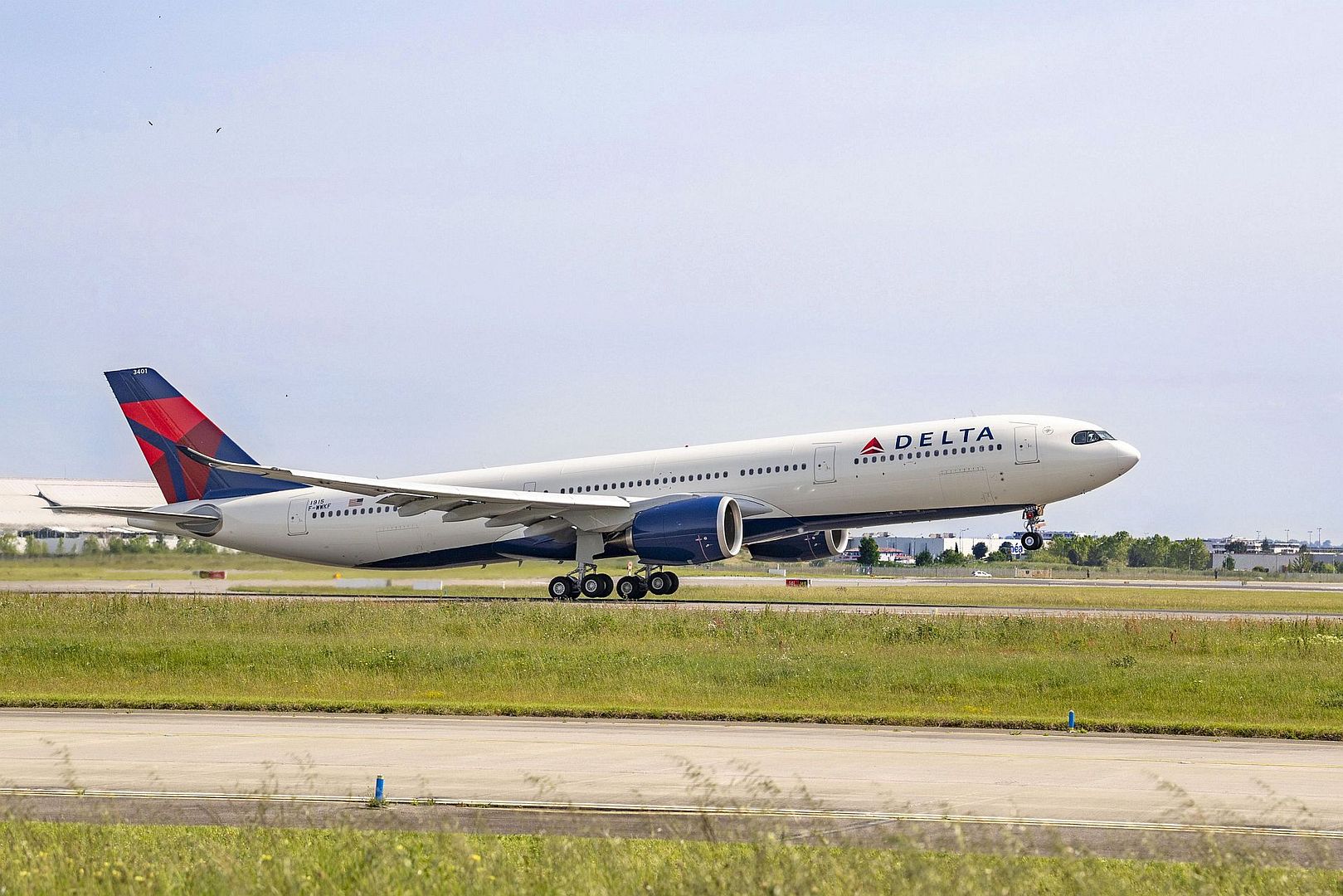
Powered by the latest Rolls-Royce Trent 7000 engines, and featuring a new wing with increased span and A350 XWB-inspired Sharklets, the A330neo provides an unprecedented level of efficiency ? with 25% lower fuel burn per seat than previous generation competitors.
Equipped with the Airbus Airspace cabin, the A330neo offers a unique passenger experience with more personal space and the latest generation in-flight entertainment system and connectivity.
The A330-900 can accommodate 287 seats in a typical three-class layout or up to 440 for high-density configurations with a range of up to 7,200 nautical miles.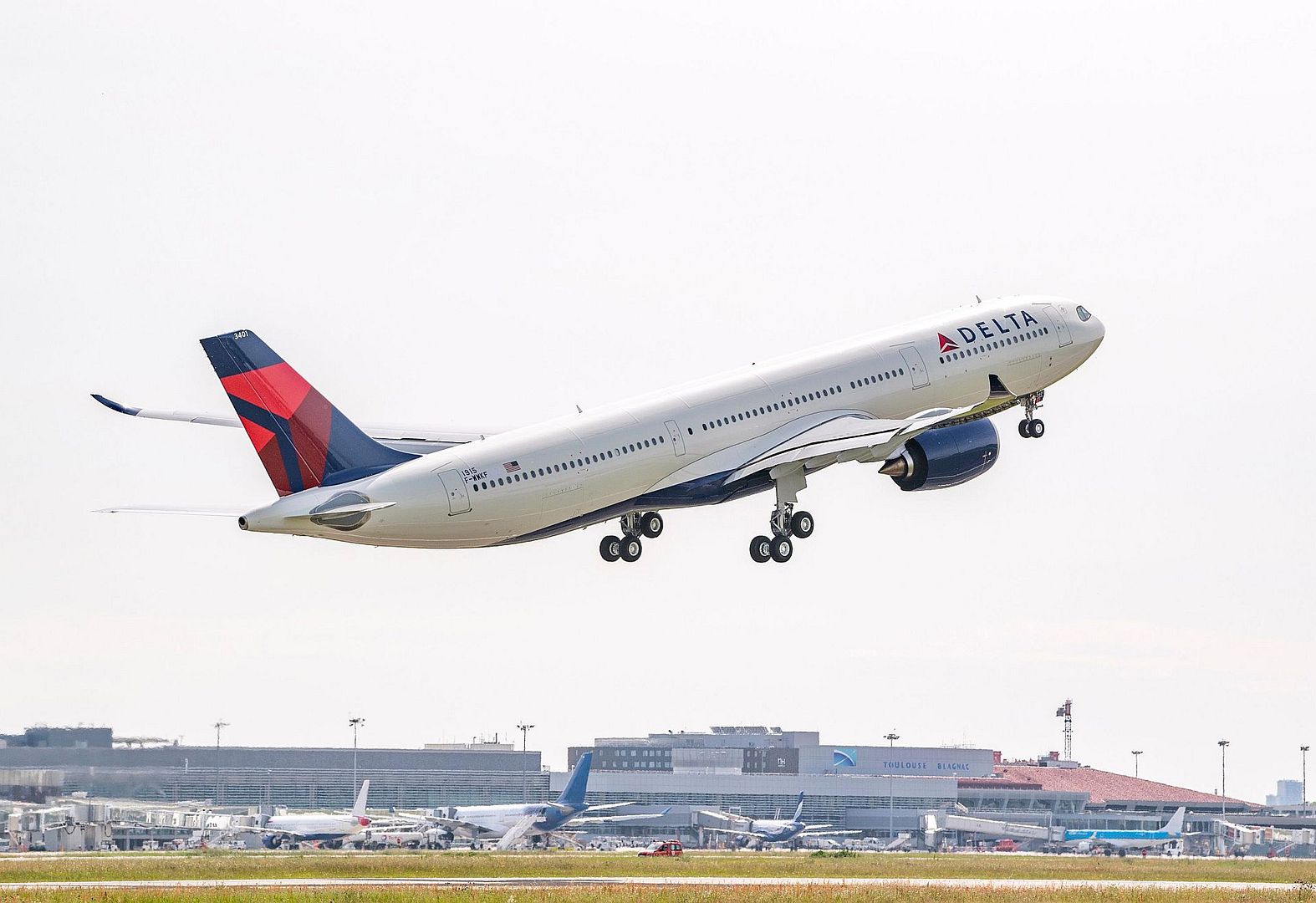
Leonardo has been contracted by the UK Ministry of Defence to support a series of trials in which the ?BriteCloud 55? Expendable Active Decoy (EAD) is being trialled for operations with the Royal Air Force (RAF)?s fleet of Eurofighter Typhoon aircraft. BriteCloud was cleared for service last year on the RAF?s fleet of Tornado GR4 aircraft and Leonardo has delivered a quantity of the countermeasures to the RAF for operations.
The first trial with Typhoon took place in April in the UK. At this trial, 33 BriteCloud rounds were dispensed from aircraft flown by the RAF?s 41 Test and Evaluation Squadron against a range of representative threats.
Made in Luton, UK, BriteCloud is a breakthrough technology which packs digital protection from dangerous radar-guided missiles into a package the size of a drinks can, fitting into the same launcher as a standard 55mm flare. Leonardo is currently the only company in the world which has managed to sufficiently miniaturise Digital RF Memory (DRFM) countermeasure technology to the point where it can be launched from a standard chaff and flare dispenser. In 2018 the RAF became the first Air Force to field this new protective technology.
Prior to accepting BriteCloud into service on Tornado, the UK MOD conducted extensive testing to validate the performance of the decoy, ensuring it could be launched safely from the aircraft and developing operational tactics for its use in battle. It is intended that this work will be used to support the agile delivery of BriteCloud into sevice on Typhoon.
A range of BriteCloud variants are available. As well as the ?BriteCloud 55? variant, named for its compatibility with 55mm flare dispensers such as those on the Typhoon and Gripen E, Leonardo also produces ?BriteCloud 218? (2?x1?x8?) which is compatible with ?square? format countermeasure dispensers such as those seen on F-15 and F-16 aircraft. In addition, Leonardo offers the BriteCloud 55-T, a more powerful version of the BriteCloud 55 which can generate jamming signals strong enough to protect larger aircraft such as the C27-J, C-130 and A400M. Designed and produced in the UK, BriteCloud is readily exportable.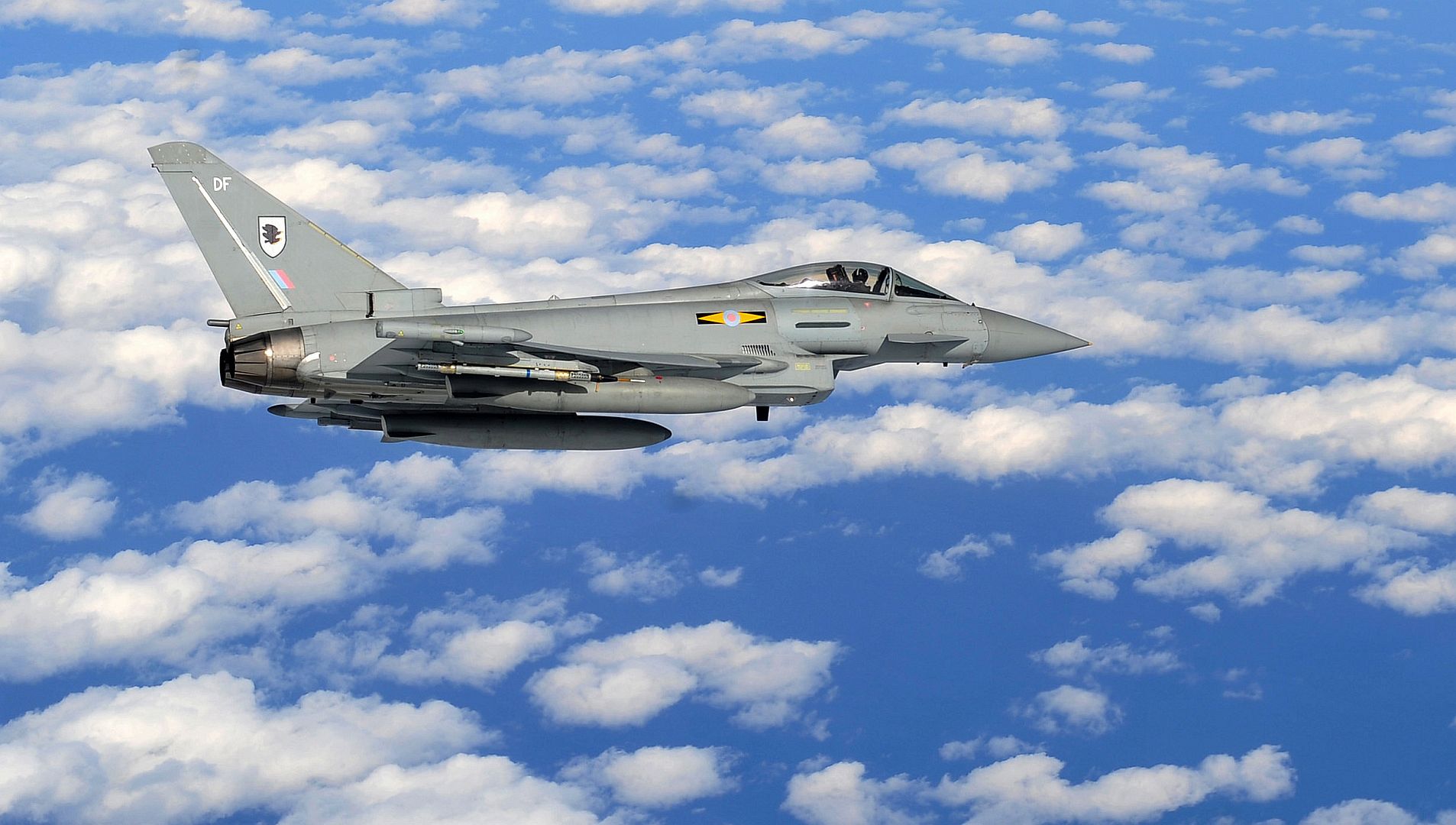
-
 Main AdminA Royal Danish Air Force F-16C awaits his turn to receive fuel next to a KC-135 Stratotanker, McGuire Air Force Base N.J., over Finland, May 24, 2019. The aircraft are supporting Arctic Challenge Exercise 19, a Nordic aviation exercise intended to provide scenario-based training to prepare partner forces for enemy defensive systems. (U.S. Air National Guard photo by Staff Sgt. Kenneth Shaner Brown)
Main AdminA Royal Danish Air Force F-16C awaits his turn to receive fuel next to a KC-135 Stratotanker, McGuire Air Force Base N.J., over Finland, May 24, 2019. The aircraft are supporting Arctic Challenge Exercise 19, a Nordic aviation exercise intended to provide scenario-based training to prepare partner forces for enemy defensive systems. (U.S. Air National Guard photo by Staff Sgt. Kenneth Shaner Brown)
Royal Danish Air Force F-16C and F-16D exit refueling from the KC-135 Stratotanker, McGuire Air Force Base N.J., over Finland, May 24, 2019. The aircraft are supporting Arctic Challenge Exercise 19, a Nordic aviation exercise intended to provide scenario-based training to prepare partner forces for enemy defensive systems. (U.S. Air National Guard photo by Staff Sgt. Kenneth Shaner Brown)
Capt. Andrew ?Dojo? Olson, F-35A Lightning II Demonstration Team pilot, performs over Miami Beach, Fla., May 24, 2019. Olson performed the demo in preparation for the Miami Beach Air and Sea Show. (U.S. Air Force photo's by Staff Sgt. Jensen Stidham)

Capt. Andrew ?Dojo? Olson, F-35A Lightning II Demonstration Team pilot, performs over Miami Beach, Fla., May 26, 2019. Olson performed the demo during both days of the Miami Beach Air and Sea Show. (U.S. Air Force photo by Staff Sgt. Jensen Stidham)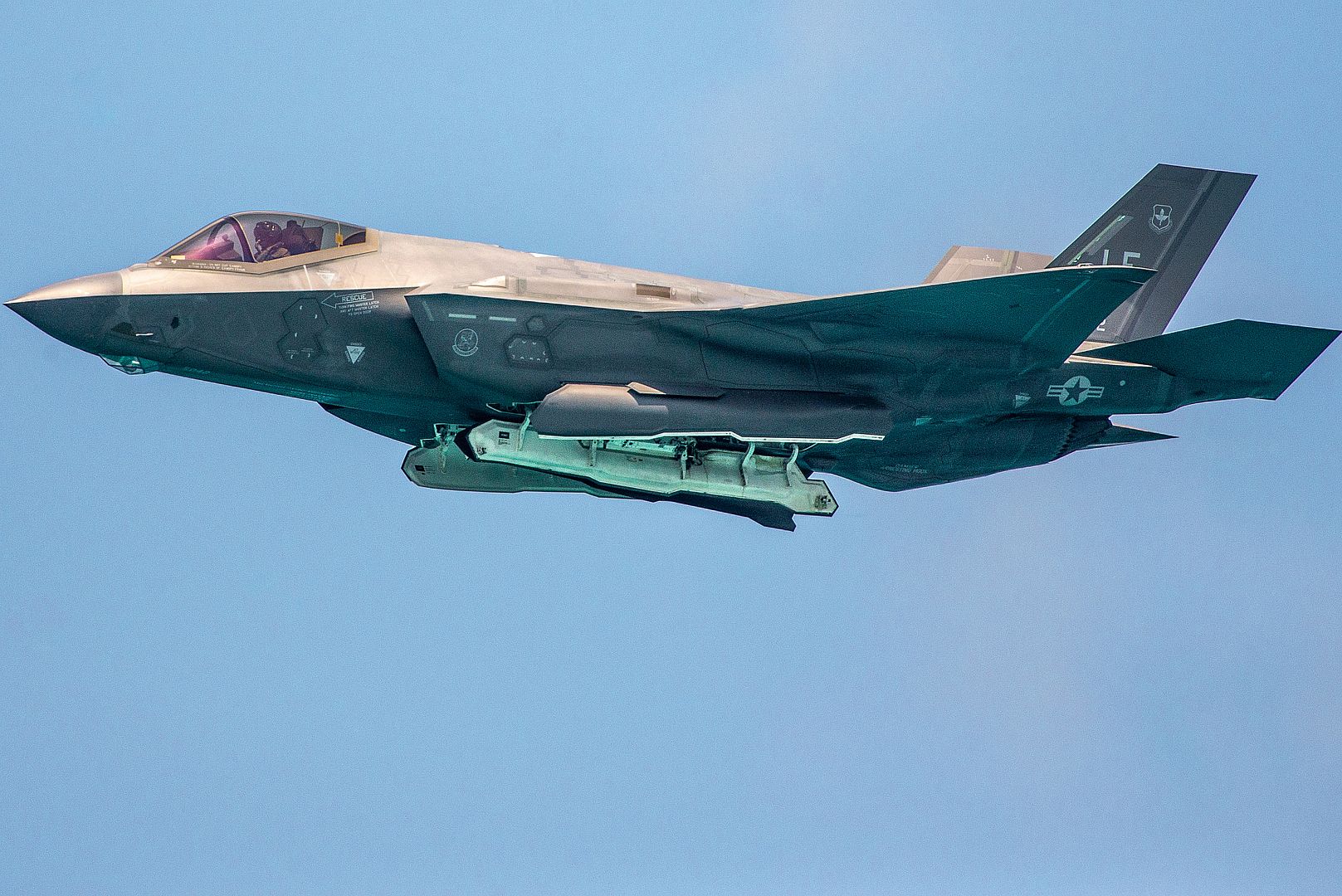
A P-51 Mustang performs over Miami Beach, Fla., May 25, 2019. The mustang performed during both days of the Miami Beach Air and Sea Show. (U.S. Air Force photo by Staff Sgt. Jensen Stidham)
The United States Air Force Air Demonstration Squadron "Thunderbirds" perform at the Bethpage Air Show in Long Island, New York, May 24, 2019. More than a quarter of a million spectators came to the beach throughout the weekend. (U.S. Air Force photo by Senior Airman Andrew D. Sarver)
Two Massachusetts Air National Guard F-15 Eagles join in formation alongside the wing of a New Jersey Air National Guard KC-135R Stratotanker on May 24, 2019 in support of Arctic Challenge Exercise 2019. ACE 19 is intended to provide scenario-based training to prepare partner forces for enemy defensive systems. (U.S. Air National Guard photo by Senior Airman Maria Rella).
ROYAL AUSTRALIAN AIR FORCE BASE DARWIN, Australia --
The California Air National Guard?s 194th Expeditionary Fighter Squadron, Fresno, California, teamed up with the several units from the Royal Australian Air Force (RAAF) to conduct bilateral training during Exercise Diamond Storm May 6-26, 2019.
Diamond Storm is an Australian Air Warfare Center-led exercise designed to enhance interoperability amongst allies and facilitate the introduction of fifth-generation capabilities into the Australian Defense Force.
?It's incredibly important to continue collaborating with one of our most trusted allies and show support in this part of the world,? said U.S. Air Force Lt. Col. David Allamandola, 194th EFS program manager. ?The Australians have created a phenomenal exercise that has increased both our levels of aptitude. Utilizing their unique airspace has highlighted different tactical problems we don't get to see on a regular basis. It's definitely a great opportunity to be with them, that we are privileged to participate in.?
This exercise, the last of a three-part series, also benefits as being a certifying criteria of the Air Warfare Instructor Course for the Australians.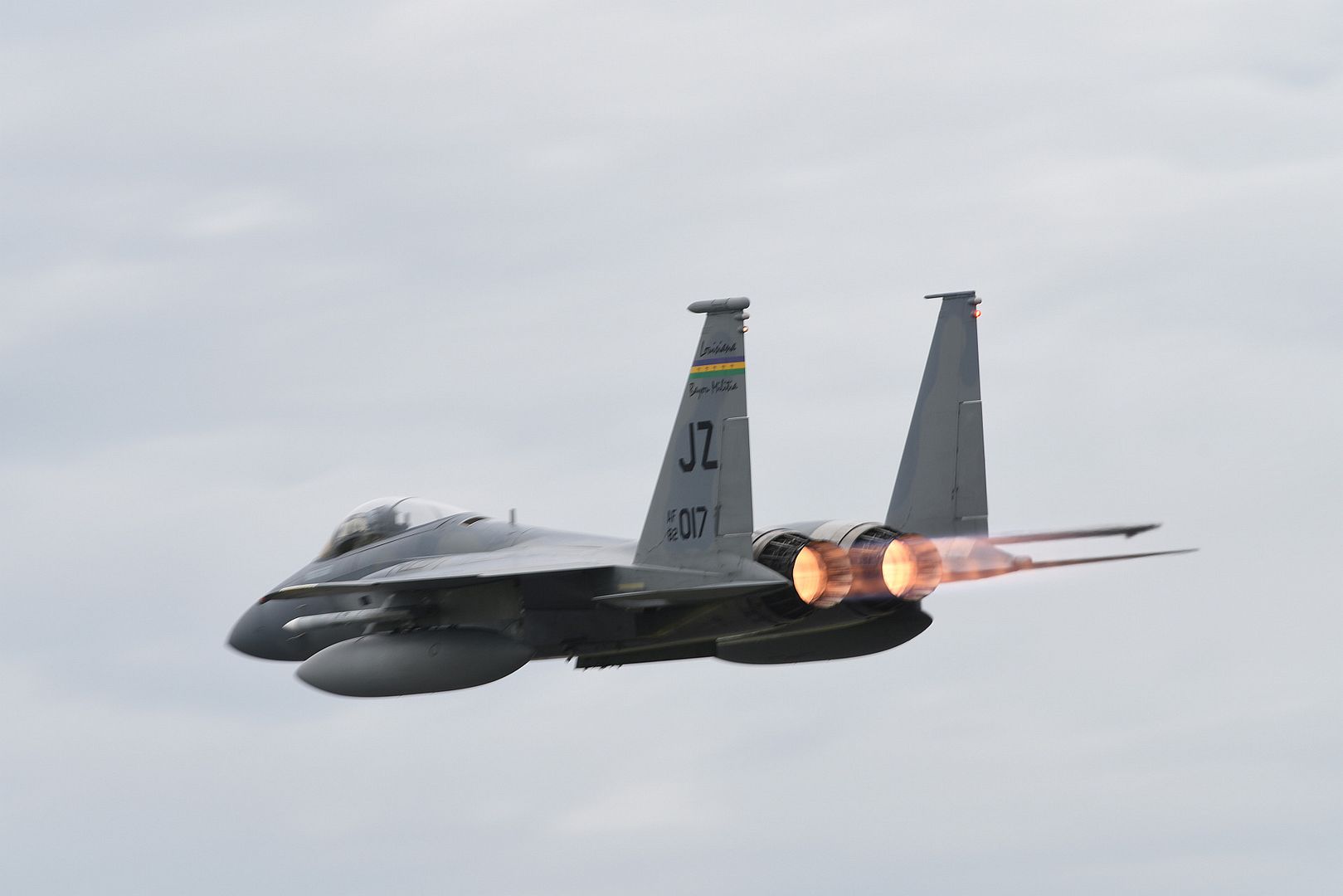
?This is one of the most intense courses the [Australian Defense Force] offers to its candidates,? said RAAF Wing Commander Scott Woodland, 2 Operational Conversion Unit commanding officer. ?We are taking highly skilled F-18 pilots and taking them to the next level. It?s been very challenging and very demanding with long hours, but ultimately, it gives great rewards.?
The U.S. Air Force and RAAF want to continue to build on the benefits of this exercise through the Enhanced Air Cooperation initiative and conduct more frequent training together.
?Being able to integrate as a force, understanding each other?s capabilities and limitations, and where we can utilize maximum effects with those capabilities is important,? said Woodland. ?Having the expertise that U.S. [Air Force] units bring to the fold also help develop our candidates as well.?
The aim for the increase of training opportunities between the U.S. Air Force and RAAF is to aid in future integration efforts.
Aircrew from the 23rd Expeditionary Bomb Squadron (EBS) prepare to board a U.S. Air Force B-52H Stratofortress at Andersen Air Force Base, Guam, May 15, 2019. 23rd EBS Airmen and aircraft participated in exercise Northern Edge 2019, a joint training exercise that prepares U.S. military personnel to respond to crises in the Indo-Pacific region. (U.S. Air Force photo by Senior Airman Ryan Brooks)
AUCKLAND, New Zealand, May 26, 2019 /PRNewswire/ -- Boeing [NYSE:BA] and Air New Zealand today announced the airline plans to add the largest 787 Dreamliner model to its world-class fleet with a commitment to buy eight 787-10 airplanes valued at $2.7 billion at list prices. The carrier, known for its global network and long-range operations, says the 787-10 complements its current 787-9 and 777 fleet by offering more seats and greater efficiency to grow its business.
"This is a hugely important decision for our airline. With the 787-10 offering around 15 percent more space for both customers and cargo than the 787-9, this investment creates the platform for our future strategic direction and opens up new opportunities to grow," said Air New Zealand Chief Executive Officer Christopher Luxon. "The 787-10 is longer and even more fuel efficient. However, the game changer for us has been that by working closely with Boeing, we've ensured the 787-10 will meet our network needs, including the ability to fly missions similar to our current 777-200 fleet."
The 787-10 is the largest member of the super-efficient and passenger-pleasing Dreamliner family. At 224 feet long (68 meters), the 787-10 can serve up to 330 passengers in a standard two-class configuration, about 40 more than the 787-9 airplane. Powered by a suite of new technologies and a revolutionary design, the 787-10 set a new benchmark for fuel efficiency and operating economics when it entered commercial service last year. The airplane allows operators to achieve 25 percent better fuel efficiency per seat compared to the previous airplanes.
"Air New Zealand is one of the world's leading long-haul carriers that has built an amazing network to connect the South Pacific with Asia and the Americas. We are honored that Air New Zealand has chosen to grow its future with the 787-10, the most efficient widebody airplane flying the skies today," said Ihssane Mounir, senior vice president of Commercial Sales and Marketing, The Boeing Company. "With the 777 and now the 787-9 and 787-10, Air New Zealand will have an incredible widebody family to serve its passengers and grow its international network in the years ahead."
Air New Zealand was a global launch customer for the 787-9 and today operates 13 of the Dreamliner variant. With another 787-9 on the way and the 787-10 airplanes in the future, the airline's Dreamliner fleet will grow to 22. Air New Zealand's widebody fleet also includes seven 777-300ERs and eight 777-200ERs, which it is progressively replacing with the aircraft order announced today.
As part of its efforts to maintain an efficient and reliable fleet, Air New Zealand utilizes a number of Boeing Global Services solutions, including Airplane Health Management. This digital solution applies analytics to real-time airplane data, providing maintenance data and decision support tools that enable aircraft maintenance teams to increase operational efficiency.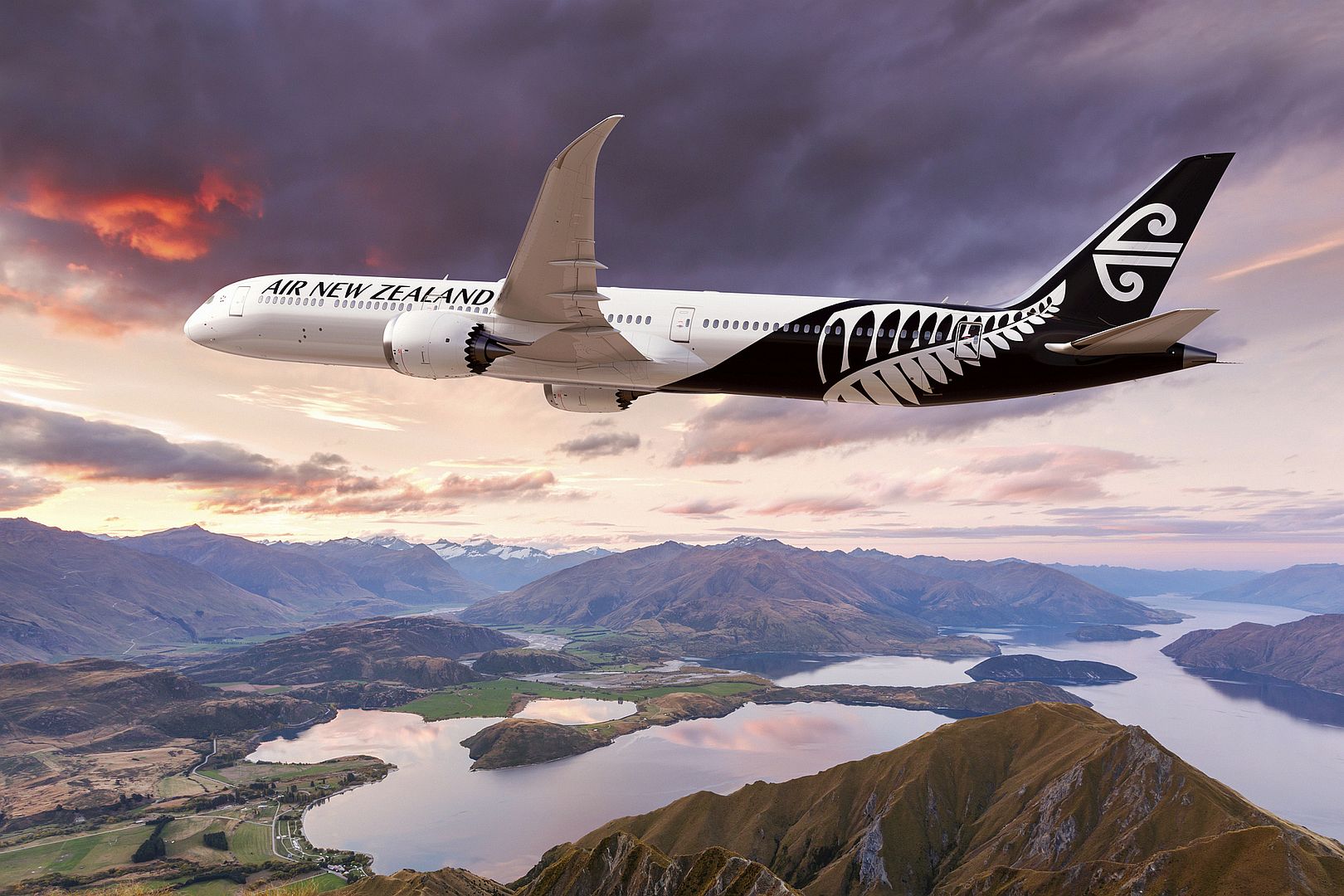
Marignane ? The French Minister of the Armed Forces, Florence Parly, has announced that the launch of the Joint Light Helicopter (H?licopt?re Interarm?es L?ger; HIL) programme has been brought forward to 2021. The HIL programme, for which the Airbus Helicopters? H160 was selected in 2017, was initially scheduled for launch in 2022 by the current military budget law. Launching the programme earlier will enable delivery of the first H160Ms to the French Armed Forces to be advanced to 2026.
During a visit to the Airbus Helicopters headquarters, the Minister also revealed the full-scale mock-up of the H160M that will be presented on the Ministry of the Armed Forces stand at the next Paris Air Show. The helicopter was also given its official name and will be designated as ?Gu?pard? (?Cheetah?) by the French Armed Forces.
The H160 was designed to be a modular helicopter, enabling its military version, with a single platform, to perform missions ranging from commando infiltration to air intercept, fire support, and anti-ship warfare in order to meet the needs of the army, the navy and the air force through the HIL programme.
?We are proud that the HIL is considered a strategic programme. I would like to thank the Ministry, the French Defence Procurement Agency DGA and the armed forces for their trust and for the close collaboration which helped create the conditions for the programme to be brought forward within the framework of the current military budget law. This will make it possible to speed up the replacement of the older generation of aircraft, while optimising the support and availability of the French State?s helicopter fleet,? said Bruno Even, CEO of Airbus Helicopters. ?Our teams are committed to delivering an aircraft in 2026 that meets the needs of the French armed forces in terms of availability, performance and capability, thus enabling it to rapidly become the new benchmark on the world?s medium-lift military helicopter market.?
Built around a platform that will enter service next year, the HIL programme will benefit from many of the advantages inherent in the civil H160, particularly in terms of support, with simplified maintenance and lower operating costs than the previous generation of helicopters in this category.
-
 Main AdminU.S. Air Force F-16C Block 52 Fighting Falcons assigned to the Air National Guard?s 169th Fighter Wing from McEntire Joint National Guard Base, S.C., taxi for flight operations in support of Arctic Challenge Exercise 2019 at Kallax Air Base, Lule?, Sweden, May 27, 2019. ACE 19 is a Nordic aviation exercise that provides realistic, scenario-based training to prepare forces for enemy defensive systems. U.S. forces are engaged, postured and ready to deter and defend in an increasingly complex security environment. (U.S. Navy Photo's by Chief Mass Communication Specialist John M. Hageman)
Main AdminU.S. Air Force F-16C Block 52 Fighting Falcons assigned to the Air National Guard?s 169th Fighter Wing from McEntire Joint National Guard Base, S.C., taxi for flight operations in support of Arctic Challenge Exercise 2019 at Kallax Air Base, Lule?, Sweden, May 27, 2019. ACE 19 is a Nordic aviation exercise that provides realistic, scenario-based training to prepare forces for enemy defensive systems. U.S. forces are engaged, postured and ready to deter and defend in an increasingly complex security environment. (U.S. Navy Photo's by Chief Mass Communication Specialist John M. Hageman)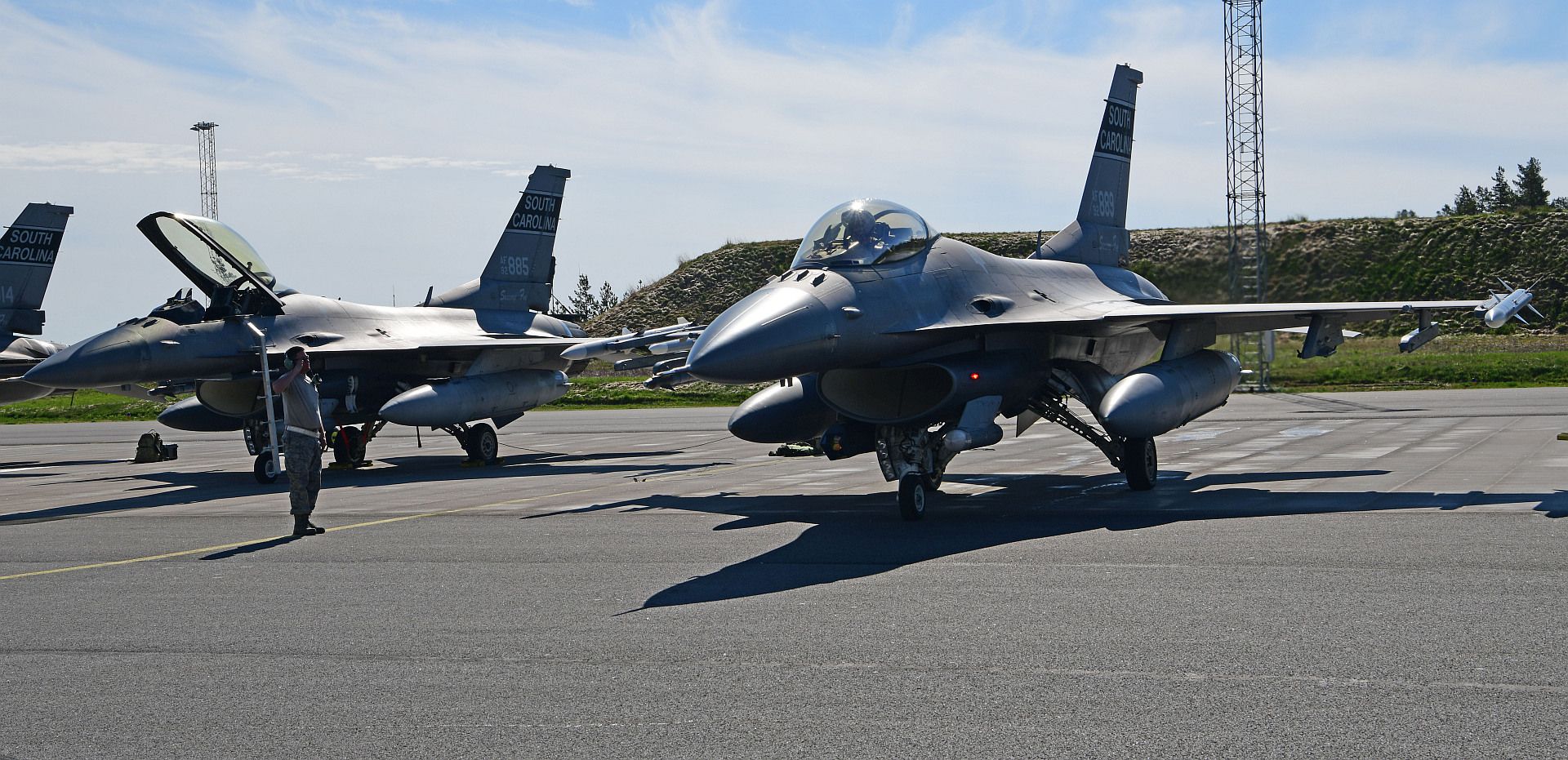
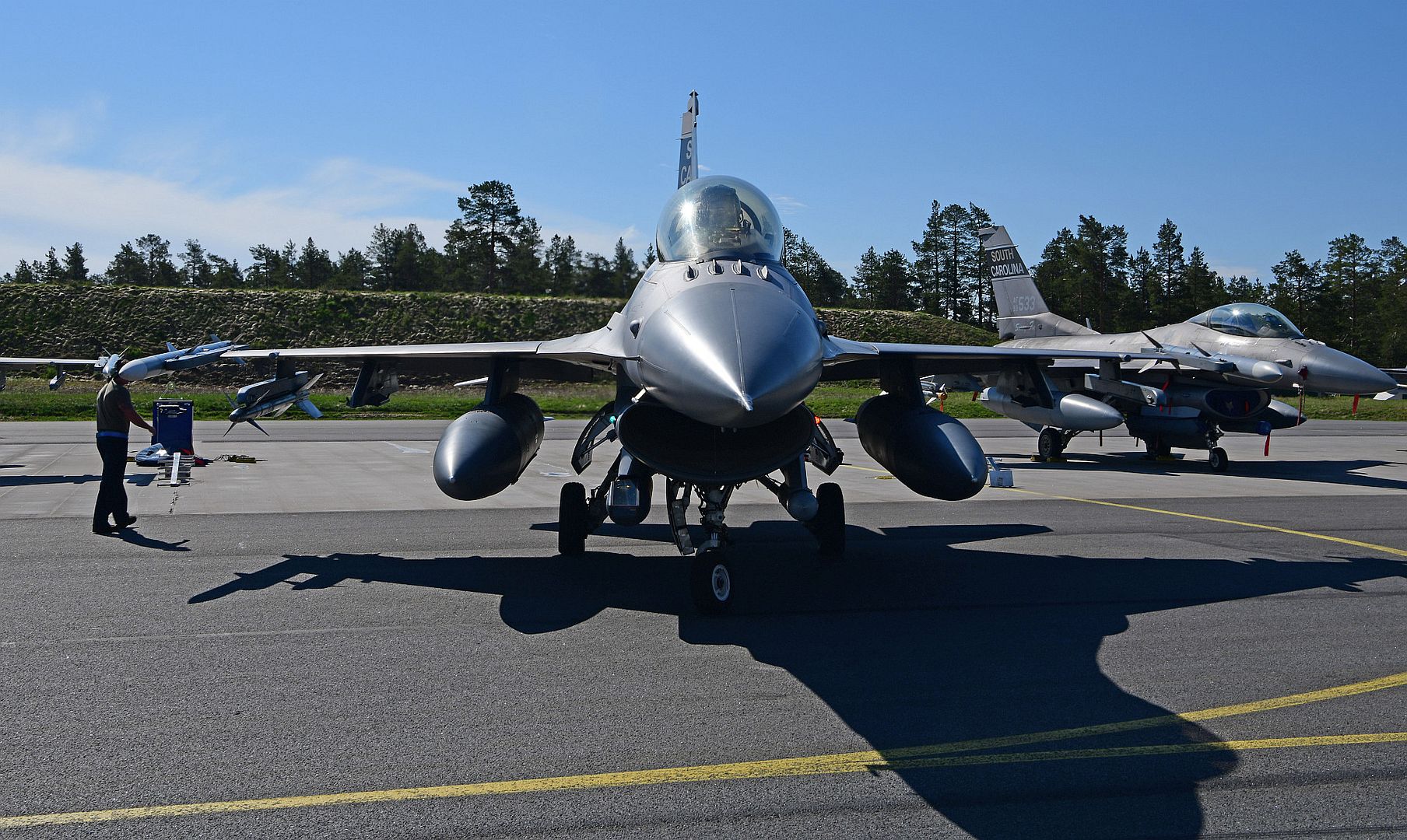
U.S. Air Force F-16 maintainers and pilots assigned to the Air National Guard?s 169th Fighter Wing from McEntire Joint National Guard Base, S.C., begin morning aircraft launch operations during week two in support of Arctic Challenge Exercise 2019 at Kallax Air Base, Lule?, Sweden, May 27, 2019. ACE 19 is a Nordic aviation exercise that provides realistic, scenario-based training to prepare forces for enemy defensive systems. U.S. forces are engaged, postured and ready to deter and defend in an increasingly complex security environment. (U.S. Air National Guard photo's by Senior Master Sgt. Edward Snyder)

PACIFIC OCEAN (May 27, 2019) AV-8B Harriers with Marine Medium Tiltrotor Squadron (VMM) 163 (Reinforced), 11th Marine Expeditionary Unit (MEU), are staged aboard the amphibious assault ship USS Boxer (LHD 4). The Marines and Sailors of the 11th MEU are deployed to the U.S. 7th Fleet area of operations to support regional stability, reassure partners and allies, and maintain a presence postured to respond to any crisis ranging from humanitarian assistance to contingency operations. (U.S. Marine Corps photo by Lance Cpl. Dalton S. Swanbeck)
An airworthy FM-2 Wildcat on display at the Military Aviation Museum in Virginia Beach, Virginia. The museum, located just minutes from NAS Oceana, features a plethora of vintage WWI and WWII aircraft; with many in flying condition. (US Navy Photo by Max Lonzanida/Released)
-
 Main AdminPACIFIC OCEAN (May 29, 2019) An AV-8B Harrier with Marine Medium Tiltrotor Squadron (VMM) 163 (Reinforced), 11th Marine Expeditionary Unit (MEU), lands during flight operations on board the amphibious assault ship USS Boxer (LHD 4). The Marines and Sailors of the 11th MEU are deployed to the U.S. 7th Fleet area of operations to support regional stability, reassure partners and allies, and maintain a presence postured to respond to any crisis ranging from humanitarian assistance to contingency operations (U.S. Marine Corps photo by Lance Cpl. Dalton S. Swanbeck)
Main AdminPACIFIC OCEAN (May 29, 2019) An AV-8B Harrier with Marine Medium Tiltrotor Squadron (VMM) 163 (Reinforced), 11th Marine Expeditionary Unit (MEU), lands during flight operations on board the amphibious assault ship USS Boxer (LHD 4). The Marines and Sailors of the 11th MEU are deployed to the U.S. 7th Fleet area of operations to support regional stability, reassure partners and allies, and maintain a presence postured to respond to any crisis ranging from humanitarian assistance to contingency operations (U.S. Marine Corps photo by Lance Cpl. Dalton S. Swanbeck)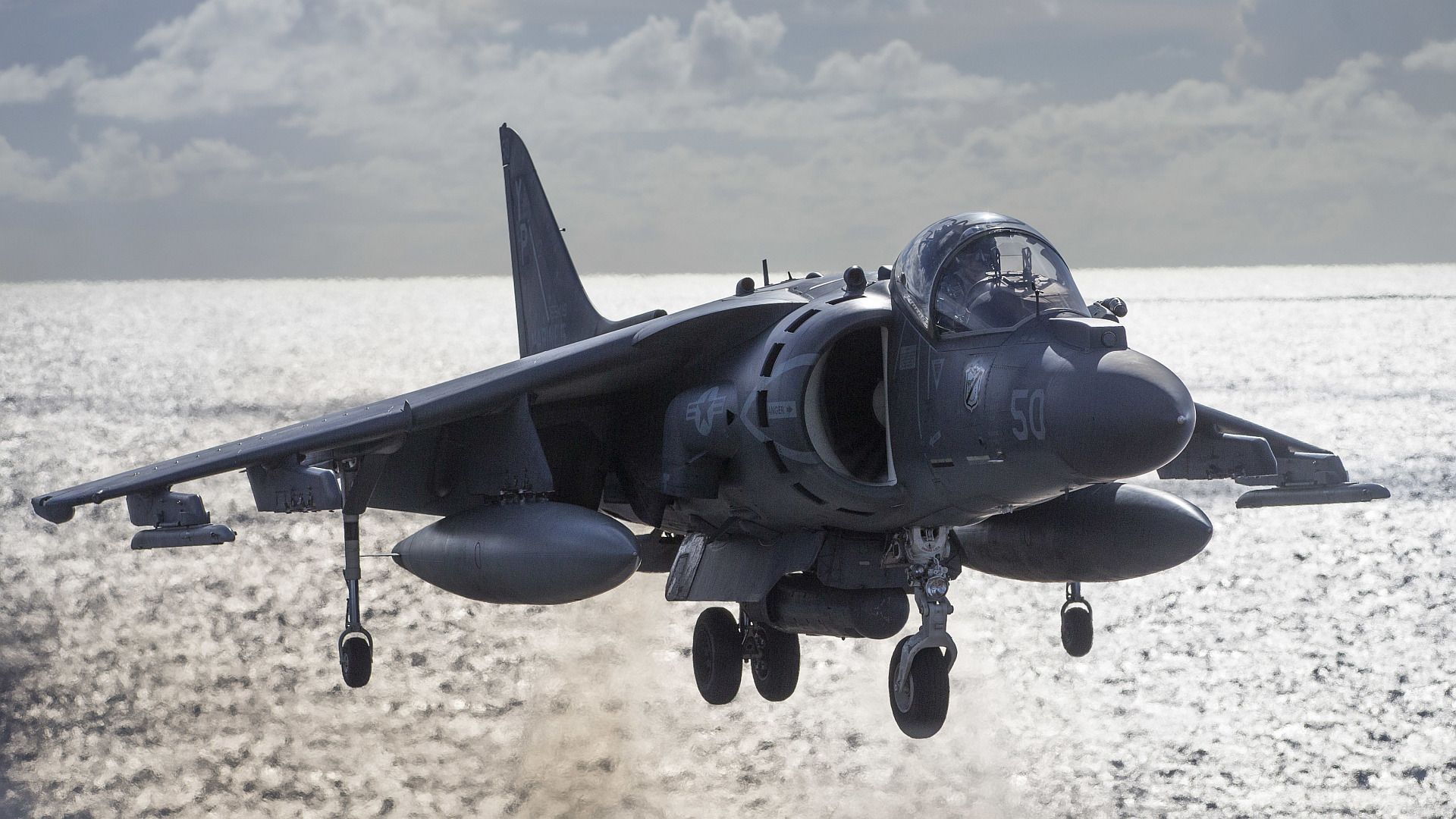
PACIFIC OCEAN (May 29, 2019) An AV-8B Harrier with Marine Medium Tiltrotor Squadron (VMM) 163 (Reinforced), 11th Marine Expeditionary Unit (MEU), takes off during flight operations on board the amphibious assault ship USS Boxer (LHD 4). The Marines and Sailors of the 11th MEU are deployed to the U.S. 7th Fleet area of operations to support regional stability, reassure partners and allies, and maintain a presence postured to respond to any crisis ranging from humanitarian assistance to contingency operations (U.S. Marine Corps photo by Lance Cpl. Dalton S. Swanbeck)
PACIFIC OCEAN (May 29, 2019) A U.S. Marine pilot with Marine Medium Tiltrotor Squadron (VMM) 163 (Reinforced), 11th Marine Expeditionary Unit (MEU), parks an AV-8B Harrier during flight operations aboard the amphibious assault ship USS Boxer (LHD 4). The Marines and Sailors of the 11th MEU are deployed to the U.S. 7th Fleet area of operations to support regional stability, reassure partners and allies, and maintain a presence postured to respond to any crisis ranging from humanitarian assistance to contingency operations (U.S. Marine Corps photo by Lance Cpl. Dalton S. Swanbeck)
A Swedish Air Force JAS 39 Gripen taxies prior to flight operations during Arctic Challenge Exercise 2019 at Kallax Air Base, Lule?, Sweden, May 28, 2019. ACE 19 is a Nordic aviation exercise that provides realistic, scenario-based training to prepare forces for enemy defensive systems. U.S. forces are engaged, postured and ready to deter and defend in an increasingly complex security environment. (U.S. Navy Photo by Chief Mass Communication Specialist John M. Hageman)
Royal Air Force Typhoon FGR4's taxi after flight operations in support of Arctic Challenge Exercise 2019 at Kallax Air Base, Lule?, Sweden, May 29, 2019. ACE 19 is a Nordic aviation exercise that provides realistic, scenario-based training to prepare forces for enemy defensive systems. U.S. forces are engaged, postured and ready to deter and defend in an increasingly complex security environment. (U.S. Navy Photo's by Chief Mass Communication Specialist John M. Hageman)


A Royal Air Force C-130J Hercules taxis after flight operations in support of Arctic Challenge Exercise 2019 at Kallax Air Base, Lule?, Sweden, May 29, 2019. ACE 19 is a Nordic aviation exercise that provides realistic, scenario-based training to prepare forces for enemy defensive systems. U.S. forces are engaged, postured and ready to deter and defend in an increasingly complex security environment. (U.S. Navy Photo by Chief Mass Communication Specialist John M. Hageman)
U.S. Air Force F-16C Block 52 Fighting Falcons assigned to the Air National Guard?s 169th Fighter Wing from McEntire Joint National Guard Base, S.C., taxi after flight operations in support of Arctic Challenge Exercise 2019 at Kallax Air Base, Lule?, Sweden, May 29, 2019. ACE 19 is a Nordic aviation exercise that provides realistic, scenario-based training to prepare forces for enemy defensive systems. U.S. forces are engaged, postured and ready to deter and defend in an increasingly complex security environment. (U.S. Navy Photo's by Chief Mass Communication Specialist John M. Hageman)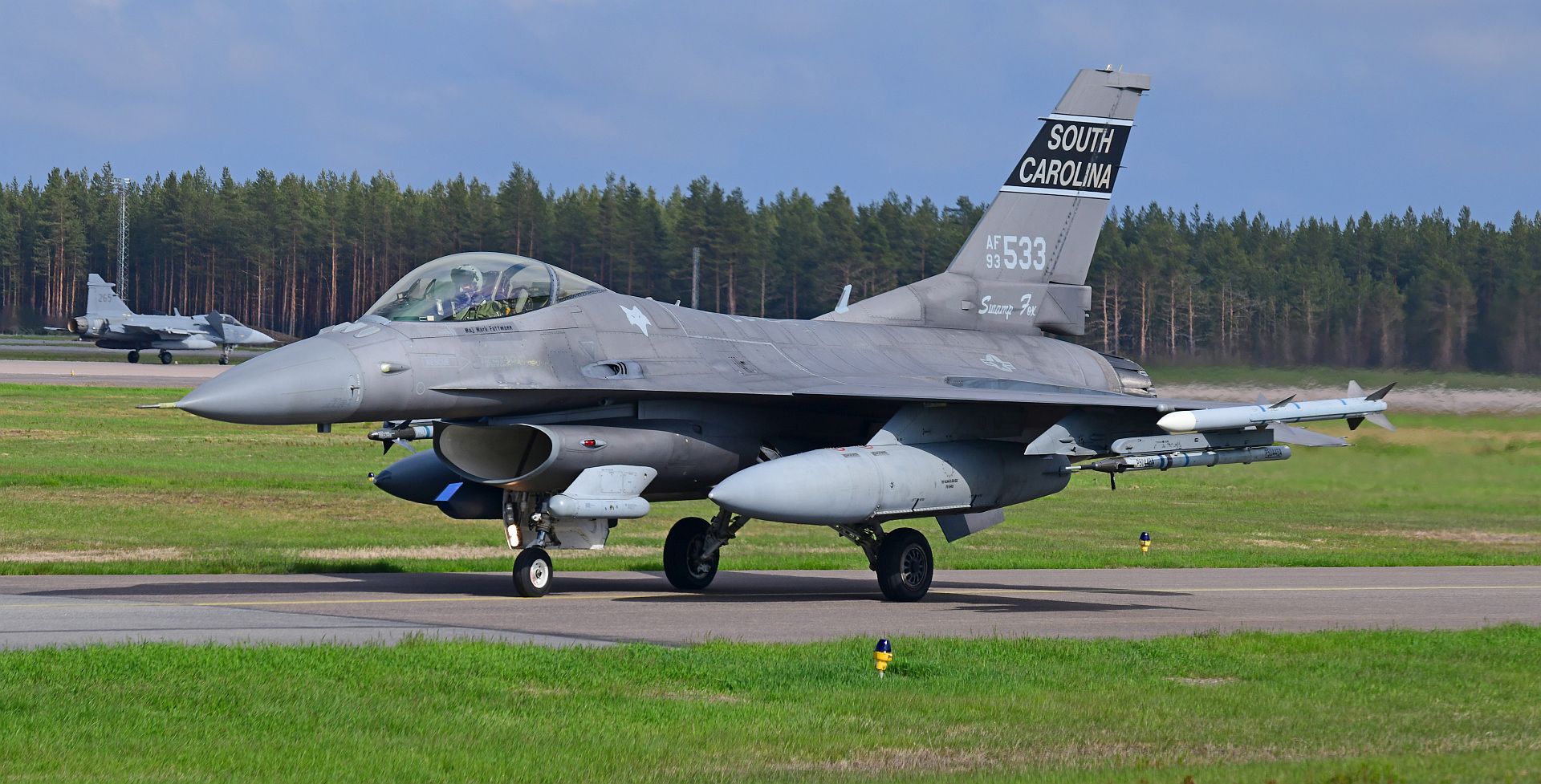
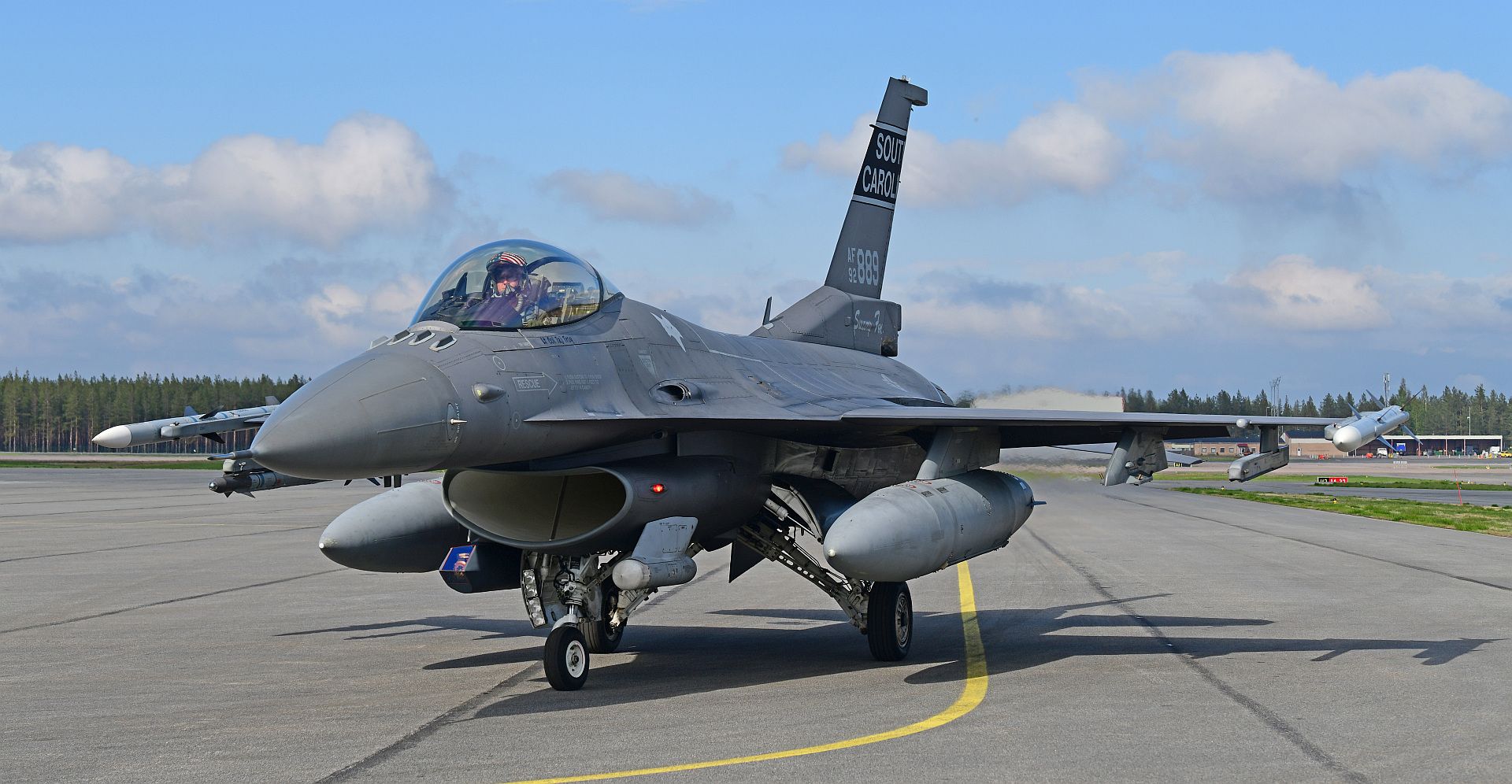
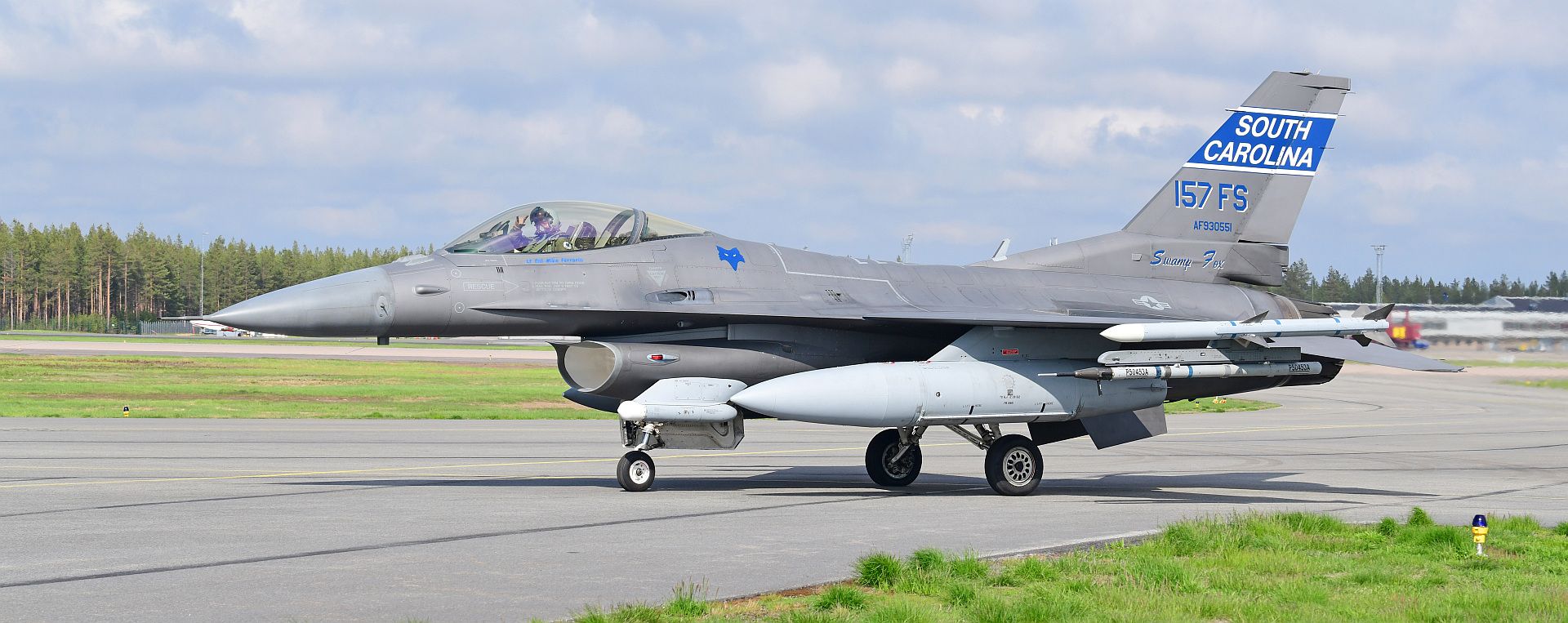
Scat VII, a P-51 Mustang once flown by triple-ace fighter pilot Robin Olds, flies over Spangdahlem Air Base, Germany, May 28, 2019. The plane is the last one Olds flew before the end of WWII and has been restored several times over the years. He scored a total of 12 air-to-air kills during WWII and an additional four during the Vietnam War. (U.S. Air Force photo's by Master Sgt. Roidan Carlson)


Swedish Air Force JAS 39 Gripen's prepare to take off during a distinguised visitors day for leaders of partner countries participating in Arctic Challenge Exercise 2019 at Kallax Air Base, Lule?, Sweden, May 28, 2019. ACE 19 is a Nordic aviation exercise that provides realistic, scenario-based training to prepare forces for enemy defensive systems. Interoperability and combined training during exercises like ACE 19 enhances professional relationships and improves overall coordination with allies and partner militaries. (U.S. Air National Guard photo's by Senior Master Sgt. Edward Snyder)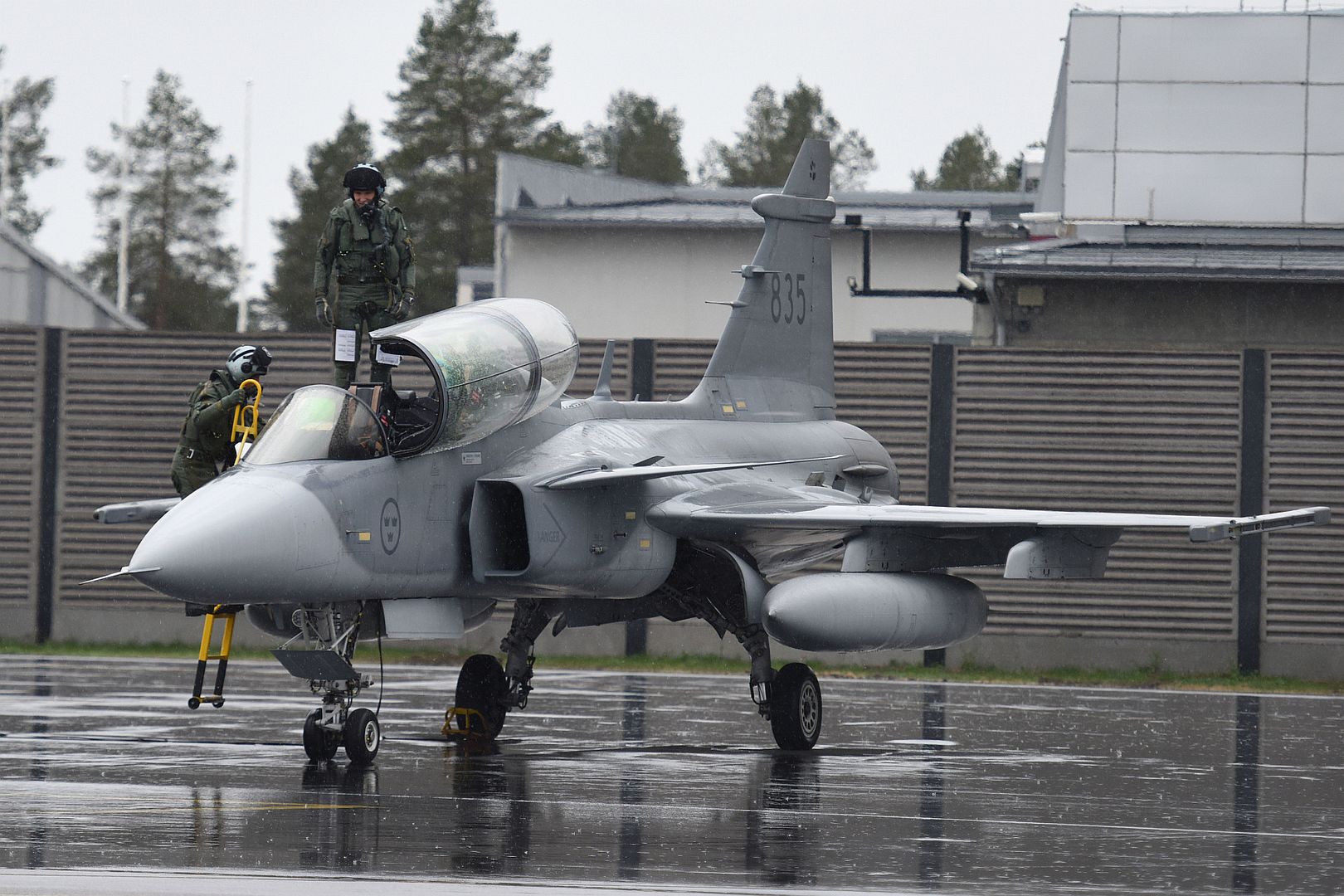
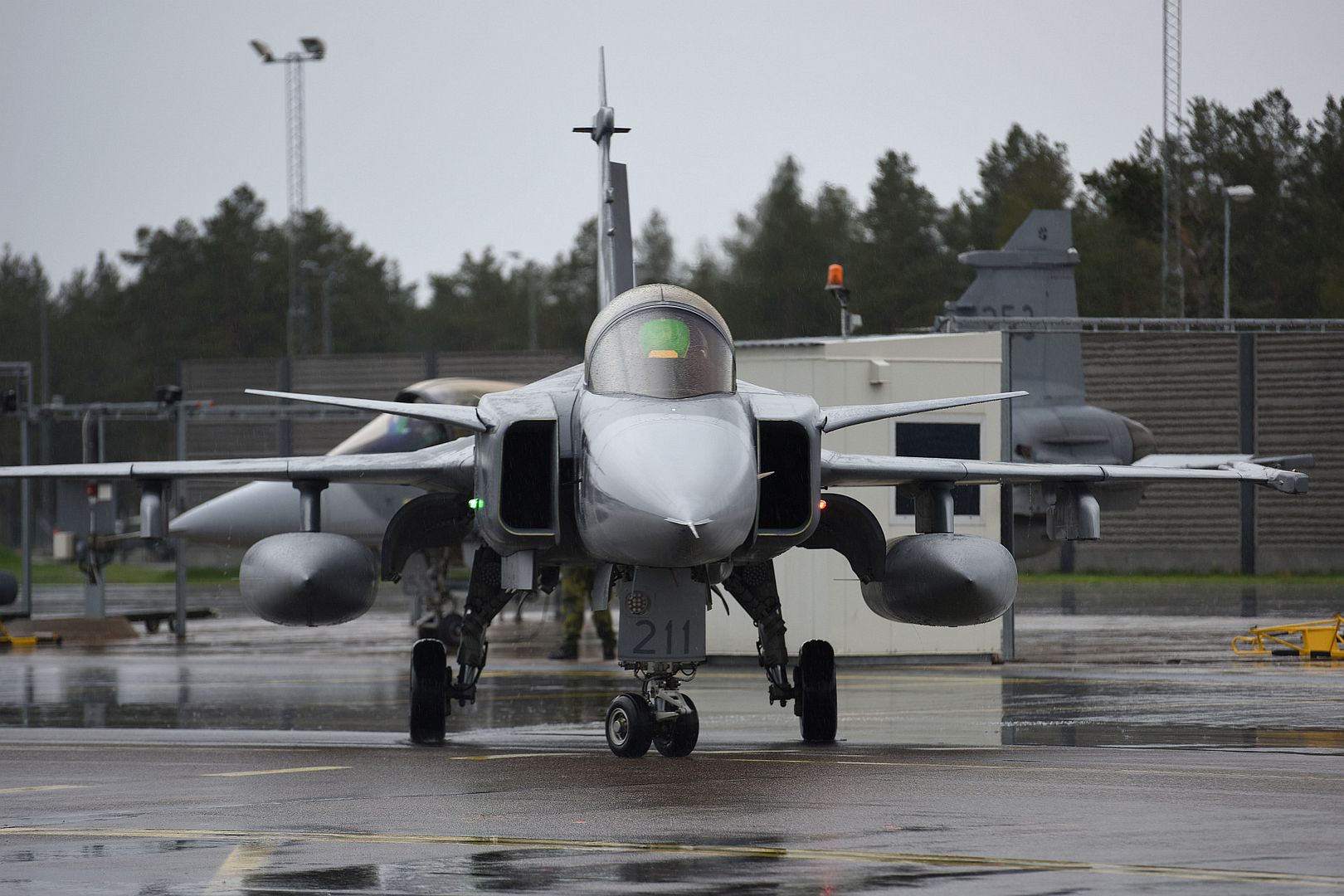
A MiG-17F performs a flyover during the Twilight Show at Barksdale Air Force Base, La., May 17, 2019. The Twilight Show allowed air and ground crews to practice processes and procedures a day before the Defenders of Liberty Air & Space Show. (U.S. Air Force photo by Staff Sgt. Damon Kasberg)
PACIFIC OCEAN (May 26, 2019) An AV-8B Harrier II attached to Marine Medium Tiltrotor Squadron (VMM) 163 sits on the flight deck of the amphibious assault ship USS Boxer (LHD 4) during flight operations. The Boxer Amphibious Ready Group (ARG) and 11th Marine Expeditionary Unit (MEU) are deployed to the U.S. 7th Fleet area of operations to support regional stability, reassure partners and allies, and maintain a presence to respond to any crisis ranging from humanitarian assistance to contingency operations. (U.S. Navy photo by Mass Communication Specialist 3rd Class Alexander C. Kubitza/Released)
-
 Main AdminHILL AIR FORCE BASE, Utah (AFNS) --
Main AdminHILL AIR FORCE BASE, Utah (AFNS) --
The 34th Fighter Squadron and 34th Aircraft Maintenance Unit will transition F-35A Lightning II operations to Mountain Home Air Force Base, Idaho, as the runway at Hill AFB closes for construction.
More than 250 Airmen from the active duty 388th and Reserve 419th Fighter Wings and up to 24 aircraft will make the trip over a two-month period.
Hill AFB?s runway is undergoing a $43.6-million repair and expansion. The unit will continue flying there until the current phase of runway construction is complete, which is scheduled for early August.
While at Mountain Home AFB, the squadron will conduct normal operations, as well as participate in exercises and integrate with other Air Force units.
They are scheduled to fly every weekday that is not a holiday or scheduled down day. The majority of the flying will take place around the base and the range complex with no flying projected near Boise, Idaho, or its surrounding areas.
The 34th FS also operated out of Mountain Home in June 2016 during a mock deployment used to gauge readiness prior to the Air Force declaring initial operational capability for the F-35A.
The 34th FS departs as the 4th FS is deployed to the Middle East and the 421st FS is deployed to Europe. This is the first time all three squadrons have been gone since the wing received the F-35A in 2015.
The 388th and 419th FW are the Air Force?s only combat-capable F-35 units, maintaining the jets in a total force partnership that utilizes the strengths of both components.
(U.S. Air Force photo by Staff Sgt. Andrew Lee)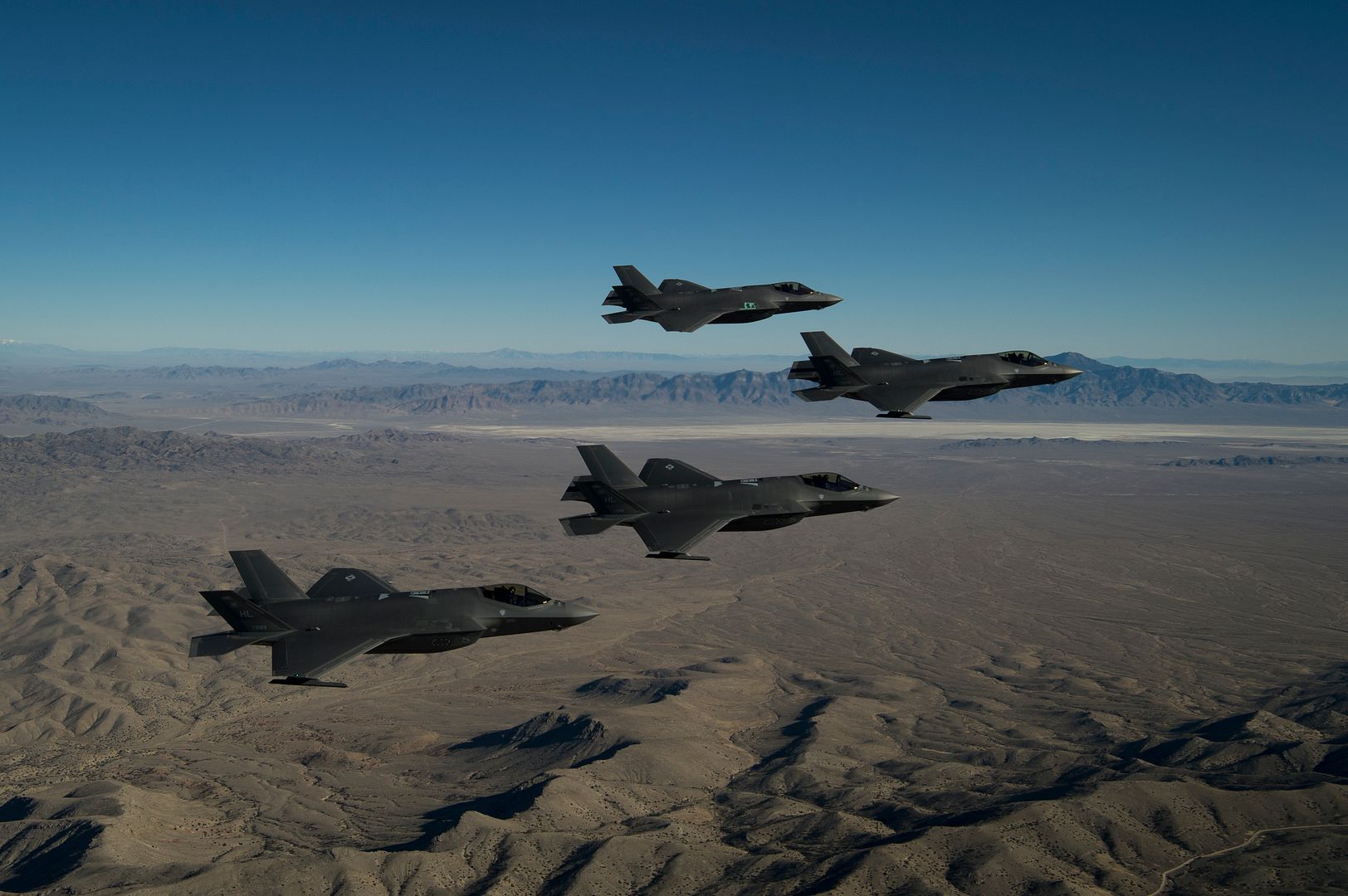
Two United Arab Emirates Air Force F-16 Desert Falcons prepare to fly in formation with U.S. F-35A Lightning IIs in the U.S. Central Command area of responsibility, May 29, 2019. The flight was conducted for U.S. forces to continue building military-to-military relationships and interoperability with the UAE. (U.S. Air Force photo by Staff Sgt. Chris Drzazgowski)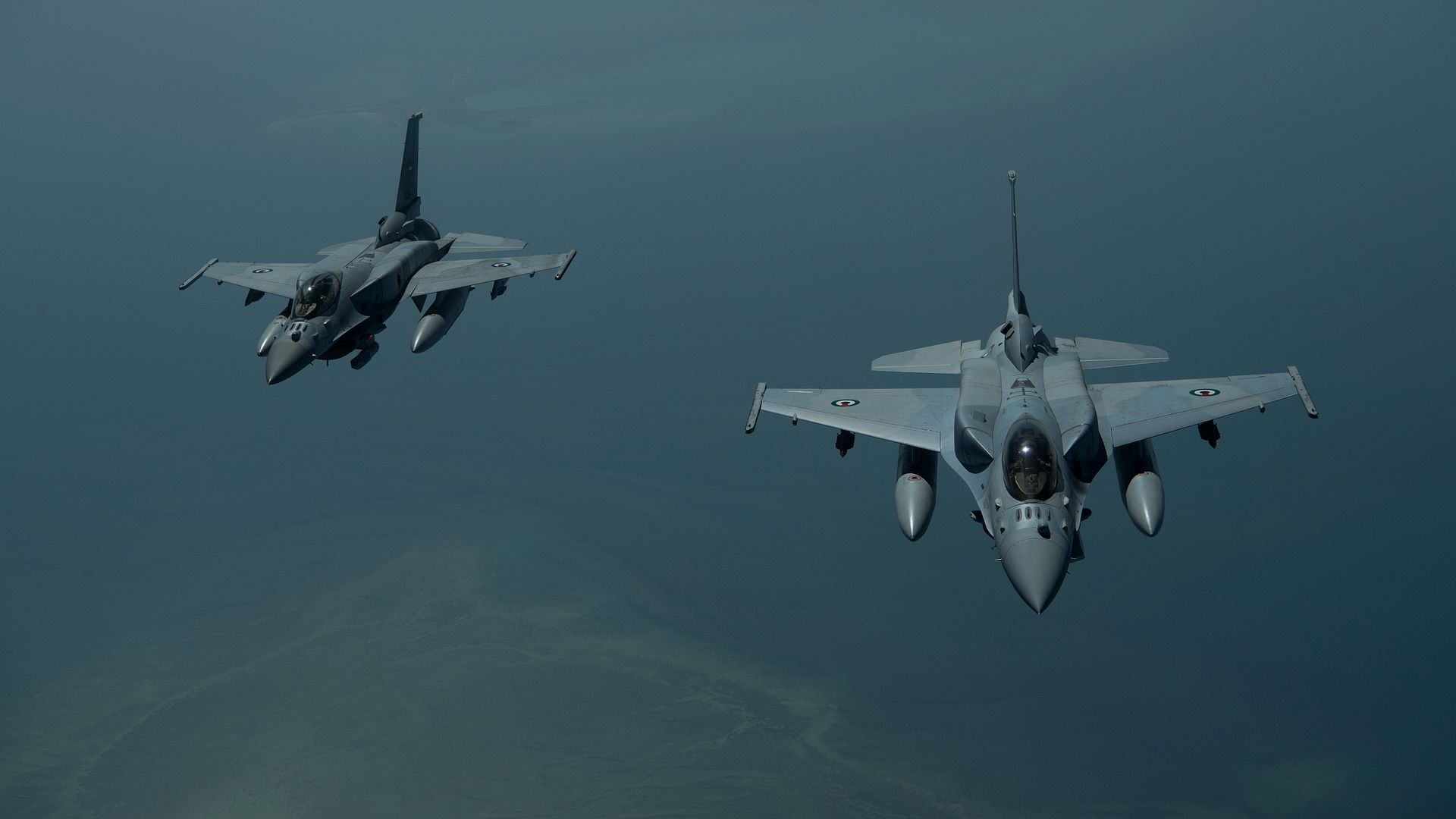
United Arab Emirates Air Force Mirage 2000s fly a partnering flight with U.S. F-35A Lightning IIs in the U.S. Central Command area of responsibility, May 29, 2019. The flight was conducted to continue building military-to-military relationships and interoperability with the UAE. (U.S. Air Force photo by Staff Sgt. Chris Drzazgowski)
ARABIAN SEA (May 29, 2019) An EA-18G Growler from the "Patriots" of Electronic Attack Squadron (VAQ) 140 flies above the Nimitz-class aircraft carrier USS Abraham Lincoln (CVN 72). Abraham Lincoln Carrier Strike Group is deployed to the U.S. 5th Fleet area of operations in support of naval operations to ensure maritime stability and security in the Central Region, connecting the Mediterranean and the Pacific through the western Indian Ocean and three strategic choke points. With Abraham Lincoln as the flagship, deployed strike group assets include staffs, ships and aircraft of Carrier Strike Group 12 (CSG 12), Destroyer Squadron 2 (DESRON 2), USS Leyte Gulf (CG 55) and Carrier Air Wing 7 (CVW 7). (U.S. Navy photo by Mass Communication Specialist 3rd Class Amber Smalley/Released)
SCAT VII, a P-51 Mustang, displayed in Hangar One before a presentation at Spangdahlem Air Base, Germany, May 28, 2019. The aircraft, once flown by late U.S. Air Force Brig. Gen. Robin Olds, is named SCAT VII and was the last aircraft he flew in World War II. (U.S. Air Force photo by Staff Sgt. Preston Cherry)
An F-35A Lightning II fighter jet takes off May 30, 2019, at Aviano Air Base, Italy as part of a Theater Security Package deployment. A Theater Security Package underscores U.S. commitment to working alongside our partners and allies to bolster collective defense and security capabilities. (U.S. Air Force photo by Tech. Sgt. Jim Araos)
A U.S. Air Force RC-135 Rivet Joint receives fuel from a KC-135 Stratotanker during a mission within the U.S. Air Force Central Command Area of Responsibility May 26, 2019. The Rivet Joint supports theater and national level consumers with near real time on-screen intelligence collection, analysis and dissemination capabilities. (U.S. Air Force photo by Master Sgt. Russ Scalf)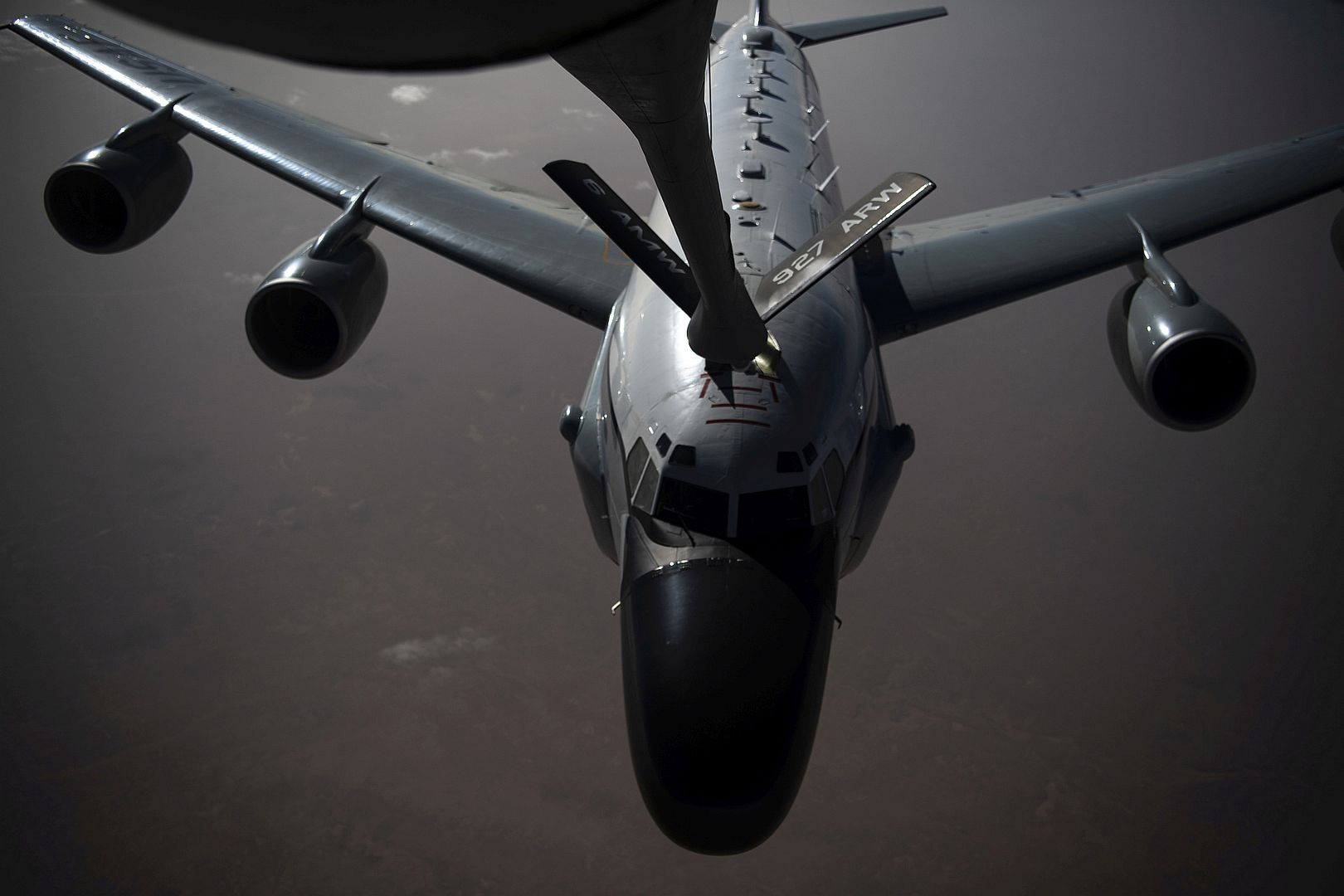
TOKYO ? May 31, 2019 ? Northrop Grumman Corporation (NYSE: NOC) completed its first delivery of an E-2D Advanced Hawkeye to the Japanese Air Self-Defense Force (JASDF) on March 29.
In November 2014, the Japan Ministry of Defense competitively selected the Northrop Grumman E-2D to fulfill an emerging next-generation airborne early warning requirement.
?Northrop Grumman?s longstanding partnership with Japan is beginning a new chapter with the delivery of the first Japan E-2D,? said Jane Bishop, vice president and integrated product team leader, manned airborne surveillance programs, Northrop Grumman. ?This aircraft provides a significant increase in early warning and surveillance capability to outpace Japan?s evolving security needs.?
Japan has operated the Northrop Grumman E-2C Hawkeye since 1983 and is the largest E-2 operator outside the U.S. The E-2D delivers a two-generation leap in radar technology, allowing the aircraft to track threats at extended range. The aircraft can also be used in a humanitarian assistance and disaster relief capacity for civilian emergency coordination. The E-2D offers interoperability with next-generation aircraft systems and U.S. Navy allies to support regional security cooperation. To ensure long-term success of the Japan E-2D fleet, Northrop Grumman is providing continued support to JASDF in the areas of sustainment and maintenance, in coordination with several Japanese firms.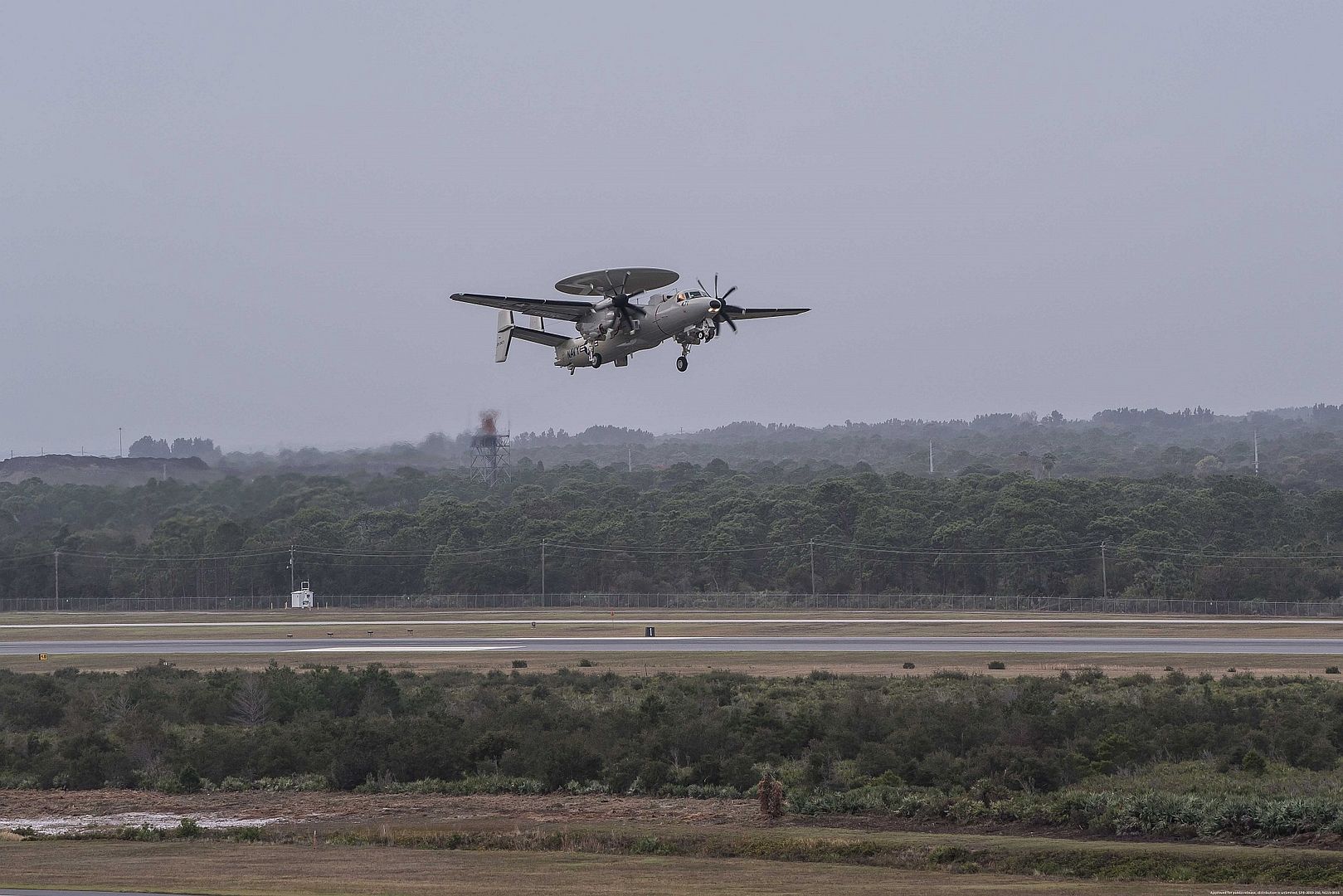
-
 Main AdminA Royal Air Force Typhoon FGR4 taxis after flight operations in support of Arctic Challenge Exercise 2019 at Kallax Air Base, Lule?, Sweden, May 30, 2019. ACE 19 is a Nordic aviation exercise that provides realistic, scenario-based training to prepare forces for enemy defensive systems. U.S. forces are engaged, postured and ready to deter and defend in an increasingly complex security environment. (U.S. Navy Photo's by Chief Mass Communication Specialist John M. Hageman)
Main AdminA Royal Air Force Typhoon FGR4 taxis after flight operations in support of Arctic Challenge Exercise 2019 at Kallax Air Base, Lule?, Sweden, May 30, 2019. ACE 19 is a Nordic aviation exercise that provides realistic, scenario-based training to prepare forces for enemy defensive systems. U.S. forces are engaged, postured and ready to deter and defend in an increasingly complex security environment. (U.S. Navy Photo's by Chief Mass Communication Specialist John M. Hageman)

U.S. Air Force F-16C Block 52 Fighting Falcons assigned to the Air National Guard?s 169th Fighter Wing from McEntire Joint National Guard Base, S.C., taxi after flight operations in support of Arctic Challenge Exercise 2019 at Kallax Air Base, Lule?, Sweden, May 30, 2019. ACE 19 is a Nordic aviation exercise that provides realistic, scenario-based training to prepare forces for enemy defensive systems. U.S. forces are engaged, postured and ready to deter and defend in an increasingly complex security environment. (U.S. Navy Photo's by Chief Mass Communication Specialist John M. Hageman)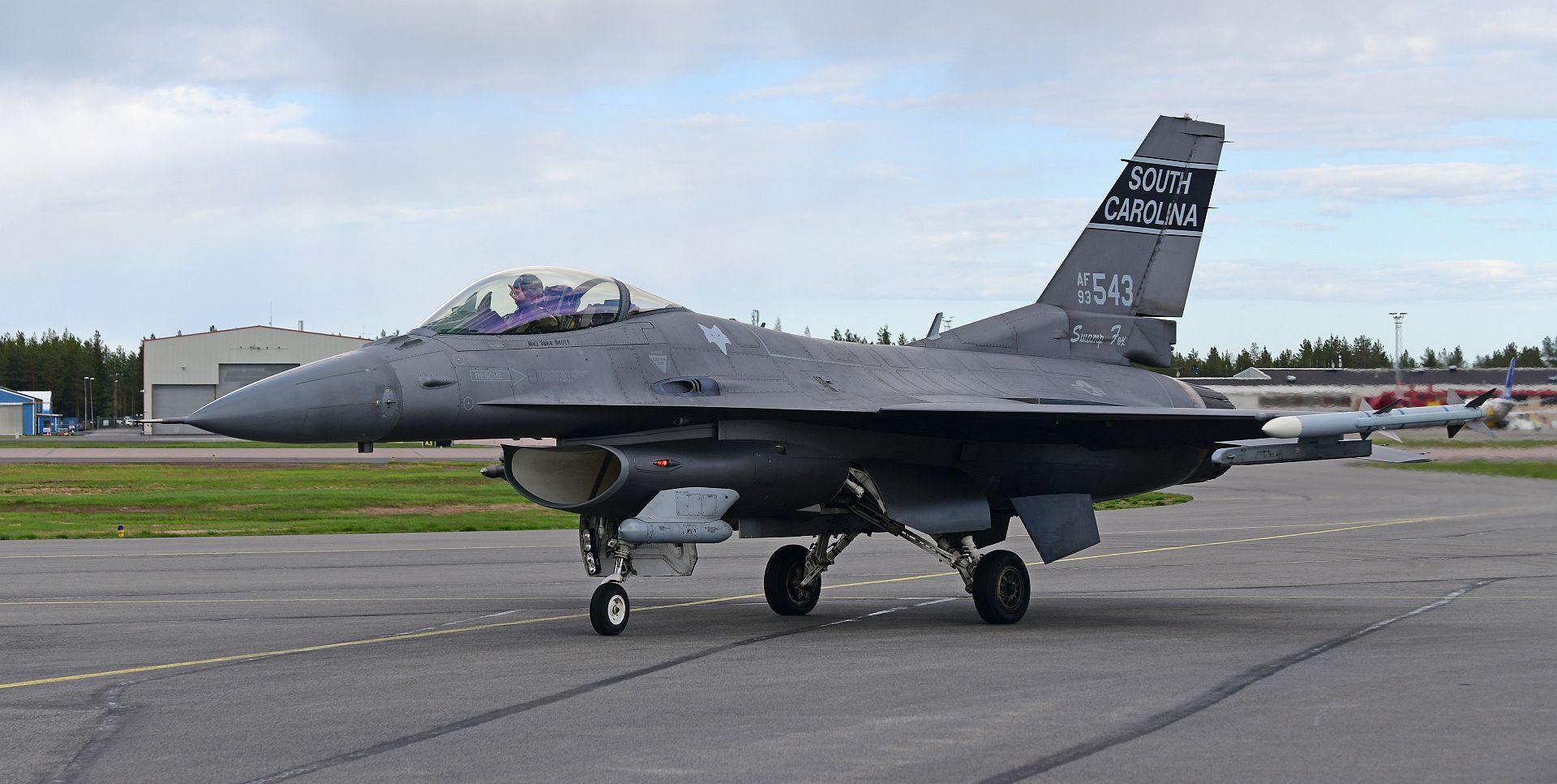

A Swedish Air Force JAS 39 Gripen taxis after flight operations in support of Arctic Challenge Exercise 2019 at Kallax Air Base, Lule?, Sweden, May 30, 2019. ACE 19 is a Nordic aviation exercise that provides realistic, scenario-based training to prepare forces for enemy defensive systems. U.S. forces are engaged, postured and ready to deter and defend in an increasingly complex security environment. (U.S. Navy Photo by Chief Mass Communication Specialist John M. Hageman)
Swedish Air Force JAS 39 Gripens commence flight operations in support of Arctic Challenge Exercise 2019 at Kallax Air Base, Lule?, Sweden, May 30, 2019. ACE 19 is a Nordic aviation exercise that provides realistic, scenario-based training to prepare forces for enemy defensive systems. U.S. forces are engaged, postured and ready to deter and defend in an increasingly complex security environment. (U.S. Navy Photo by Chief Mass Communication Specialist John M. Hageman)
A U.S. Air Force C-130J Super Hercules, assigned to the 37th Airlift Squadron at Ramstein Air Base, Germany, sits on the ramp of Cherbourg-Maupertus Airport, France, May 30, 2019. More than 100 Team Ramstein members arrived to support the 75th Anniversary of D-Day. Seventy-five years later, the bravery and heroism by all allies on D-Day continue to resonate with U.S. forces. (U.S. Air Force photo by Senior Airman Devin M. Rumbaugh)
An F-35A Lightning II from the 388th and 419th Fighter Wings, at Hill AFB, Utah, takes off at Aviano Air Base, Italy on May 31, 2019. The F-35 is in Italy for a Theater Security package. (U.S. Air Force photo by Airman 1st Class Caleb House)
An F-35A Lightning II fighter jet takes off May 31, 2019, at Aviano Air Base, Italy as part of a Theater Security Package deployment. A Theater Security Package underscores U.S. commitment to working alongside our partners and allies to bolster collective defense and security capabilities. (U.S. Air Force photo's by Tech. Sgt. Jim Araos)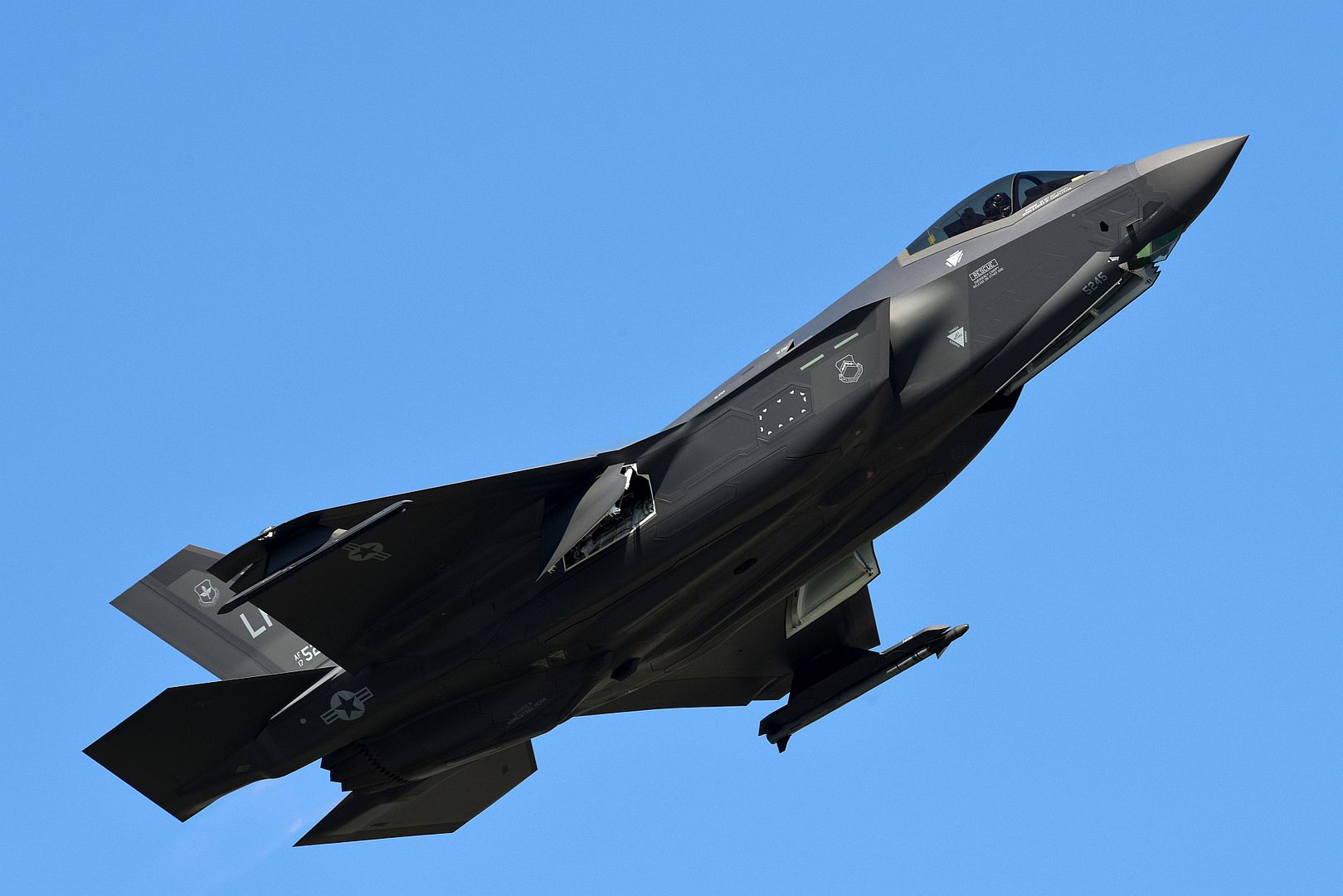
Change from C Series Aircraft Limited Partnership (CSALP) reflects Airbus? majority stake in the A220
The change of name of CSALP to Airbus Canada Limited Partnership, which was announced in March 2019, will come into effect on June 1, 2019.
The new name reflects the majority interest of Airbus in the partnership since July 1, 2018. The partnership is adopting the Airbus logo as its single visual identity.
Over the course of the coming weeks, the new name will be applied to the limited partnership?s documentation, materials and branded items. The Airbus and Bombardier logos will continue to be displayed side-by-side on the building exteriors in Mirabel, reflecting production activities on the site for both the Airbus A220 and Bombardier CRJ aircraft families.
About the limited partnership
Headquartered in Mirabel, Qu?bec, the limited partnership is responsible for the development and manufacturing of the Airbus A220 Family of single-aisle passenger aircraft. Majority owned by Airbus SE, partners include Bombardier Inc. and Investissement Qu?bec (acting as mandatory for the government of Qu?bec). The limited partnership employs approximately 2,200 at its headquarters and manufacturing facilities in Mirabel. The second A220 manufacturing facility in Mobile, Alabama will start production in the third quarter of 2019.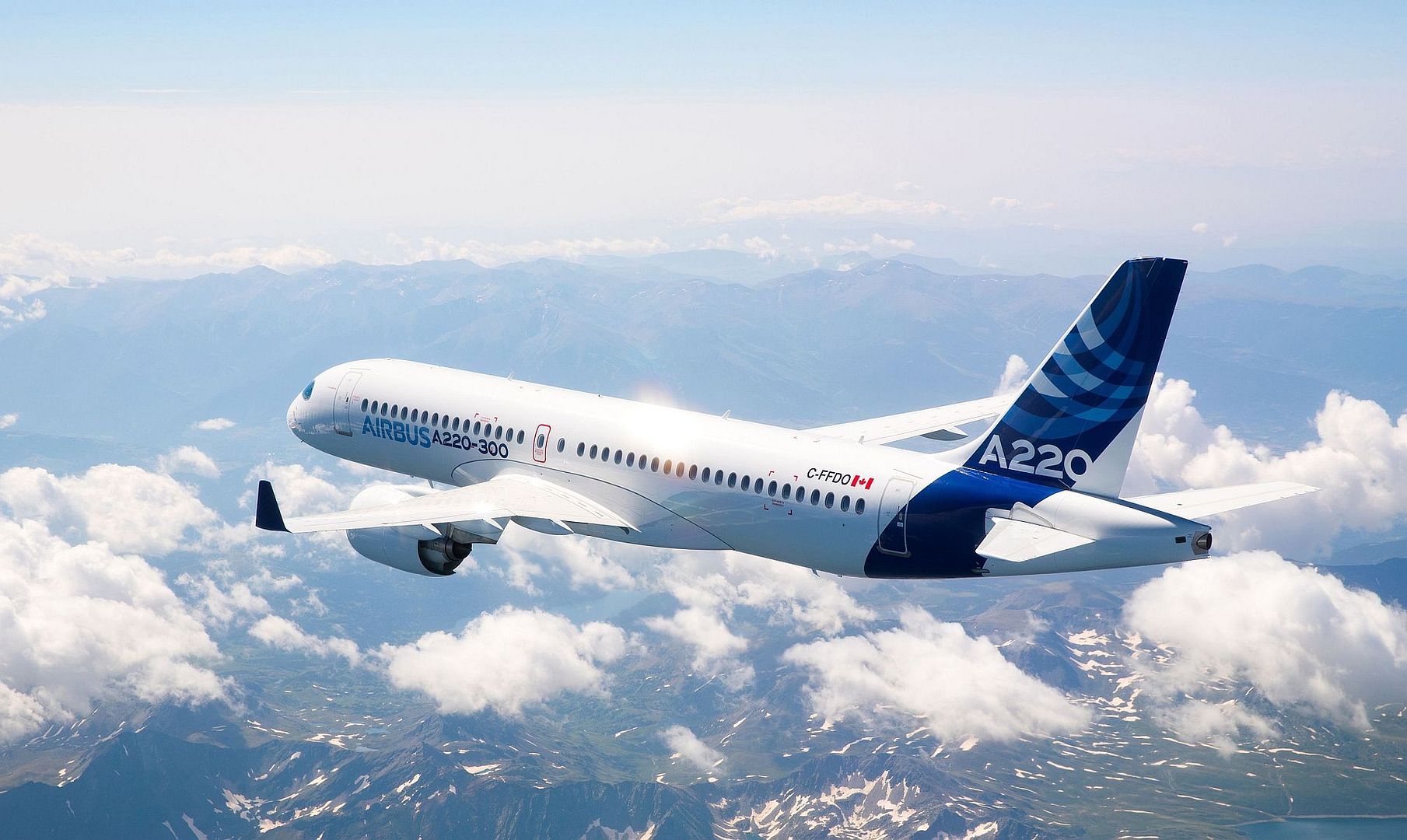
Post a reply
- Go to Previous topic
- Go to Next topic
- Go to Welcome
- Go to Introduce Yourself
- Go to General Discussion
- Go to Screenshots, Images and Videos
- Go to Off topic
- Go to Works in Progress
- Go to Skinning Tips / Tutorials
- Go to Skin Requests
- Go to IJAAF Library
- Go to Luftwaffe Library
- Go to RAF Library
- Go to USAAF / USN Library
- Go to Misc Library
- Go to The Ops Room
- Go to Made in Germany
- Go to Campaigns and Missions
- Go to Works in Progress
- Go to Juri's Air-Raid Shelter
- Go to Campaigns and Missions
- Go to Works in Progress
- Go to Skinpacks
- Go to External Projects Discussion
- Go to Books & Resources
